Compared to the Africa we'd seen, Mauritania is a whole different world. The drunk savanna gives way to barren sand dotted with thirsty grass, the villages resemble tented camps, and there are loads of camels hanging around. And the people are different - their skin is lighter and their dress is like nothing we'd seen elsewhere - especially men who wear boubou, a kind of garment that looks pretty impractical.
There is quite a bit of Arabian blood in Mauritanians, and not only is it visible in skin colour and faces, but also in religion and the way of life. The picture of men lying in the shade of a tent, sipping tea all day long while the muezzin sings his call to prayer through crackling of the loudspeakers of the village mosque (or maybe he's just lost his voice to the desert dust), is just so common. But unlike other Arabian nations, such as Oman or the United Arab Emirates, Mauritania is a poor country, and thus it isn't all about the thousand and one nights. Instead, goats roam the rubbish laden streets, and people's mindset feels a lot different - even suppressed. Maybe it is the reason why Al-Qaeda, responsible for a few tourist kidnappings already, has established itself here - isn't it that terrorist organisations manifest their presence the strongest in the countries that struggle with poverty, such as Pakistan or Yemen, for example?
The current travel advice concerning Mauritania suggests that one shouldn't go there unless absolutely necessary (or, for some areas, should not even consider going) - same as for Pakistan and Yemen. Therefore our journey through the country is, as expected, interrupted by countless checkpoints that invariably require us to present a "fiche" - a piece of paper that has all data on it, including our profession, names of our parents, and the registration of our vehicle. I guess it is for our own safety, so that should we disappear between two check points, they at least know where to start looking from. In any case it seems like a more sensible solution than escorting, which they did for a while just after the kidnappings took place, but not anymore. Either way, we'd done wise to prepare a bunch of fiches, because to get from the Mali border to Nouakchott alone we had to distribute some fourty of them (i.e. we passed through some fourty check points).
But the check points weren't the only worry on our way to the Mauritanian capital. Some 500 kilometers before, while we had stopped to take a snap of the landscape (which was quite stunning, by the way), Kariina brought to my attention that there is a smell of transmission oil in the air. A quick inspection revealed that transmission was fine, but the gearbox was leaking, and quite bad. But we were in the middle of nowhere, so we held our breath and somehow, adding some fresh oil bought from a roadside "boutique", we arrived in Nouakchott.

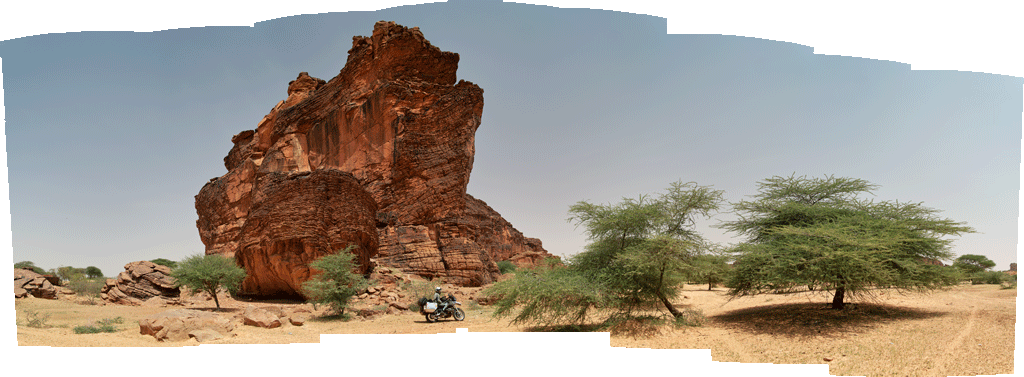




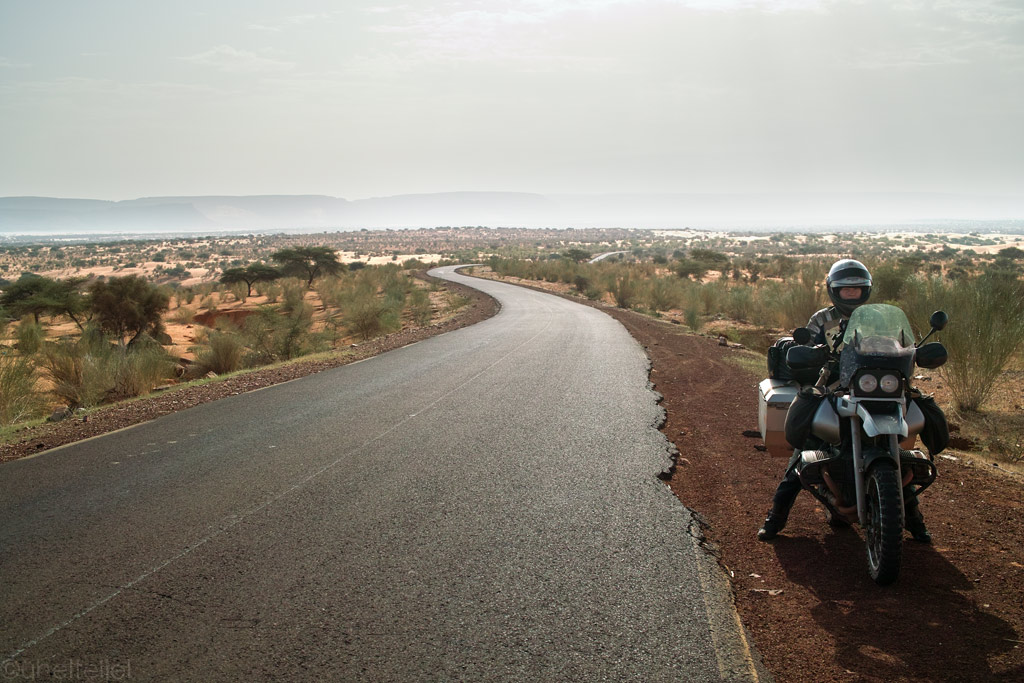
Excellent tar road through Mauritania - something we did not expect.
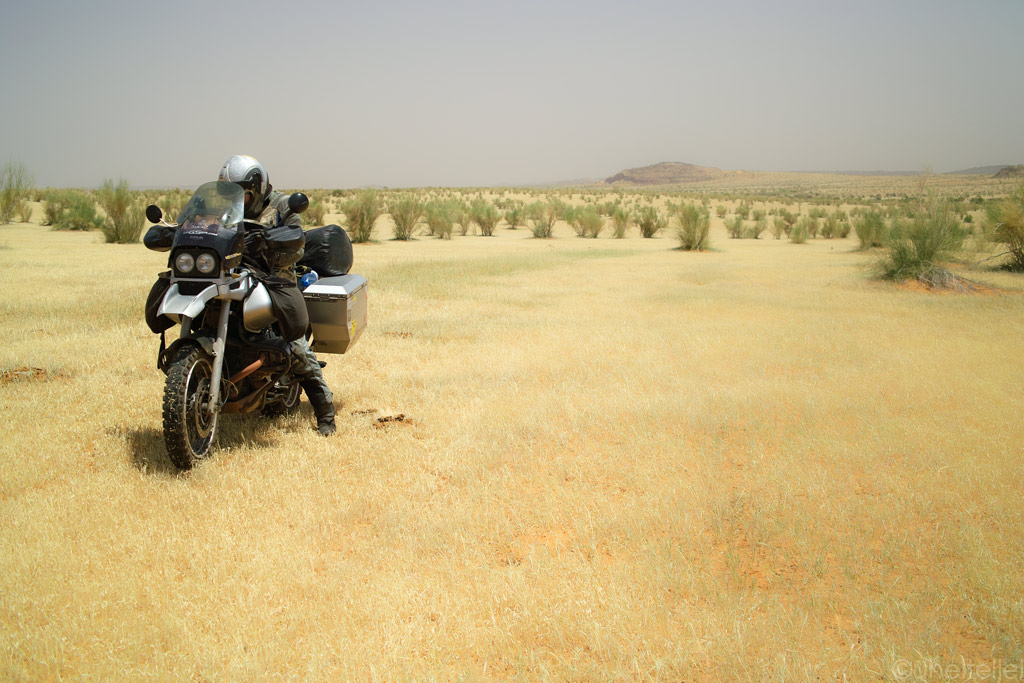
In the fields of Southern Mauritania.
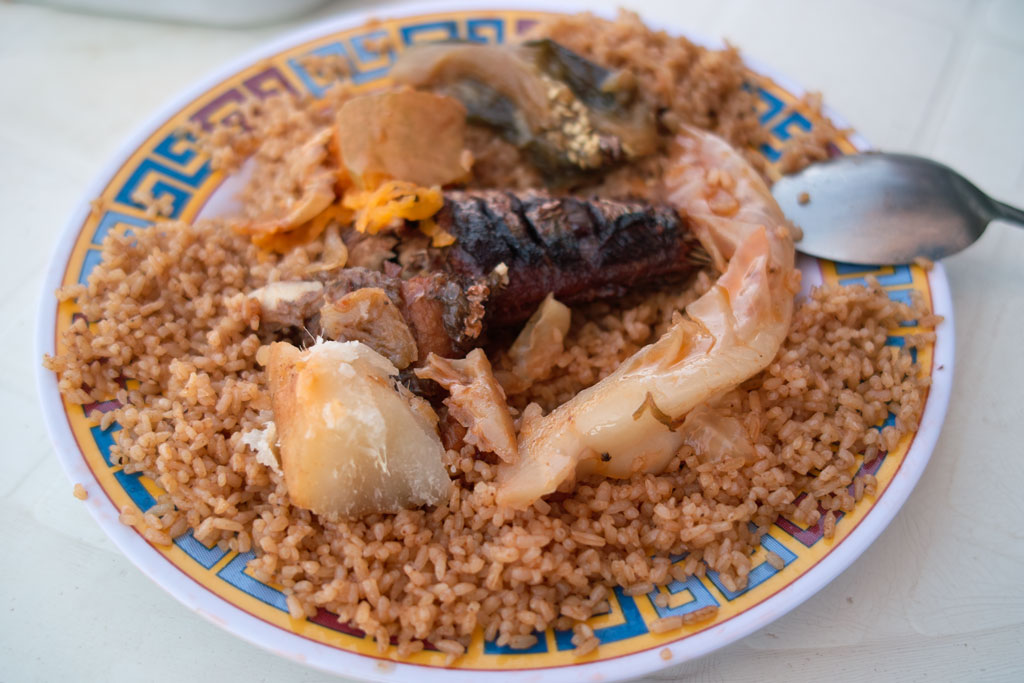
… and some local food which quite upset our stomachs - the conditions for preserving food are not quite good in the desert...
So, once we got to Nouakchott we had no choice but to take the bike apart in order to determine where all that oil had come from. It wasn't an easy task - not so much taking the bike apart, which we discovered was possible even with nothing more than the original tool kit that comes with the bike, but determining where the oil had come from… The first supect was the gearbox input shaft seal, which would have been an easy problem because to replace it one does not have to take the gearbox apart, and similar seals are also used on certain cars, so should be possible to find in a spare part shop even in Africa.
Full of optimism, we got the old one out, found ourselves a helper who'd take us around town to the relevant shops, and… well, the thing is, that in Nouakchott the "relevant shops" are virtually non-existent, so instead he took us to different mechanics who don't even have proper workshops, working on clients' cars and bikes in their dusty, sandy backyards. We were told that it would be possible to find a new seal, and that it would cost us 30 000 ouguiya - an astronomic price, considering in Europe an original BMW issue would cost five times less. But of course, ordering from Europe entails hefty shipping costs, plus just as hefty import taxes, plus the waiting…. so we decided to give it a go. We bargained the price down to 25 000 ouguiya and were told to wait for the seal to be delivered the same day.
Later that day, the guy came with the seal. It had the same measurements allright, but it had a metal case (not rubber, unlike original), and it was lightly rusty. Apparently it had been lying around somewhere for quite some time, and possibly become somewhat brittle. This is all he could find in whole Nouakchott, the capital of Mauritania, but we were not happy at all, especially for the price. It was too risky, so we decided to undertake ordering from Europe.
Since we were at it, we ordered also the other seals, to be sure, and also the new ABS sensor for the rear wheel that stopped working quite a while ago, and a new swingarm bush to replace the one that keeps eating the suspension bolts - we still have a long way to go.
Ahead was a long wait, because Mauritania is on the list of those countries where even fast shipping takes at least five working days. While waiting, I dismantled the gearbox only to find a bad surprise - when taking out the shafts, four pieces of metal fell out. Apparently, a spacer shim holding a bearing on the input shaft had broken and damaged the rear input shaft seal, and this was the cause of the leak.
I inspected it further and it seems the bearing had failed first by making the friction too hard so it started to rotate around the shaft itself, thus making it loose. Input shaft gets all the beating throuh shifts, engine acceleration/decceleration so the loose bearing killed the spacer shim in two so that it fell on the seal, damaging it.
Bad thing is that is a special type of spacer shim - containing two half circles that are locked together by another "hugging" type of shim. It was the latter broken in two, thus the two half-circles fell off.
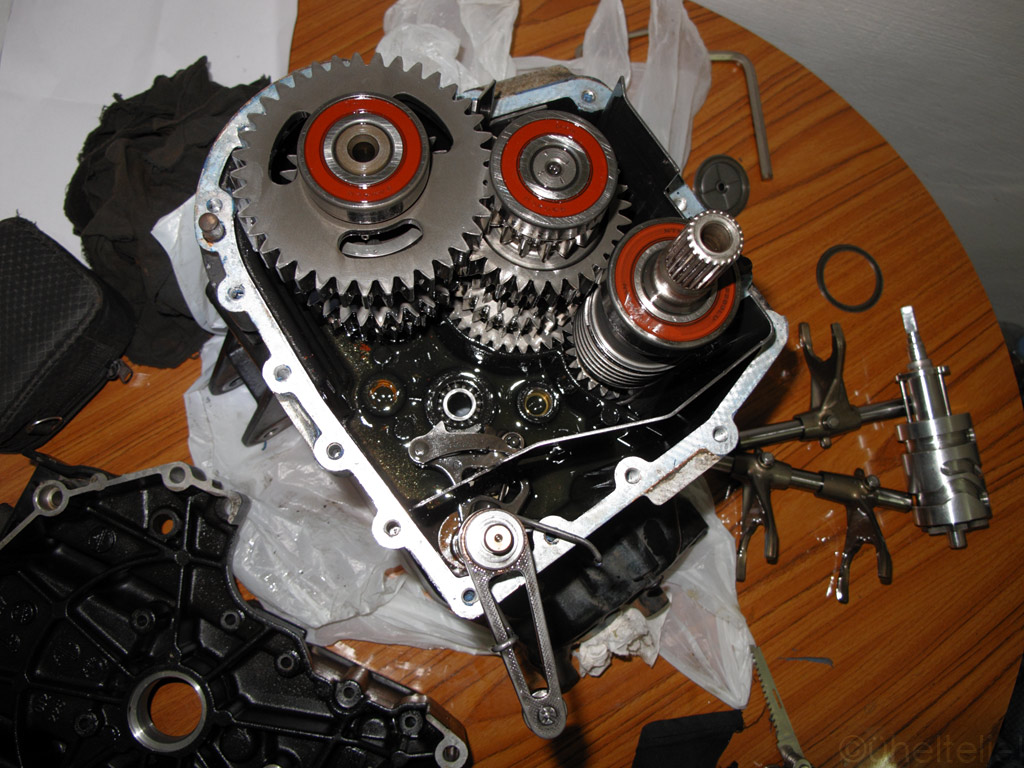
Opening up the gearbox.
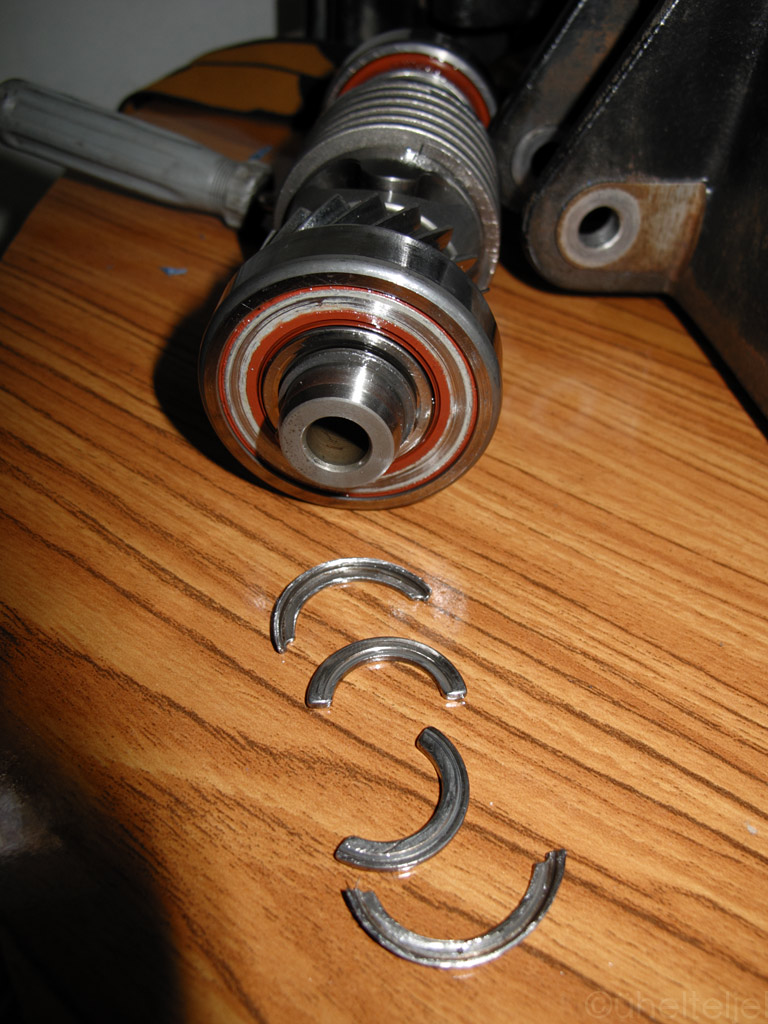
Broken bits.
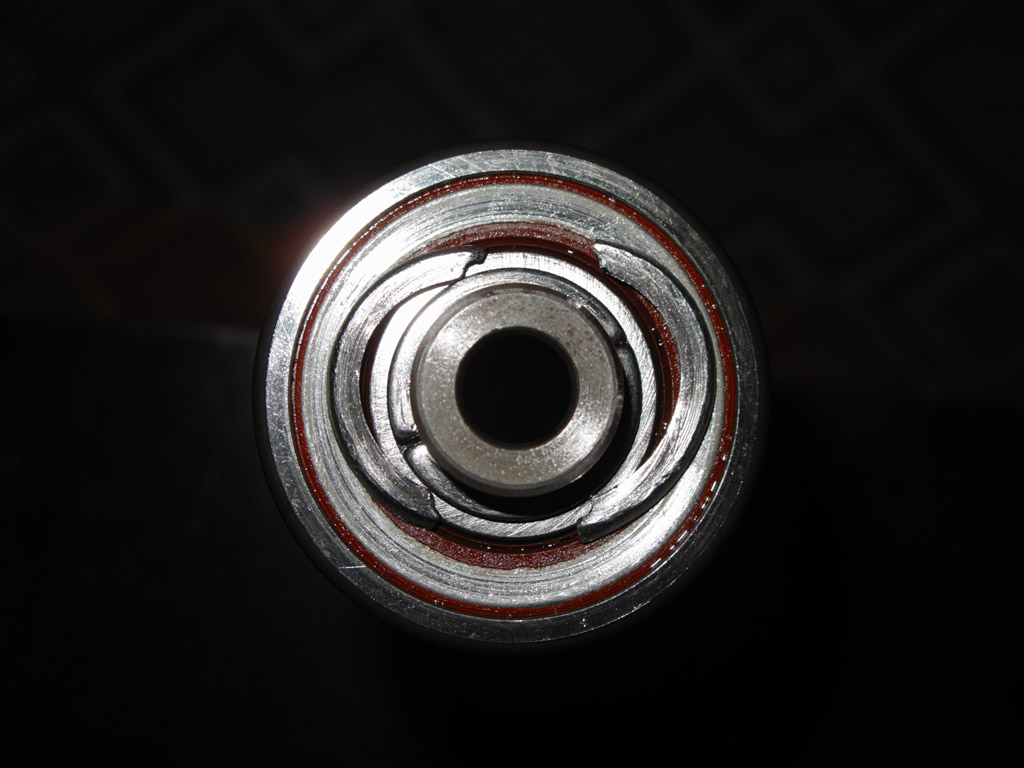
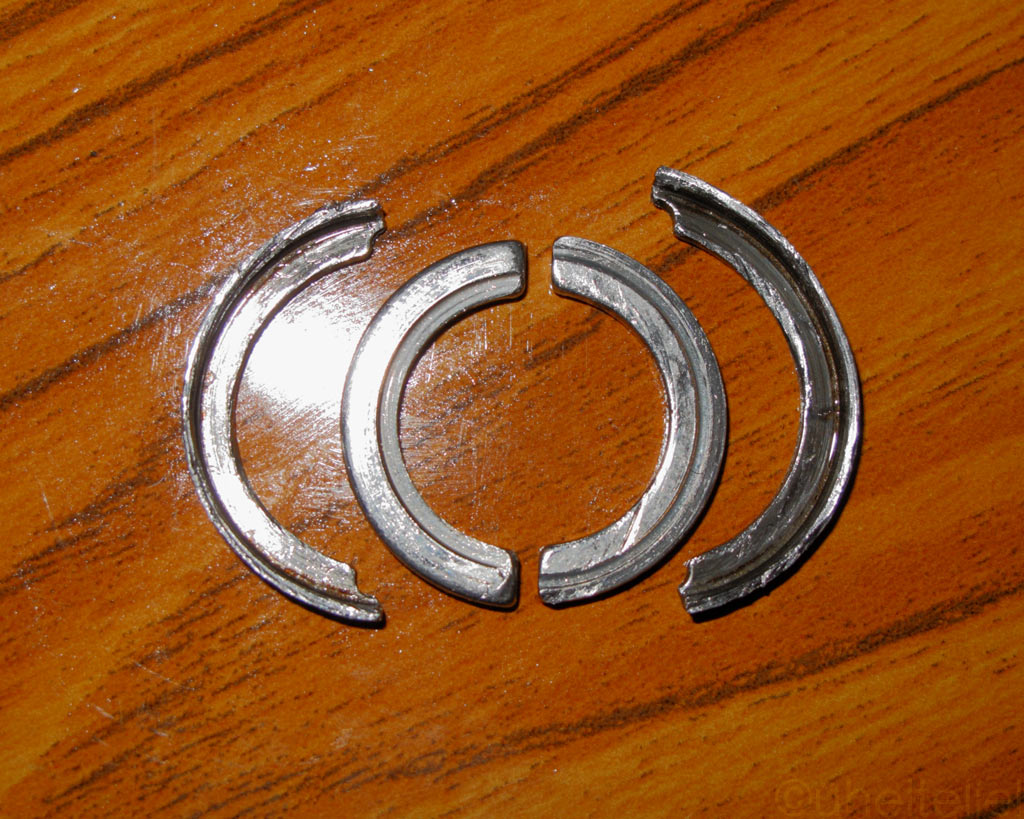
Outer part should be in one piece locking together the two inner circles. And all this...
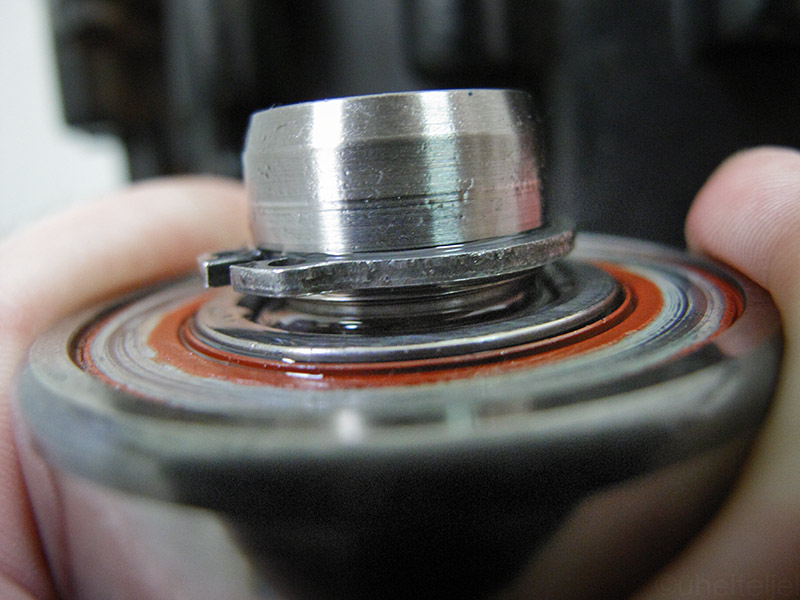
...supposed to be between there in one piece.
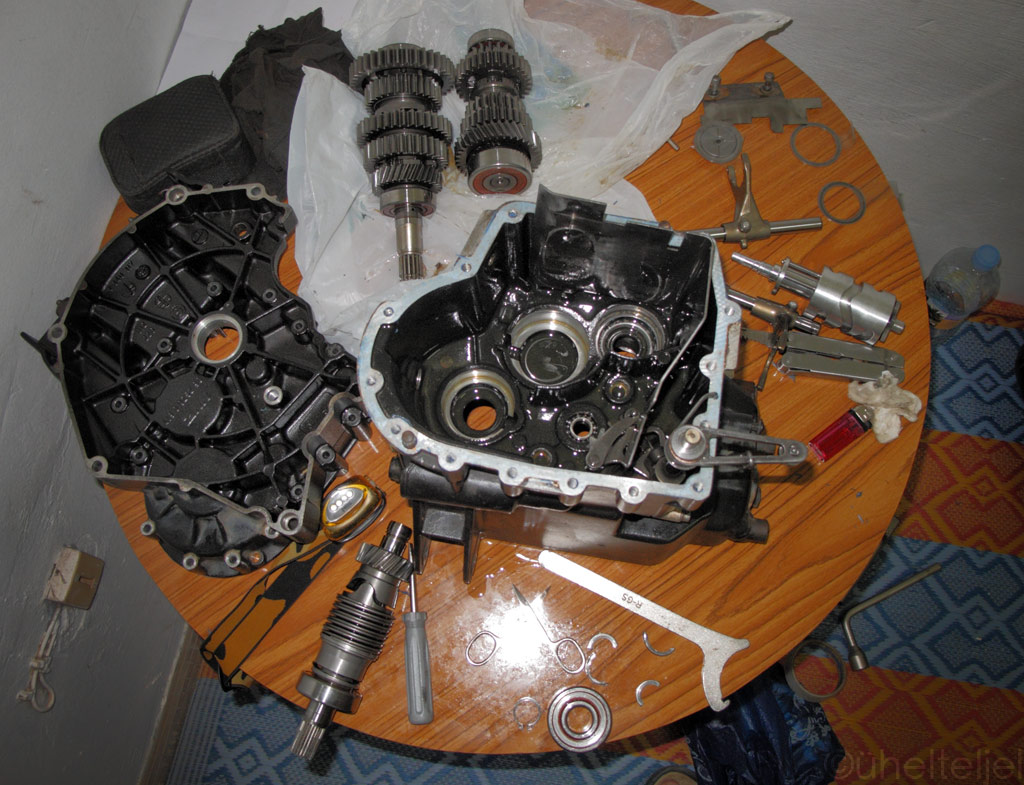
Big boys Lego on our hotel room's table.
So the mother of the chain of events was the bearing which is a known weak spot on R1100 "M97" gearboxes. We first replaced it in Australia when the bike had 150 000 kilometers (93 000 miles) - the original NTN beating was "Made in Japan". We managed to find exactly the same NTN product with the same product code which now was "Made in Taiwan" - this is the same one that failed this time with only 100 000 kilometers (62 000 miles). Why the hell does BMW put Asian bearings into their gearboxes!? It should be "Made in Germany"! Maybe then it'd be 200 000+ kilometers per bearing like it should be.
So we had a big mission in Nouakchott - because no way we could find such a special design of a shim, we had to create one from a scratch, with correct measurements and good strength. We found "claimably" the best turner in Nouakchott who took the job and made us one of unknown quality and asked a lot of money for it too. But we had no choice.
Also we needed to find a new bearing - took us a full day to go around the city with a taxi and we only managed to find a "DPI" bearing which is "Made in China". Again, we had no choice. We DO NOT want to know how little this will last with the "downgrade" experience we had since Japan-Taiwan- and now China!
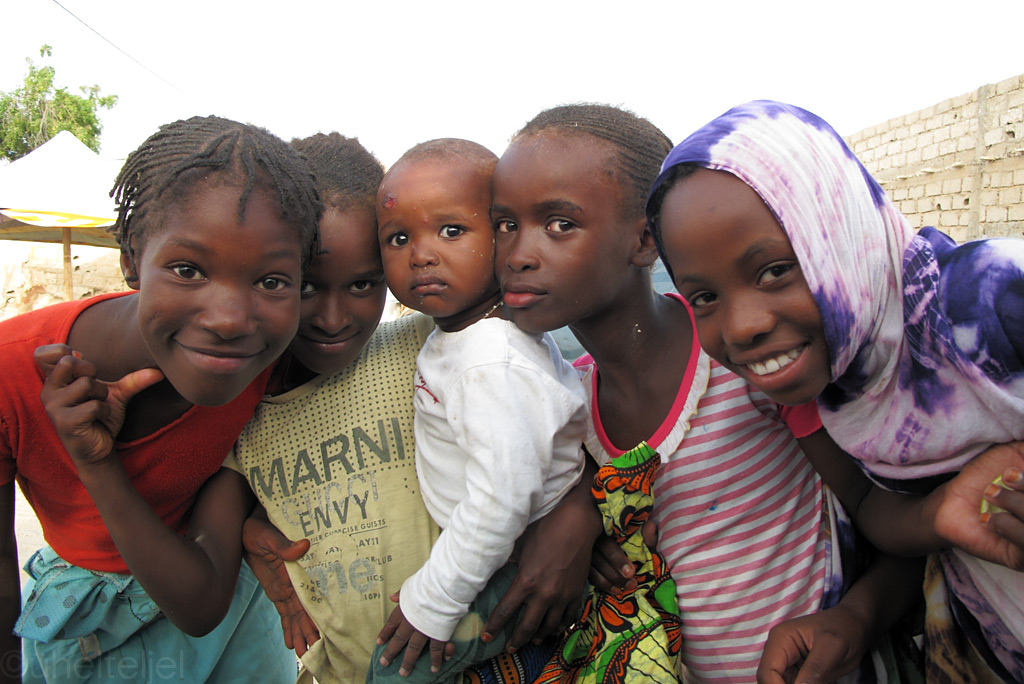
Nouakchott slum girls wanted a picture to be taken of them while we searched for the parts and tools visiting different mechanics' homes.
In Nouakchott's oppressive +42C (+107F and that's in shade!) we did all the work on the bike in our hotel backyard with sand flying around, and rebuilt the gearbox on our hotel room's unstable table - we were amazed how a creative use of tools allowed to do most of the work with BMW's stock toolkit. We only had to borrow a half-inch tool with number 30 to detach the swingarm.
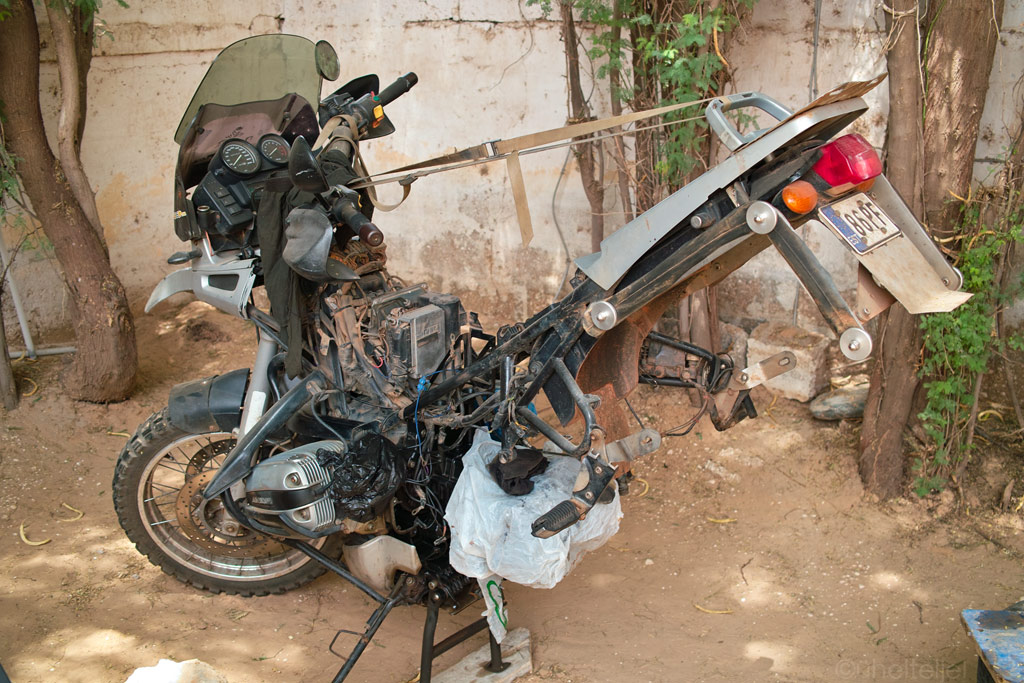
It is strange to think a simple bearing and a broken shim can cause such a pain and 11 days of being stuck. Some call it adventure, well maybe if we think about it in a retrospect, but to live it through in such living and working conditions is just pure pain!
It now feels like we've created a ticking bomb with low quality Chinese bearing and African home brewed spacer shim living in our gearbox. It's a payoff compromise, with no money left to invest into proper repair - there are no guarantees with this repair. We just hope to make it back to Estonia alive, which is some 6000 kilometers away - hopefully the Chinese and the Mauritanian made their bits at least that good.
Here's a video of the work done in hotel room and backyard:
When I read from somewhere that fish makes up a big part of Mauritania's exports, I was a little bit surprised as most of the country is nothing but desert. But the key here is the several hundred kilometers long coast line, and this is where most of Mauritania's 3+ million people live, and for living - they do fishing, of course.
Thus it is no surprise that Nouakchott's main (if not the only) sight is the fishing port, a few kilometers out of town. There is so much action, with colourful fishing boats coming and going, women carrying the fresh catch with huge plastic bowls on their heads from the boats to the market, merchants in tall rubber boots standing in the stinky water in front of their stalls laden with extraordinarily big fish. Someone is busy with repairing his fishing nets, someone services his boat engine. Kids play in the waves while their mothers sell freshly fried doughnuts in the salty sea air. It looks as if the whole life had concentrated there, and what a life it is!

Action in front of the fish market (click to enlarge).
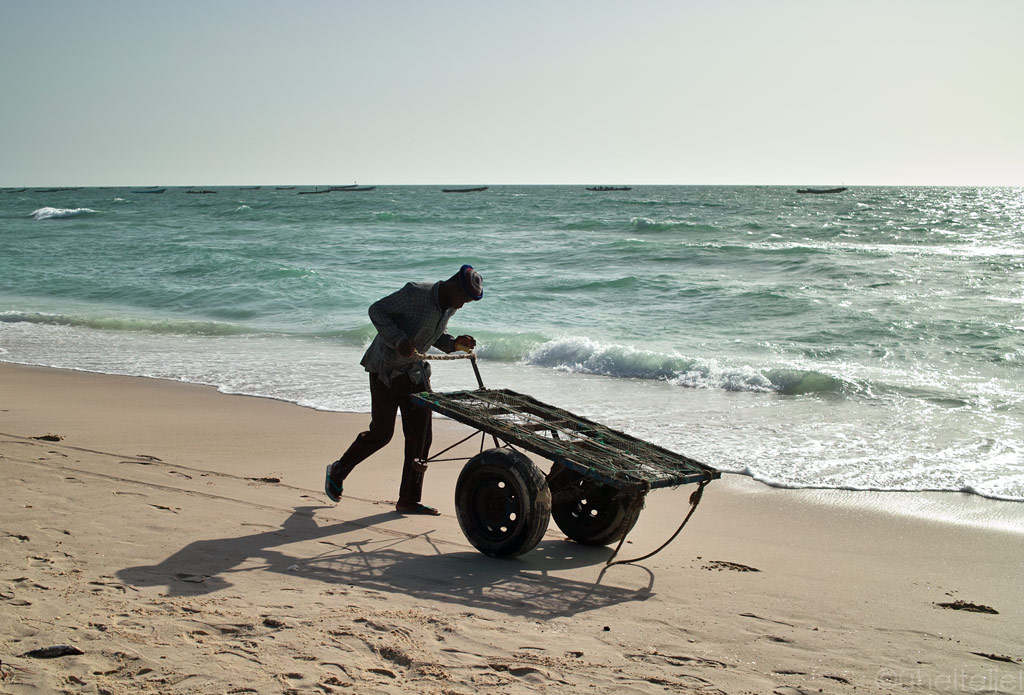
Pushing a cart to meet the boats coming from the sea.
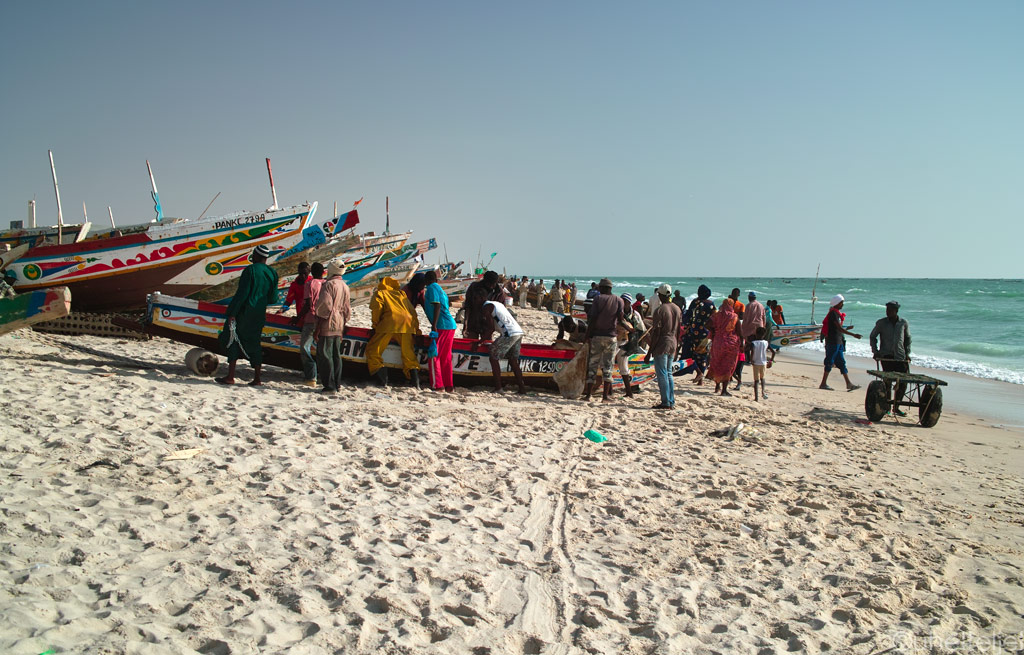
Everybody is busy.

Hauling a boat on old gas bottles.
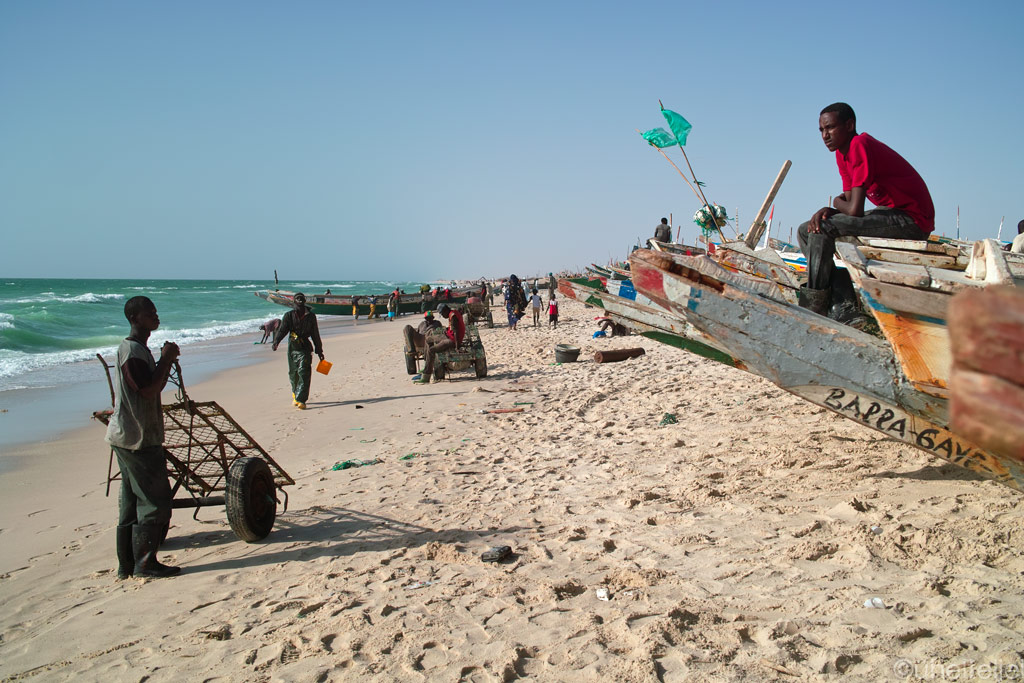
It isn't just a few boats, but this view stretches for hundreds of meters.
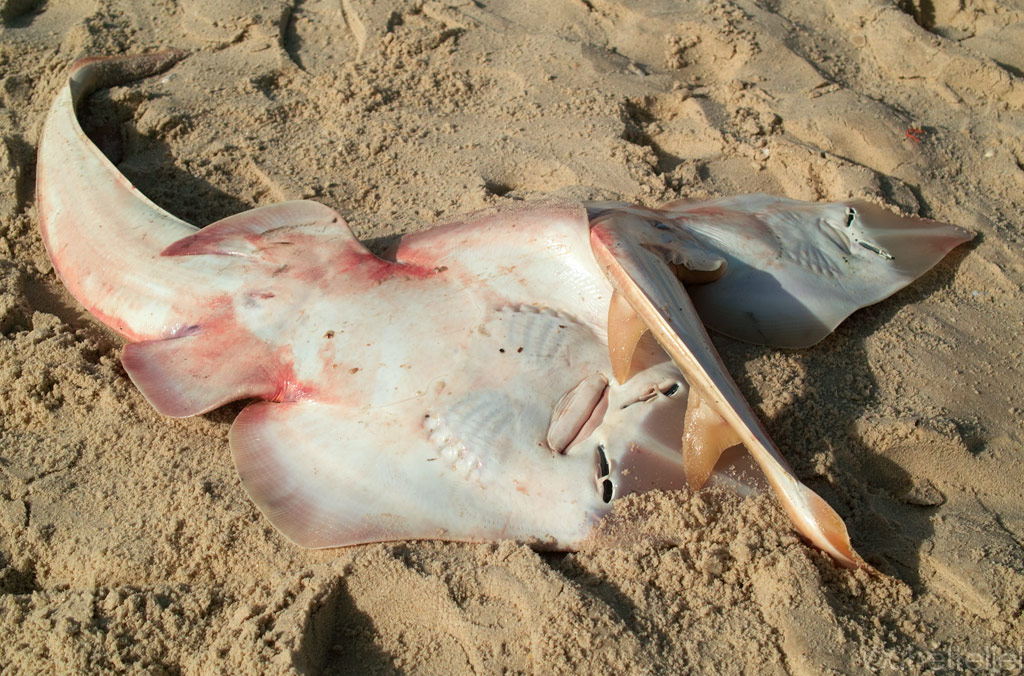
The fresh catch - must be some sort of rays.
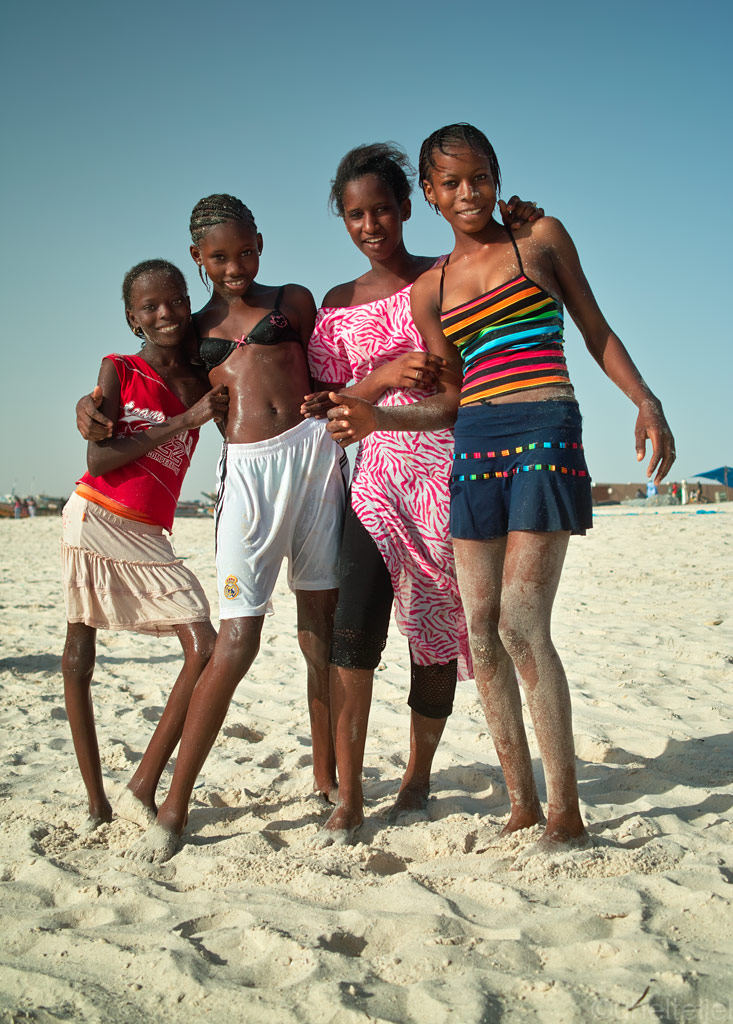
Girls insisted on a photo - but I felt a little odd taking it with some burka-clad old ladies passing by and surely thinking how spoiled the new generation was…
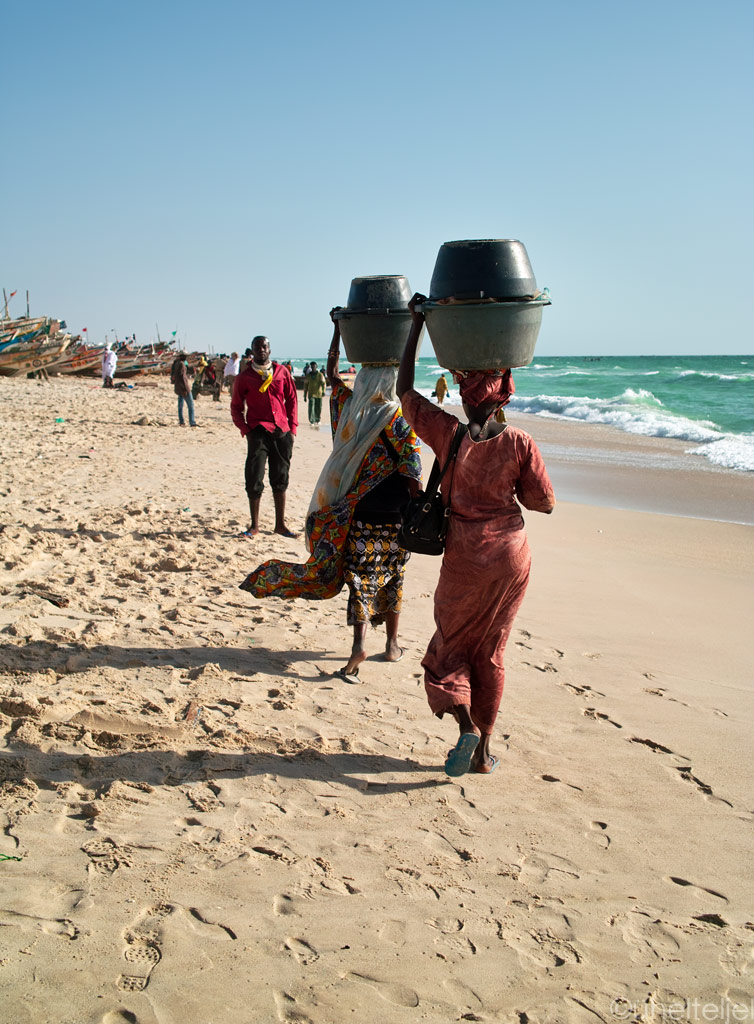
Women carrying the fish to the market.
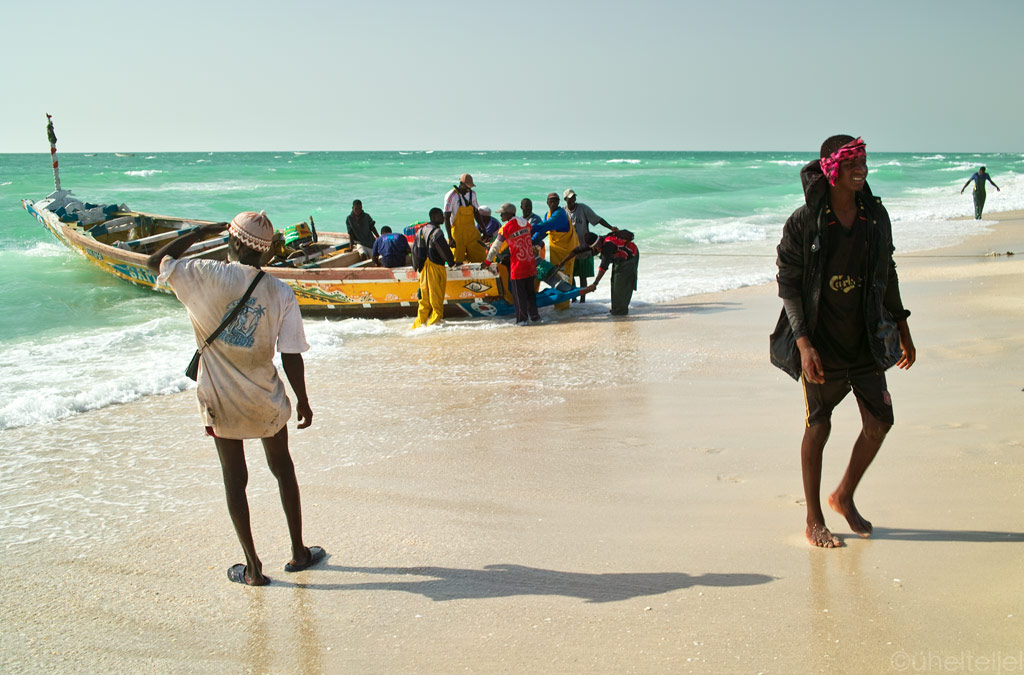
Using the incoming wave to push the boat into the sea.

A panorama of the life at Nouakchott's fishing port (click to enlarge).
Since there isn't much to see or do in Nouakchott, as soon as we had the bike back in one piece, we zoomed towards the north, to Nouadhibou, the second biggest town in Mauritania located some 500 kilometers from the capital. The ride there was terribly monotonous, with strong winds kicking up the sand as we rode through the vast plains of empty desert. There was nothing there, and even the check points were few, with policemen looking like mummies, their faces wrapped in cloth for protection against the constant "sandblasting".
When we arrived at the coast, leaving behind the +40 C desert, the sea wind welt so invigorating that we found enough energy in ourselves to ride to the southernmost point of Nouadhibou peninsula, where a huge ship wreck is anchored. There are many ship wrecks in the bay, that just like in Luanda, Angola, have been simply dumped there as disposing of an old ship is far too expensive for the ship owners here. The wreck at the tip of Ras Nouadhibou is quite recent, which is obvious because we saw men carrying some hydraulics and other stuff of the ship.
Nouadhibou itself is nothing special - if a better organised place than Nouakchott, with DHL and UPS at hand, and even some workshop-like workshops. Otherwise it is a regular sandy, windy desert town, with hoarse calls to prayers flowing down the low-built streets.
...::: LISTEN Nouadhibou's hoarse mulla propagating islam over windy town :::...
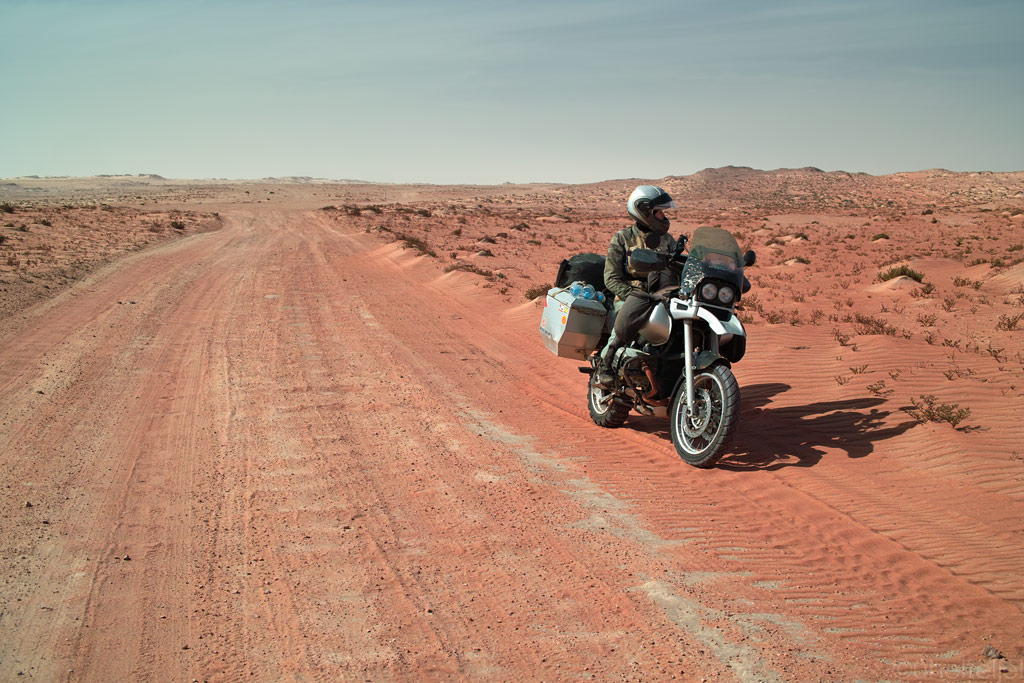
On the way to Cap Blanc in the tip of Nouadhibou peninsula - over funky reddish sand.

At Cap Blanc (click to enlarge all the panoramas)

The ship wreck. Notice a man on the right hauling stuff off the ship.
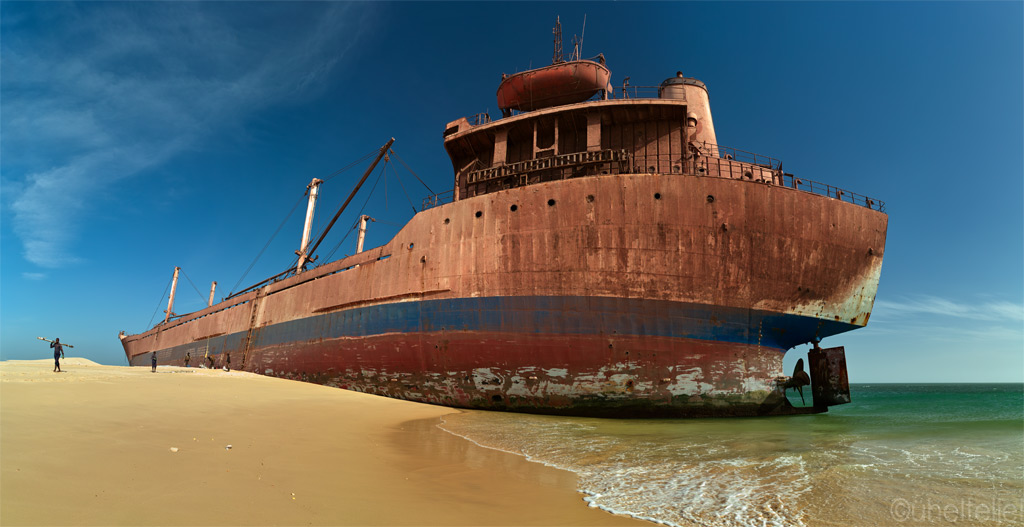
Picture of the massive shipwreck close up (you can clearly see it even on a sattelite image). And local men are carrying prescious plumbing, metal and other gear away :lol3
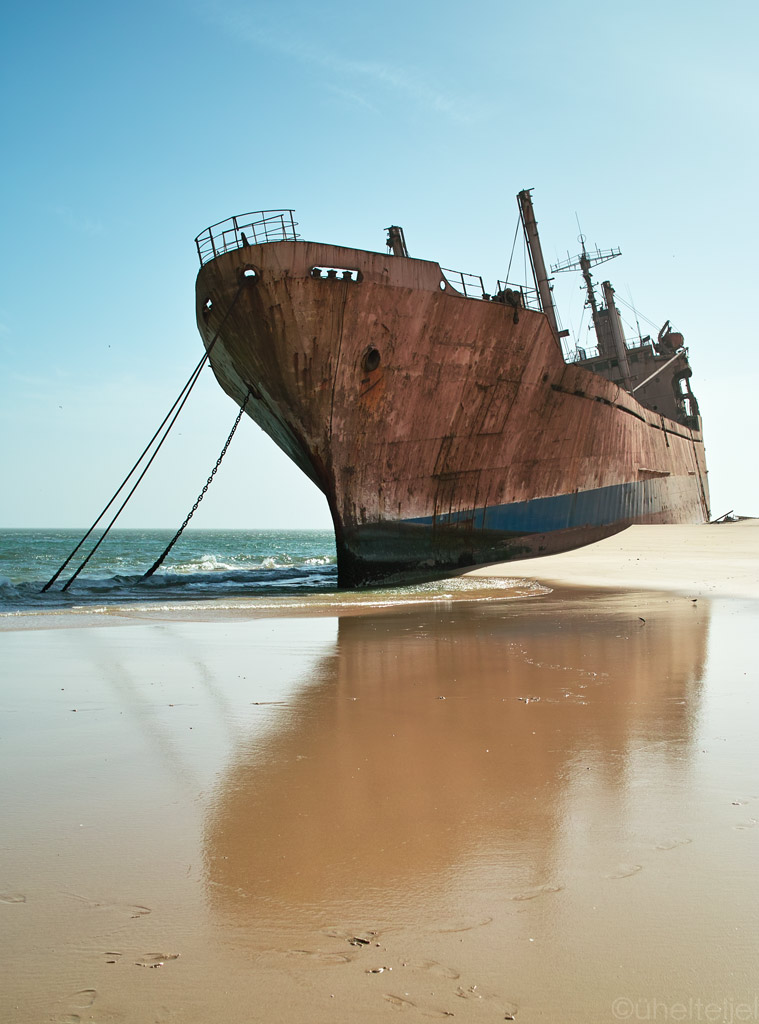
It is huge! Pity they don't have a working metal recycling system - someone would make a good money out of it.
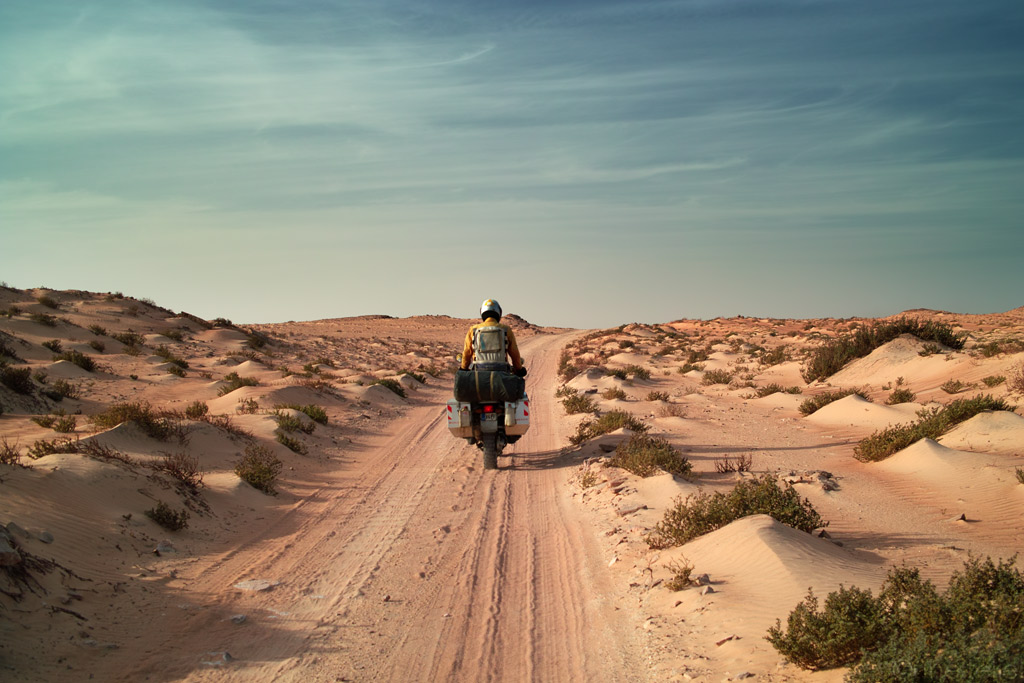
On the way back to Nouadhibou, our final stop before the Moroccan border.
After a time-consuming border crossing from Mauritania into Morocco we found ourselves in Western Sahara, a land squeezed between two magnificent forces, the Atlantic Ocean and the greatest desert in the world - Sahara. One ends, other begins, there is no space for compromise - it is either the lifeless sand or the cool waters.
Soon after we crossed into Western Sahara there was a check point where police asked us about our destination. As we said it was Dakhla he admitted, somewhat uncomfortably, that there were "problems". You see, Western Sahara may de facto belong to Morocco, but every now and then the desire for independence bursts out into violent action. Most of the Sahrawis, as they call themselves, cautiously keep their feelings to themselves though, bearing in mind that without the Moroccan government they'd have none of the modern infrastructure that makes them stand out among most of African countries.
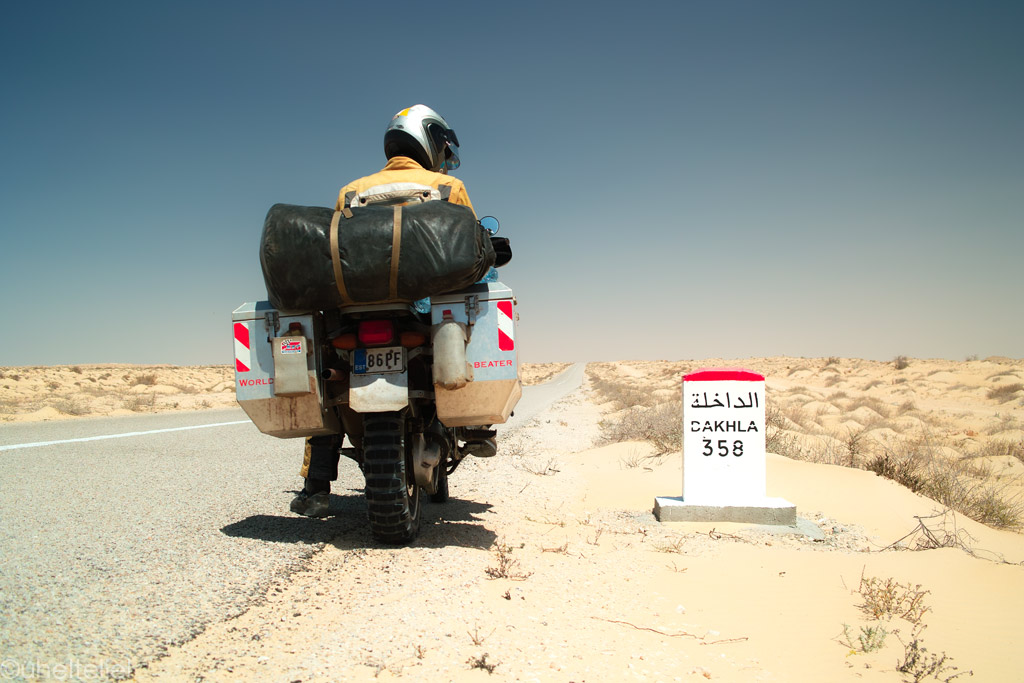
Just after the border crossing, the road is wide open in front of us.
Problems in Dakhla meant that we had to think of another place to break the journey through this vast land - which is not so easy as it is extremely sparsely populated, and wild camping is potentially dangerous because of the mines. Some distance before Dakhla, we took our chances at a small track leading off the main road, pointing towards Porto Rico. A rich port, to translate from Spanish (Western Sahara used to belong to Spain), but what we found was nothing more than a tented camp sheltered in an isolated bay, and a lighthouse. There was nobody there, although well kept open-air toilets, showers and even a well-equipped kitchen suggested it was a fully functioning place. No one was there, but nothing was locked, as if trying to say we were welcome.
While going around the camp, trying to decide what to do with this place that at the same time looked abandoned and inviting, we managed to dig the bike into soft sand. But while we were trying to dig it out again, the guard showed up from behind the dunes.
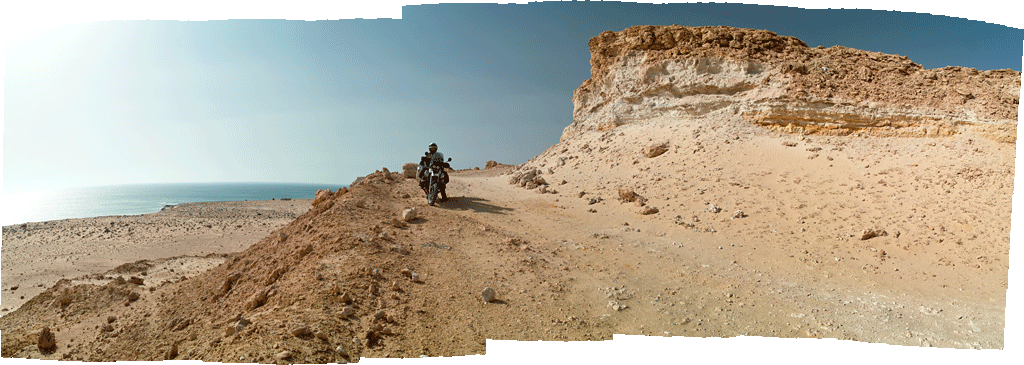
Way to the camp (click to enlarge).
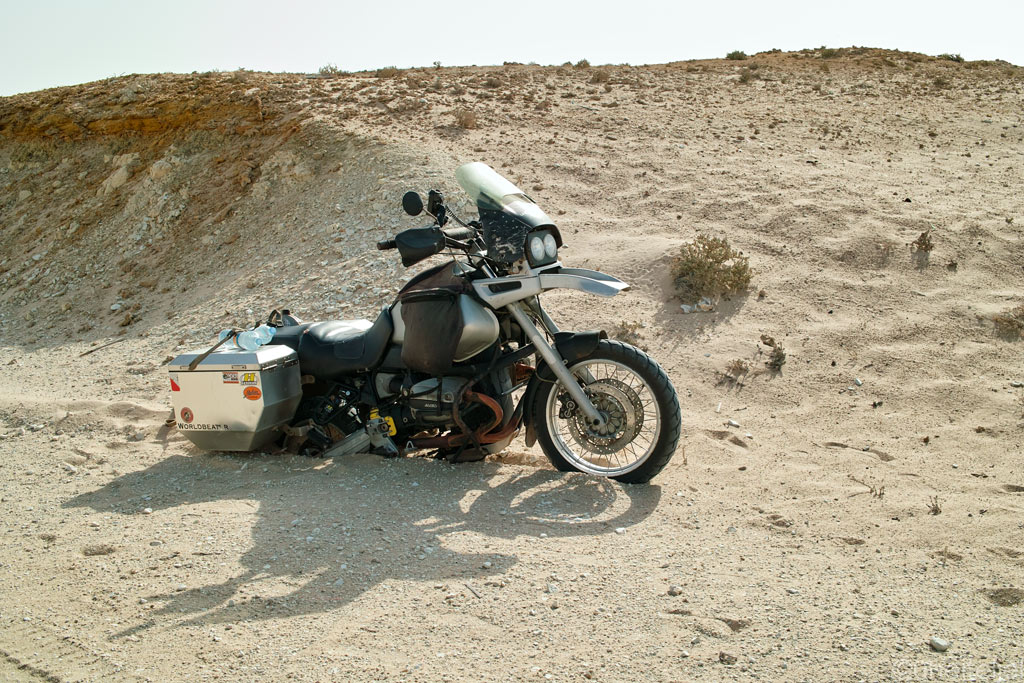
Deceiving surface - looks like fine gravel, but it hides soft sand underneath.
Since the wind was blowing hard on the coast and the ground was nothing but sand we could not have pitched our tent, so we opted to stay in one of the stationary Bedouin tents. It cost more than we would normally spend on accomodation, but we'd never slept in such a tent before, so it ws an experience. It is so quiet inside even though outside the wind may be blowing a gale…
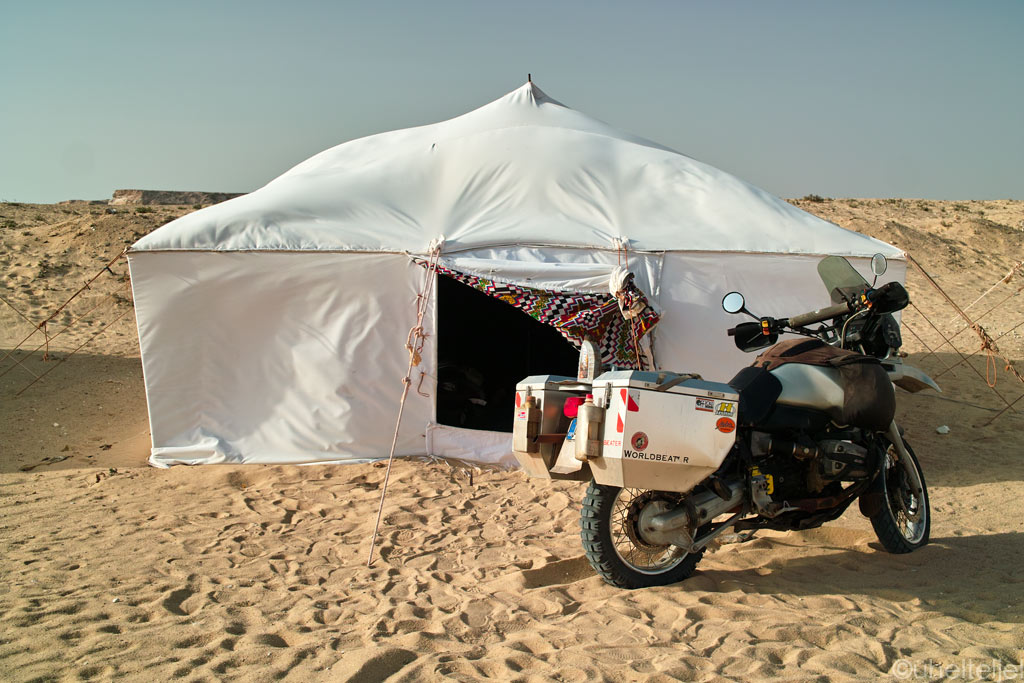
The traditional tent - our home for the night.
We spent the last hours of light walking on the beach, which felt absloutely relaxing and brought peace into our minds that had seen so many worries in the past few weeks. The sea had receded with the low tide, leaving so many hidden treasures for us to see - thousands of sea shells and snails attached to rocks.

Sunset in Western Sahara (click to enlarge).
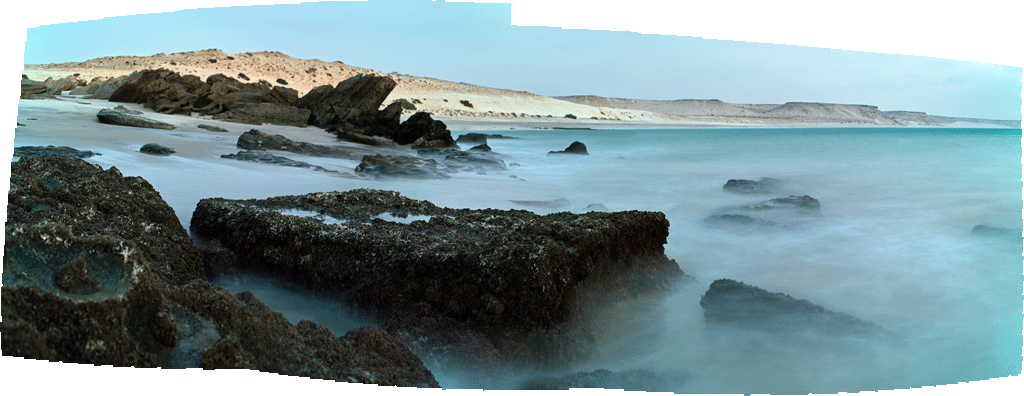
The Atlantic (click to enlarge).
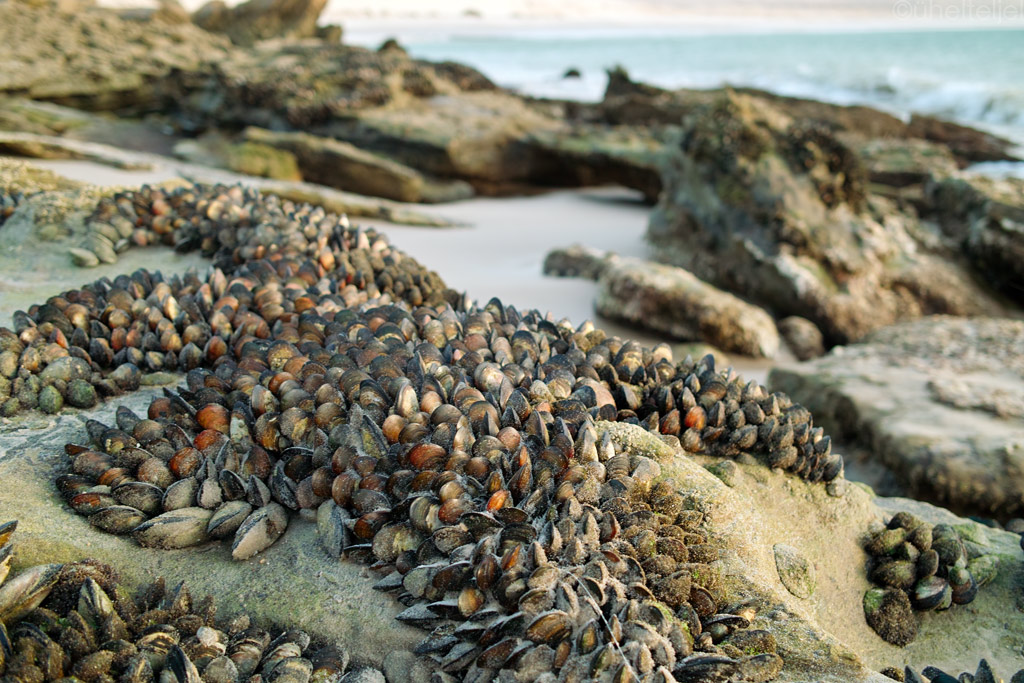
Underwater life exposed during the low tide.
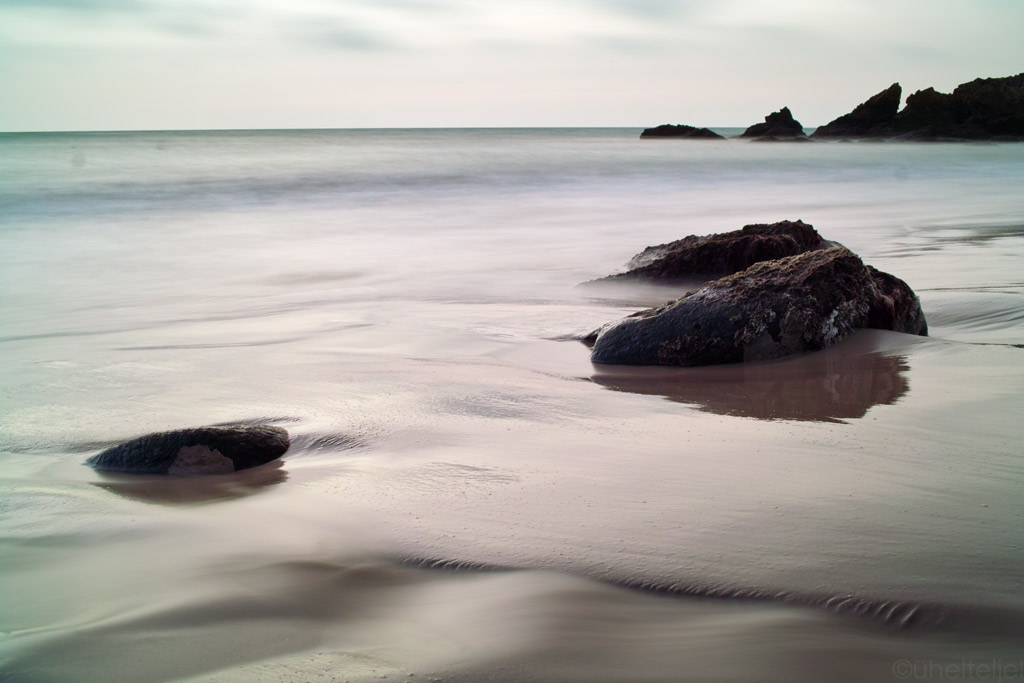
The ocean going to sleep.
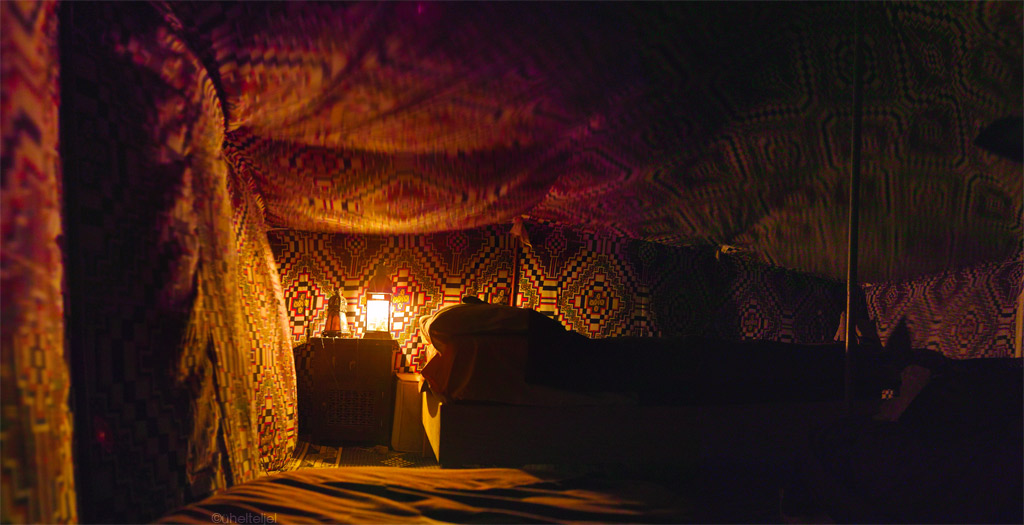
The night was dark by the ocean, and the wind was still blowing hard, but inside the tent it was warm and cosy.
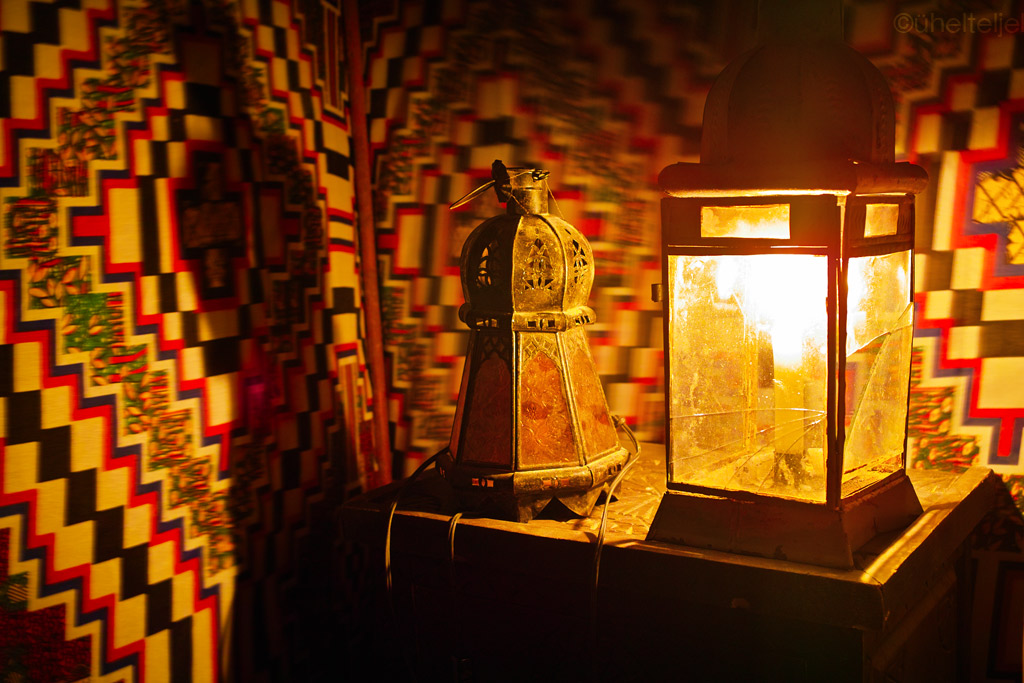
Yes, everything is done in a candle light inside Western-Sahara's traditional tent.
In the morning, the friendly guard prepared us some Sahrawi tea - strong green tea, made on coals, which is poured many times from the kettle into the glasses and then back to form the nice froth. There was a lot of sugar in it (which is supposed to compensate for the bitterness of the tea), but it felt absolutely invigorating and left inside a warm feeling which helped to fight the slight melancholy induced by the cloudy skies. As we left the place we felt as if we were leaving a fairy tale.
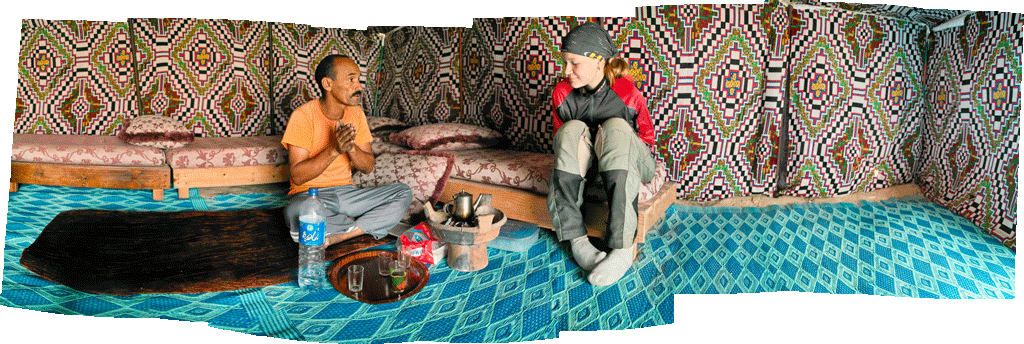
Drinking tea in the traditional tent (click to enlarge).
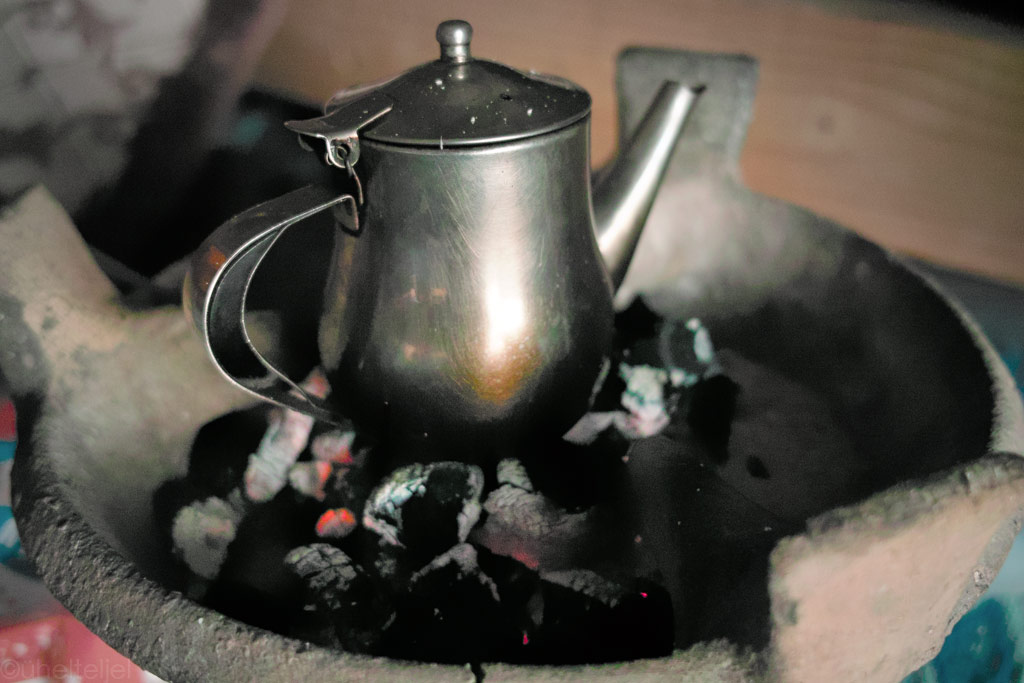
The kettle on hot coals - the true Sahrawi way.
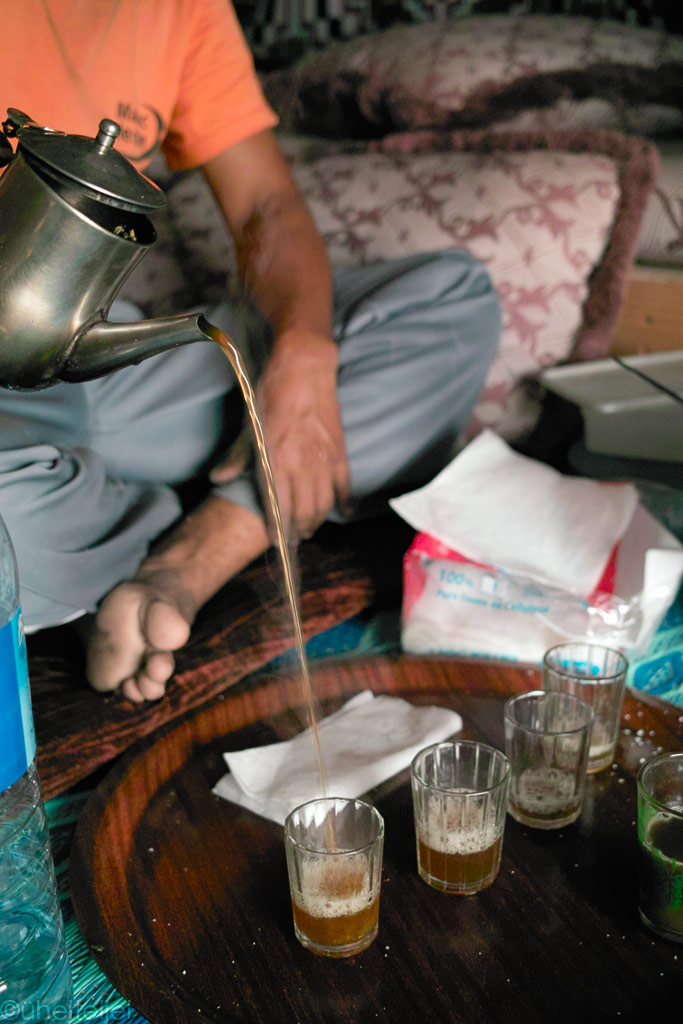
Pouring the hot tea from the kettle into the glasses.
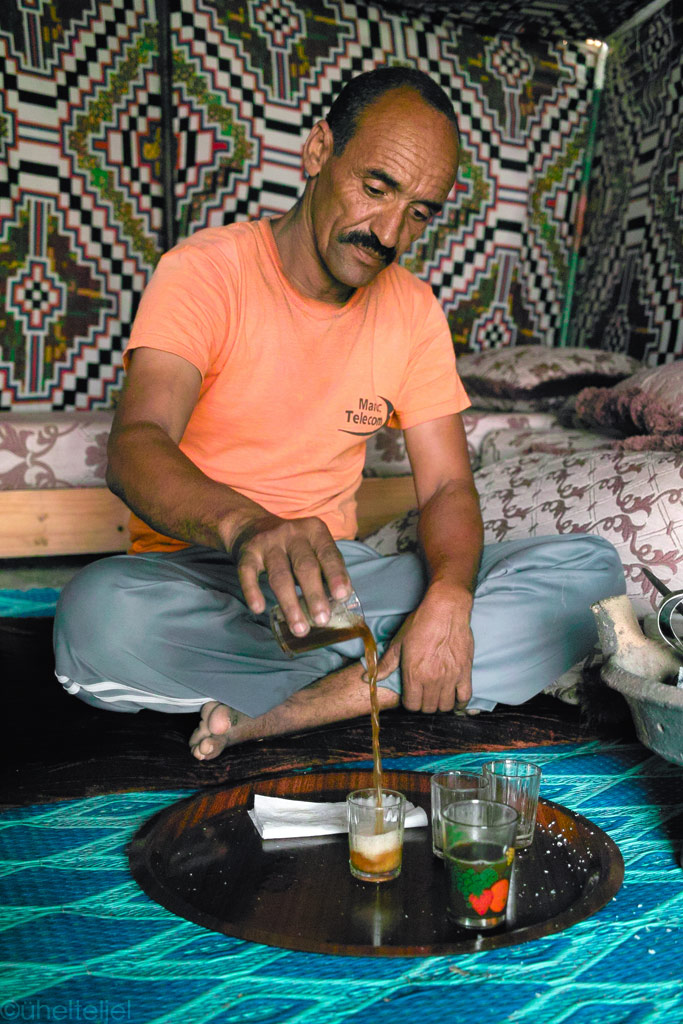
Then from one glass into another, many times tike this - to cool it and to give it "air".
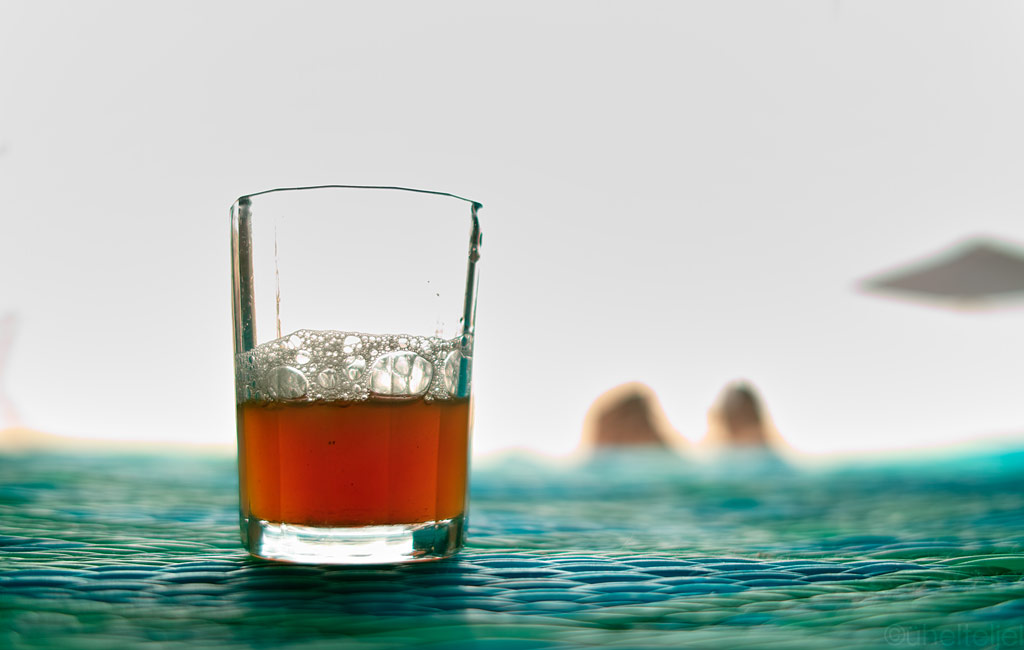
After a lot of effort (some half an hour of handwork!) finally the end product - the bubbly "Sahrawi whisky" (they are mostly Muslims here so they do not consume any alcohol).
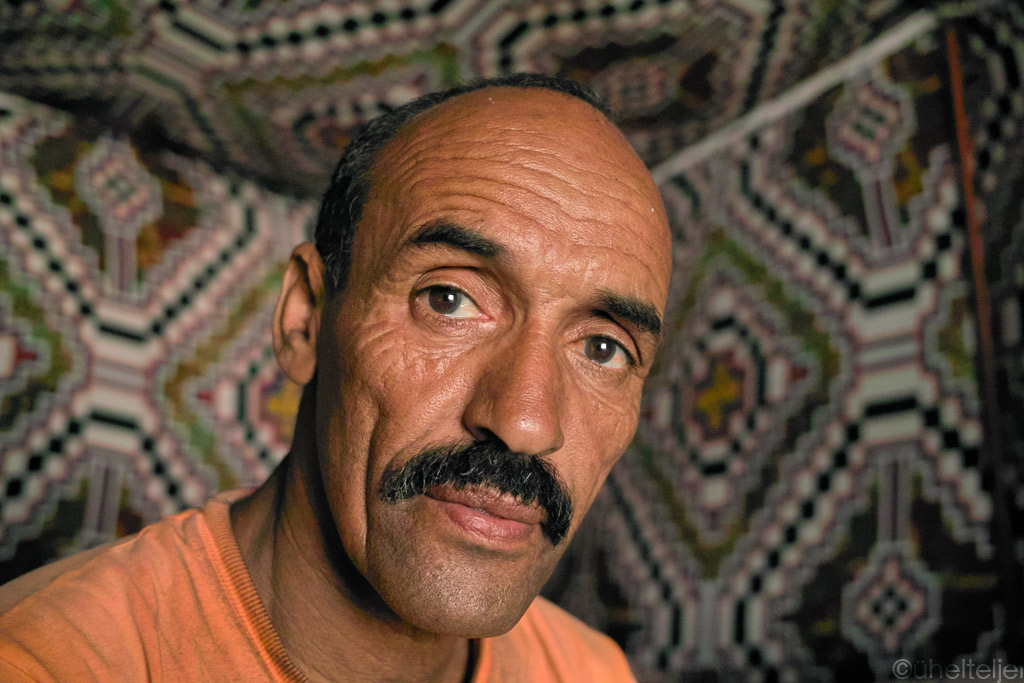
Our Sahrawi host.
As we rolled on towards north the landscape didn't vary much but in all its simplicity it looked beautiful.

A picture from the top of the old lighthouse down to the camp (click to enlarge).

The Atlantic in the Western Sahara (click to enlarge).

The road through the deserted land on a good road (click to enlarge).

The desert and the sea (click to enlarge).

Western Saharan landscapes (click to enlarge).
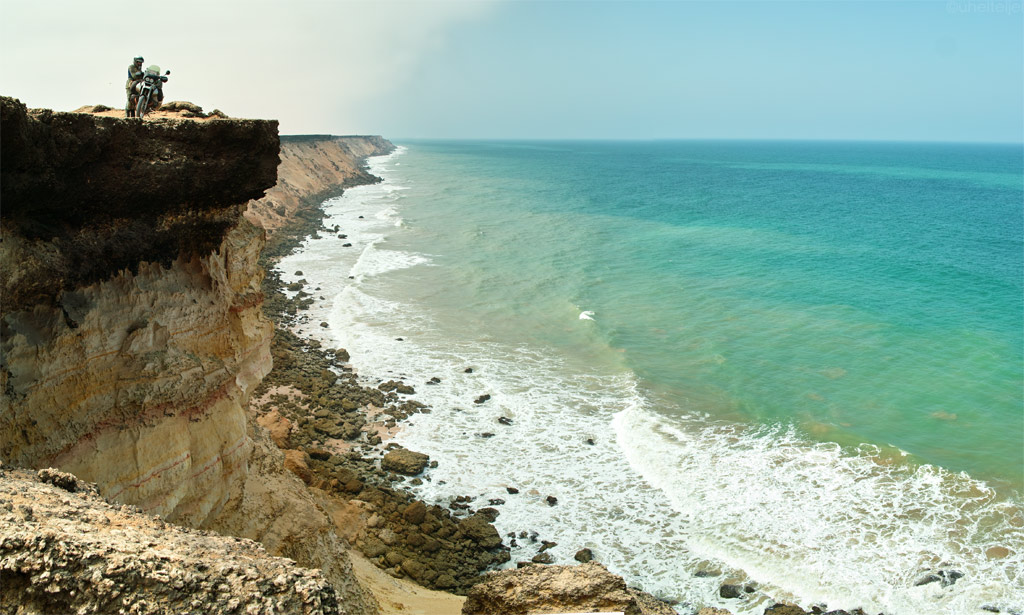
The contrast is stark between the two forces.
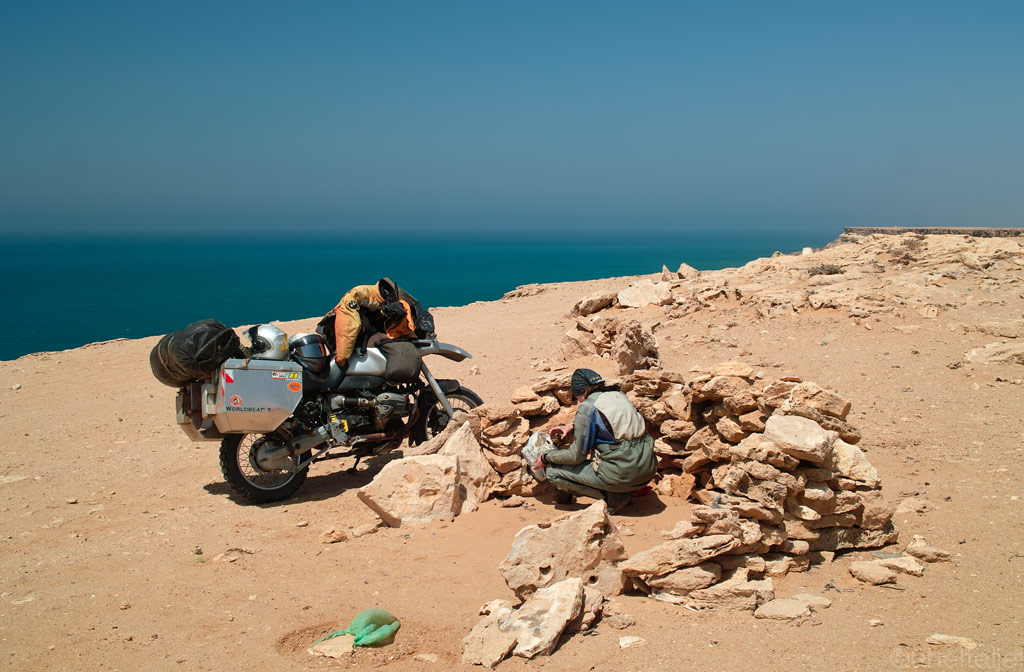
Cooking lunch in a small shelter.

A million dollar view to accompany our camp pasta (click to enlarge).
Since we were already on the edge of the Saharan desert it would have been unfair not to go and have a closer look at all that sand. We went to Erg Chebbi, known for its high sand dunes, which are truly spectacular, changing their colour from dusty white to golden yellow and then to smouldering pink while the curvaceous shadows crawl across their sculpted surface as the sun makes its way across the sky.
But to be absolutely honest, it wasn´t so much for the sheer beauty of the sandy expanses that I wanted to go there, as for the last chance to have a go at dune riding. To take off the bags and the panniers and to take advantage of the lightness of the bike. And what a difference it is without all that weight that we normally carry! It felt as if the bike was not even touching the ground, so light it was!
It could have been even better, I guess, with proper tyres, which our more-than-half-worn Metzeler Tourance (100% street tyre) in front and almost-completely-worn out Mitas E-09 at the rear were definitely not. To get some grip, I had to deflate them radically, to around 8-10 PSI, which brought the corner-knobs of the rear tyre into action, providing a little traction in the soft sand - the middle part of the tyre only has one or two millimeters of thread left. Deflation also meant that the front wasn´t trying to find its way through sand too agressively.
So in this bald tyres case, the thing that you cannot really do without in the sand is the momentum, but with the low revving torquey engine that the GS has, it normally isn´t hard to keep it. Just let it "sing" at 3000 to 4000 rpm and it will drag you trough sand like a steam engine, even up the slope. I'd say it's silky smooth traction on those revs in the sand. Rev it too much though, and before you know the bike is dug half way into the sand, so you really have to do it by the feeling and the massive bottom end torque the big boxer GS produces is like a God-sent feature in deep sand. Also, what makes it a little more difficult, is that the dunes here are quite small, so you have to readapt very often, plan your route "on the fly" all the time while not knowing what is expecting you over the edge - some camel grass, soft sand or a steep descent, which is only revealed to you once you make it to that same edge. You cannot go too fast, or you might just fly over the steep edge, possibly into a "bowl" where it is tricky to get out of. But you cannot go too slow either, because if you come to a stop before reaching the edge, you will not be able to get any further, and going down the same way is no fun either. With bigger dunes it is a different story - you can go faster and let the engine rev highly, but there is the risk of becoming too rakish. Once I went too fast, not knowing exactly what was lying ahead, and almost did a salto across the edge. Luckily, no harm was done.
Of course, playing in the sand means that before you know it, there is sand everywhere - throttle, levers, cables, air box, the side sand and the center stand, and it surely does not do good to the bike, but I must say it was enjoyable (maybe less for Kariina who had to follow me with the Sigma on foot through the dunes to take some pics of me riding )
)
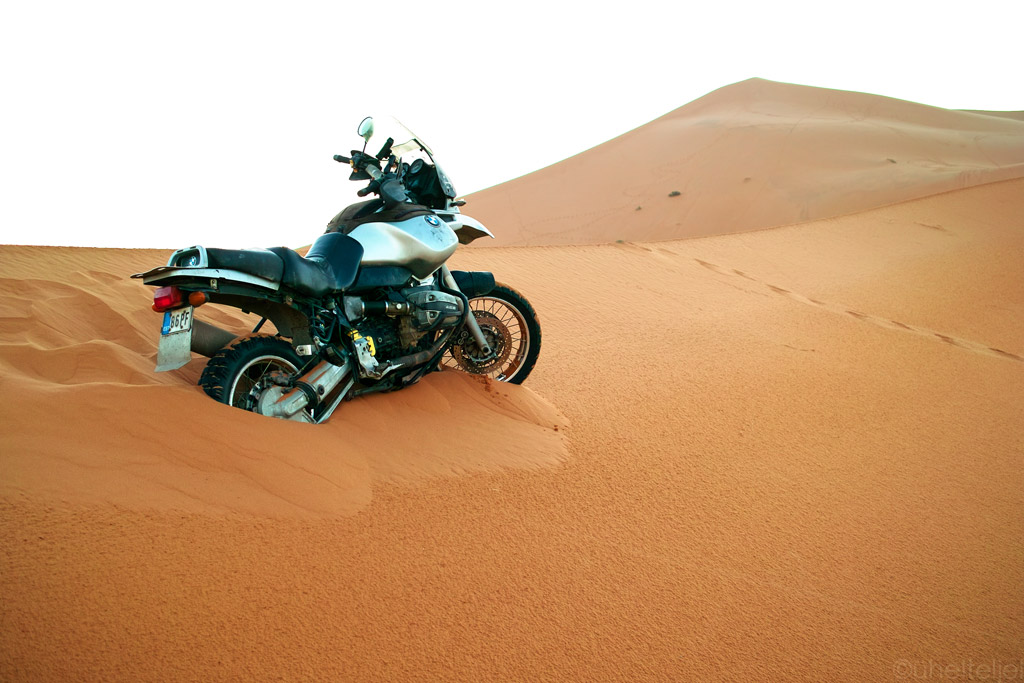
Into the dunes...
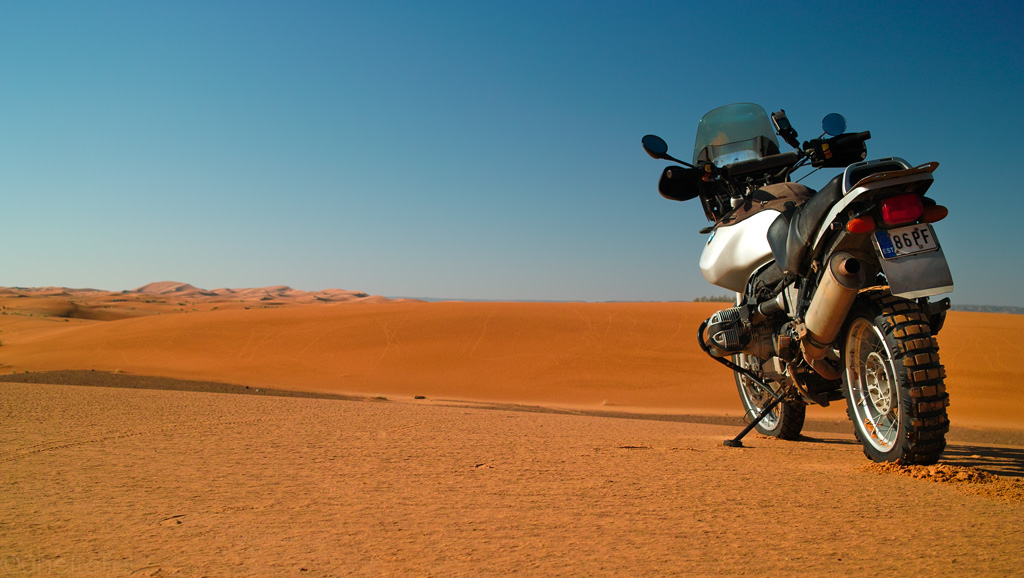
Started with the easy-peasy flat dunes.
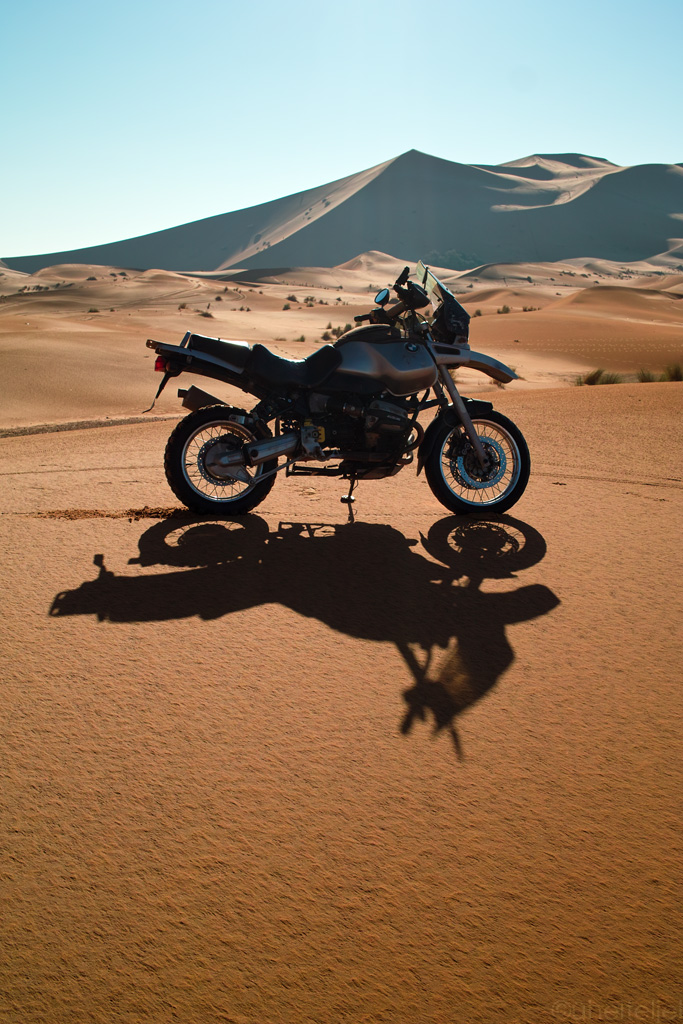
Shadow.
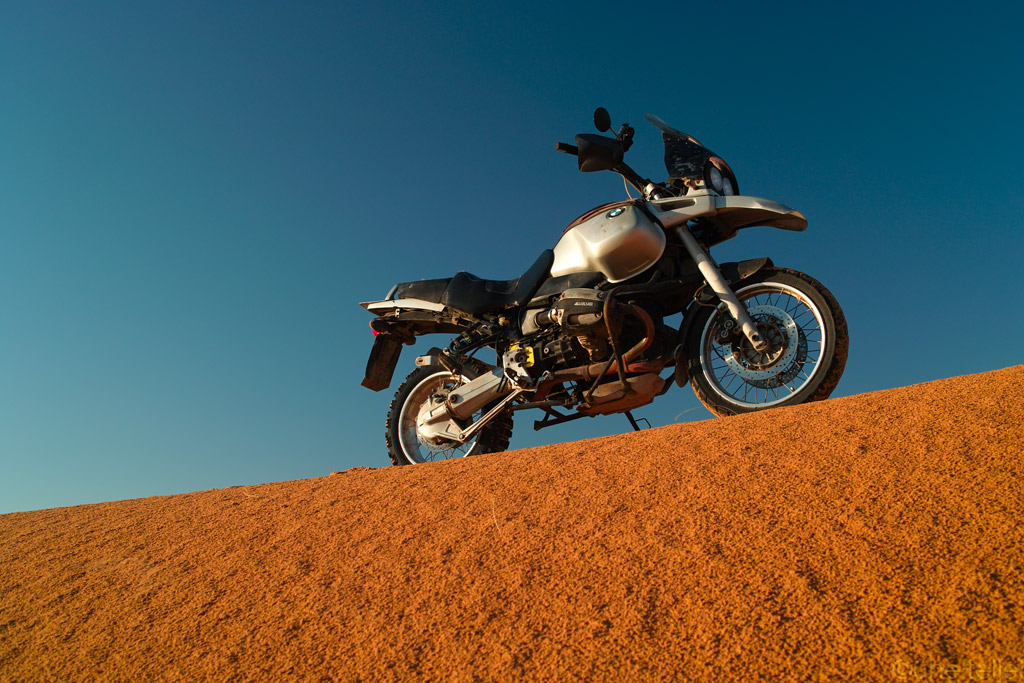
Against the sky.
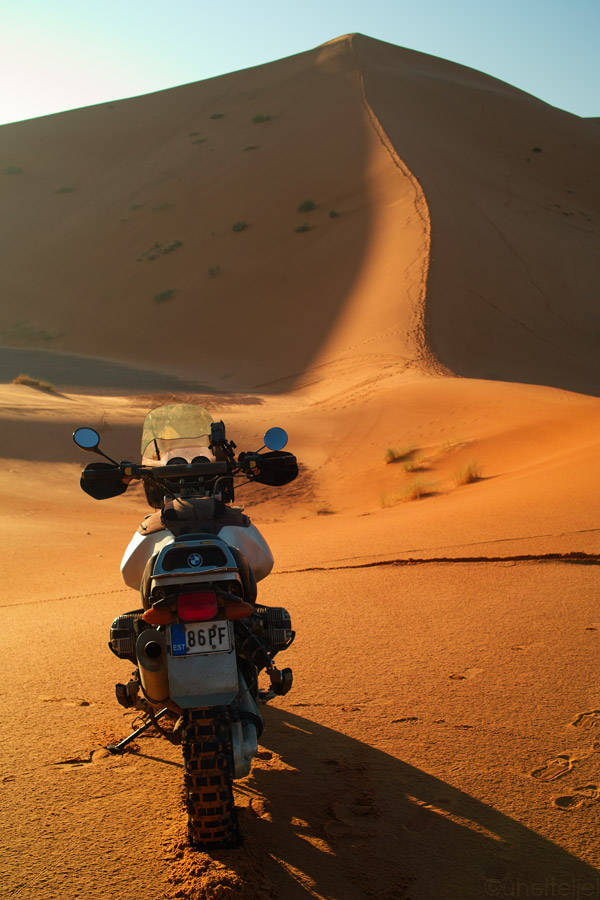
Boxer ready to conquer some bigger dunes.
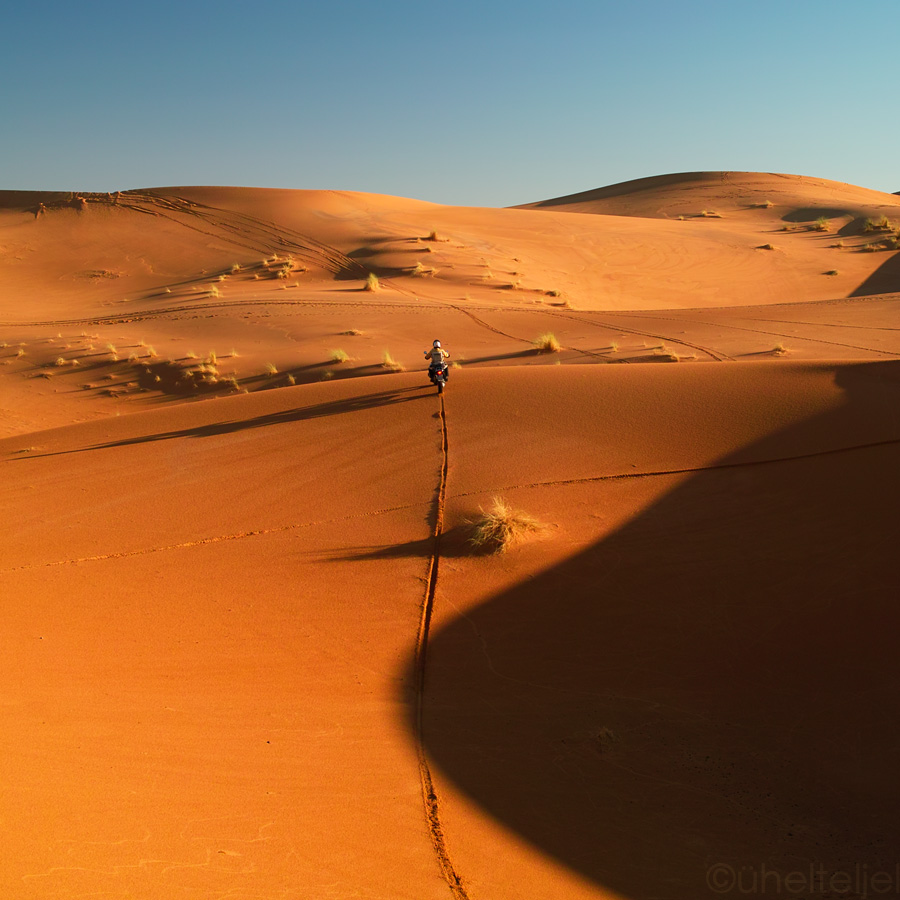
Into Erg Chebbi.
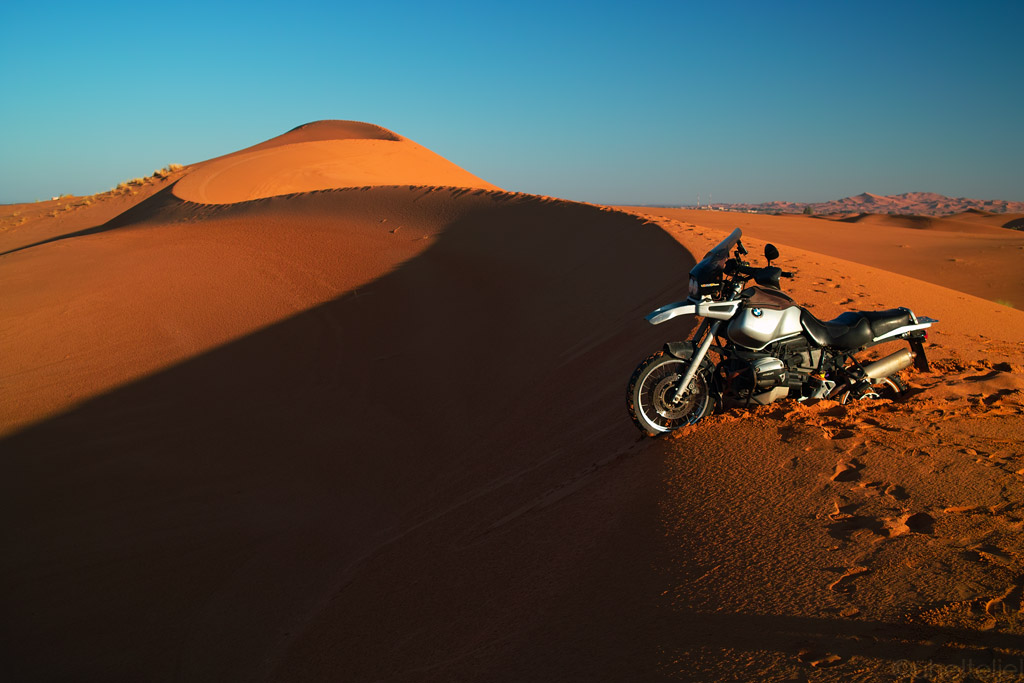
Melting in with the surroundings...
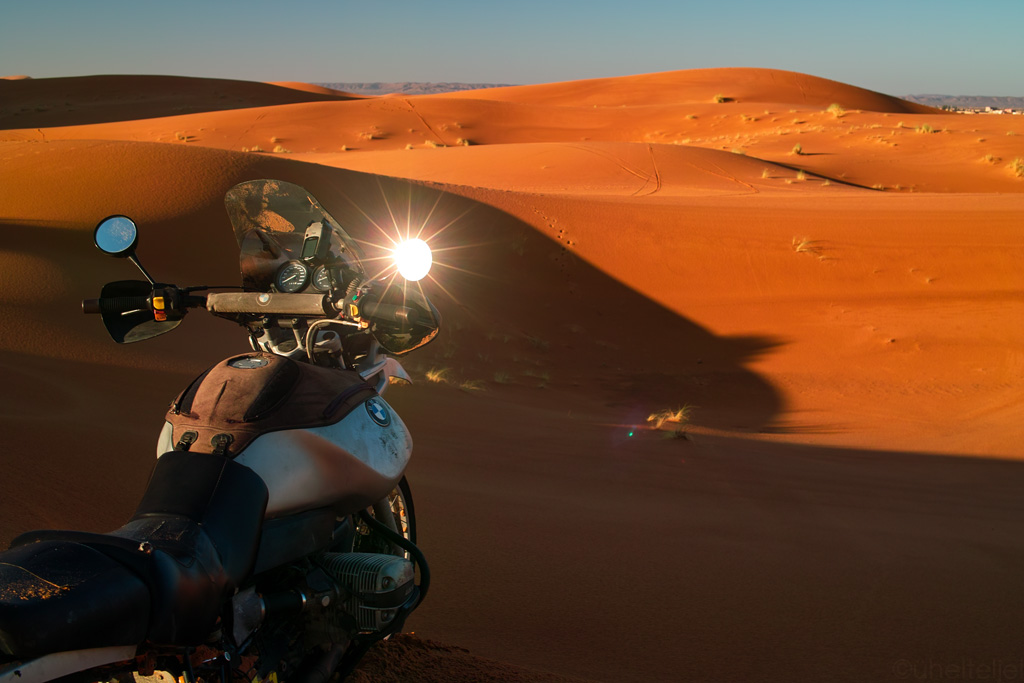
Contrasts of Erg Chebbi.
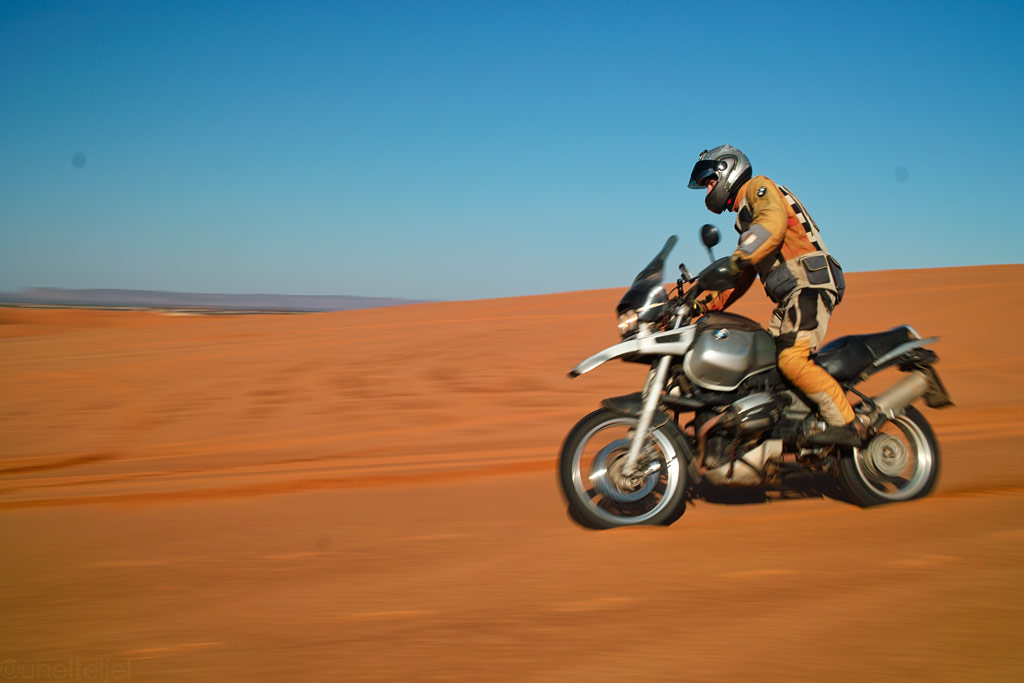
Just having fun in the sand.
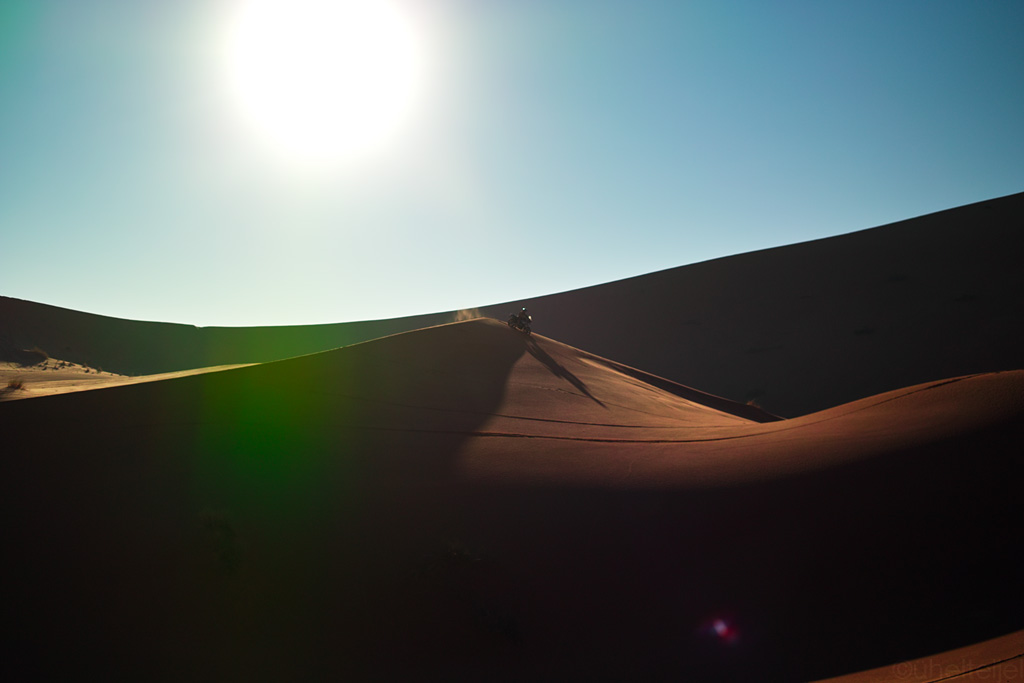
Taking some higher dunes.
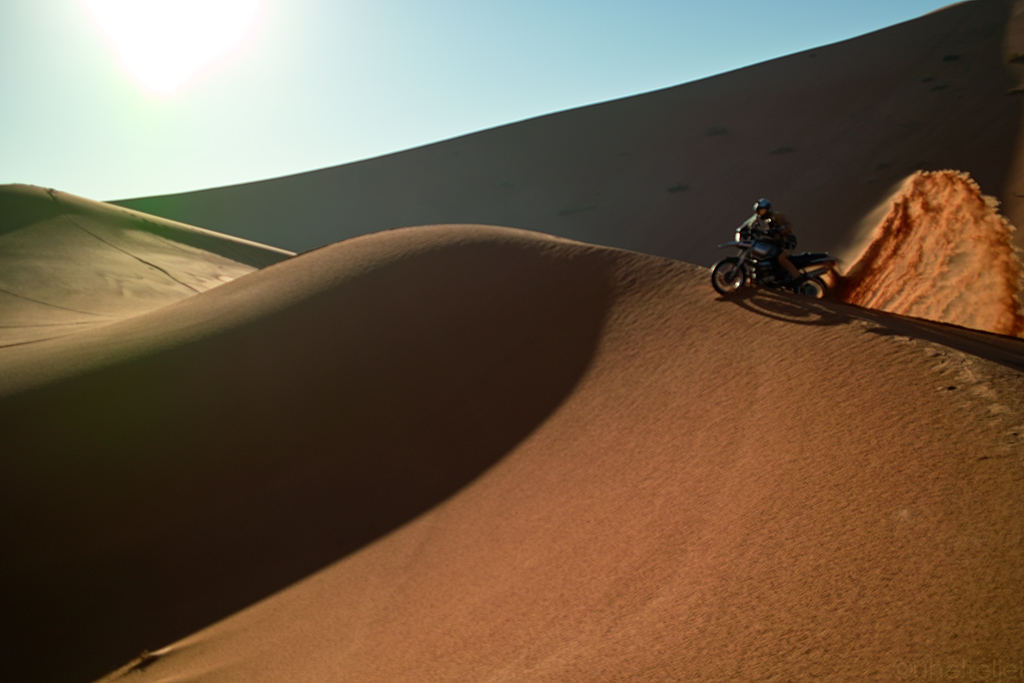
Let the boxer dig the sand.
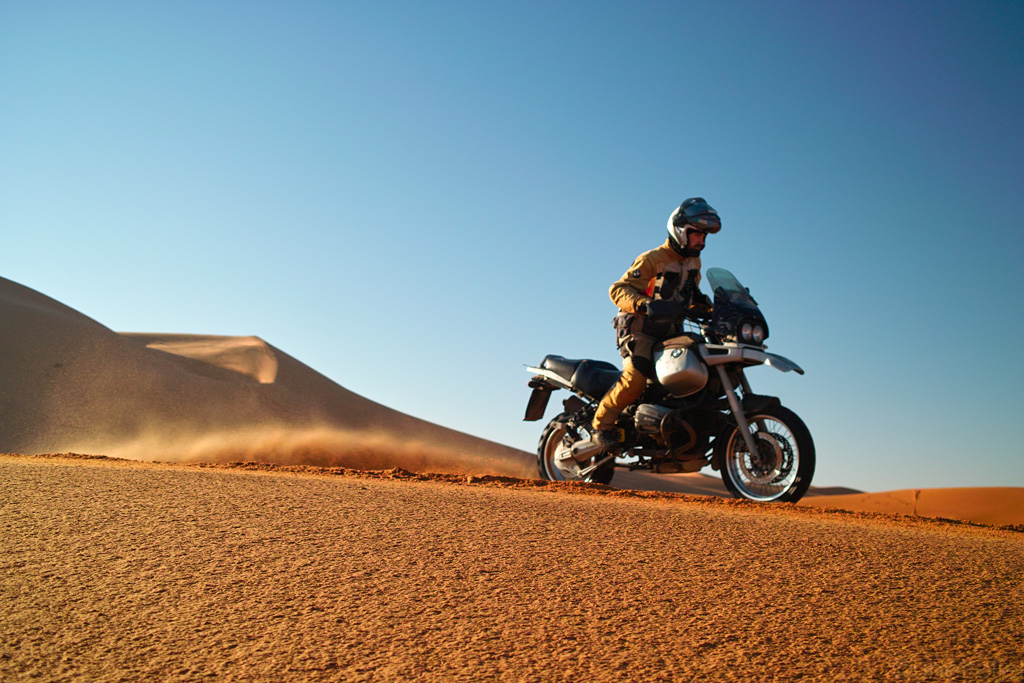
Accelerate...
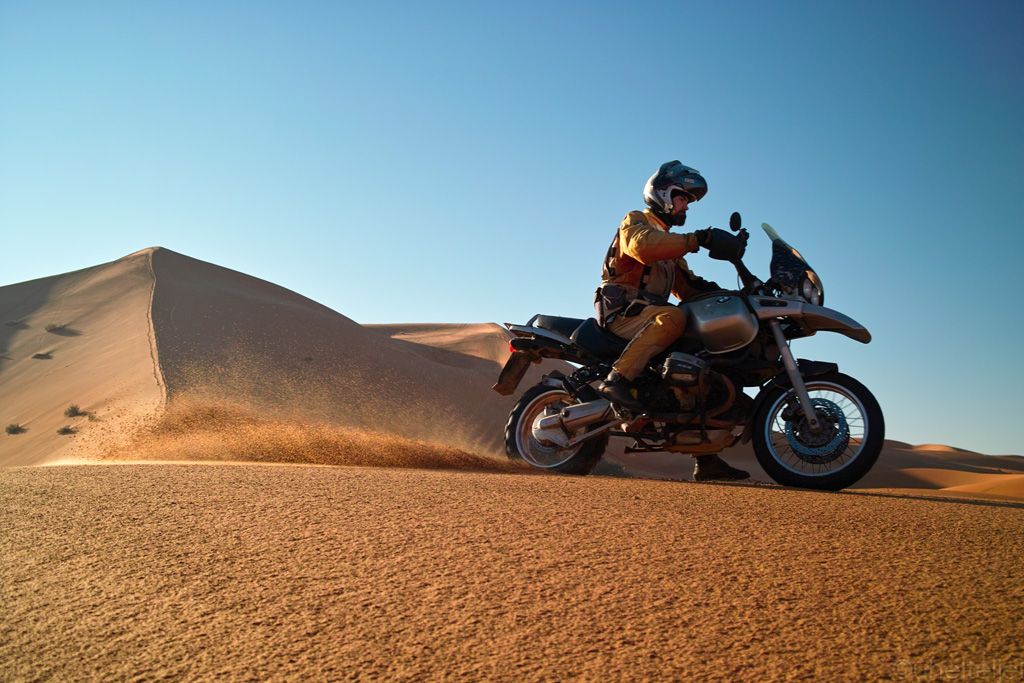
...then slide.
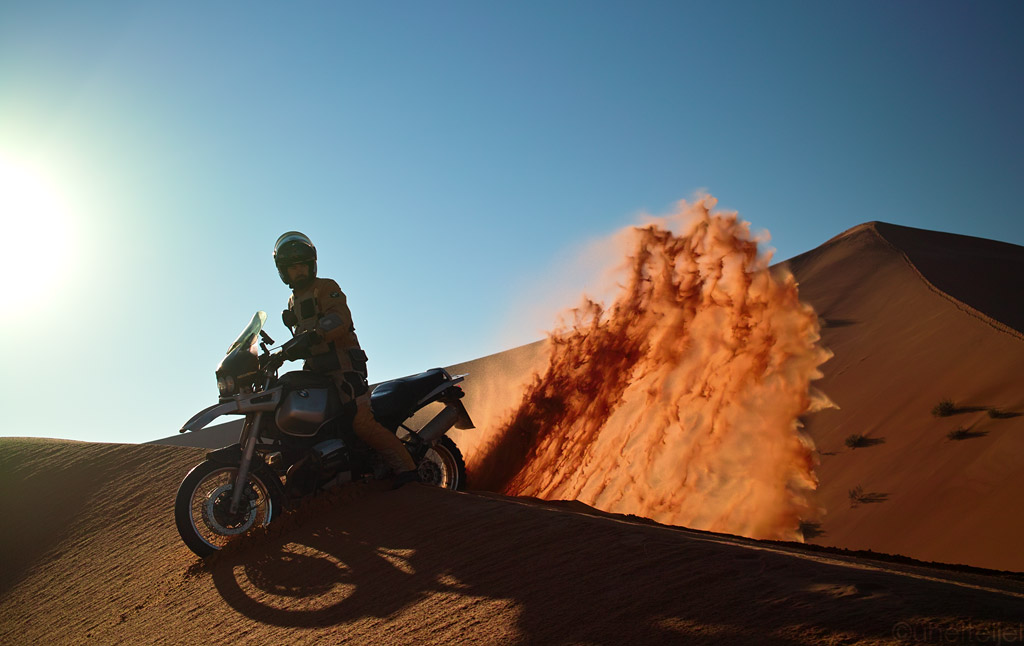
An earthly shower.
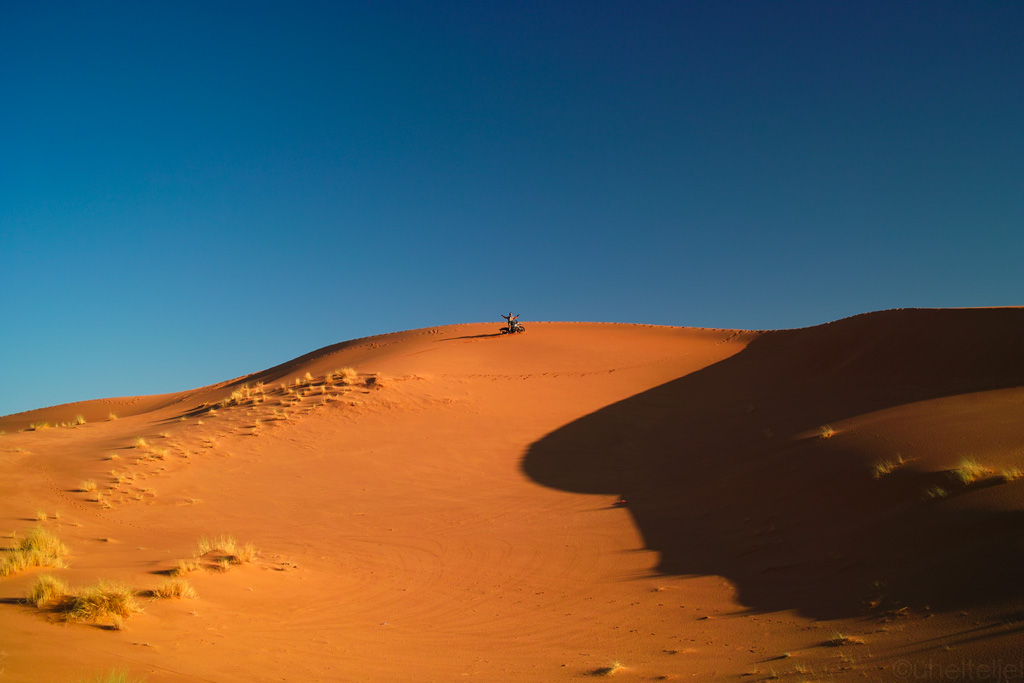
Taking this dune failed at first try.
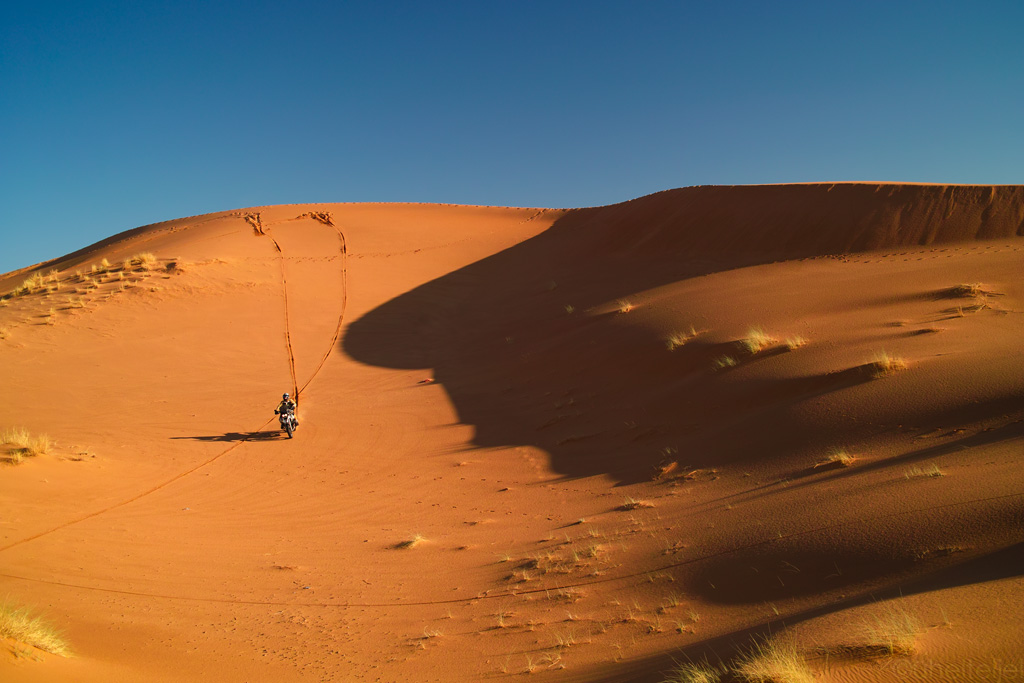
And also at second try - what goes up, must come...
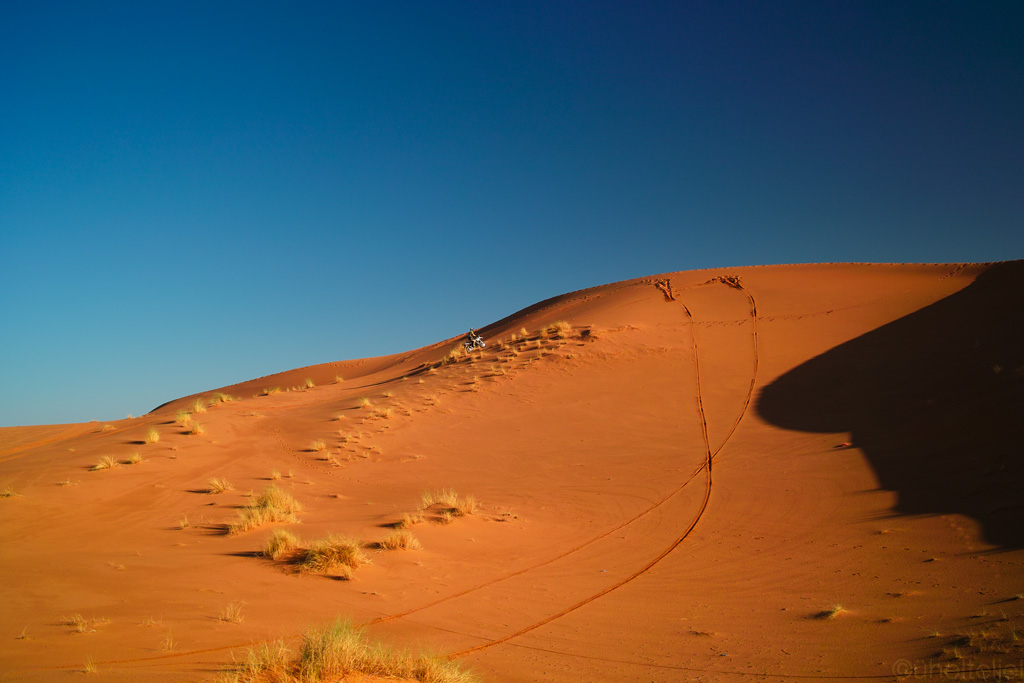
Had to find better grounds, more neutral angles and higher speeds.
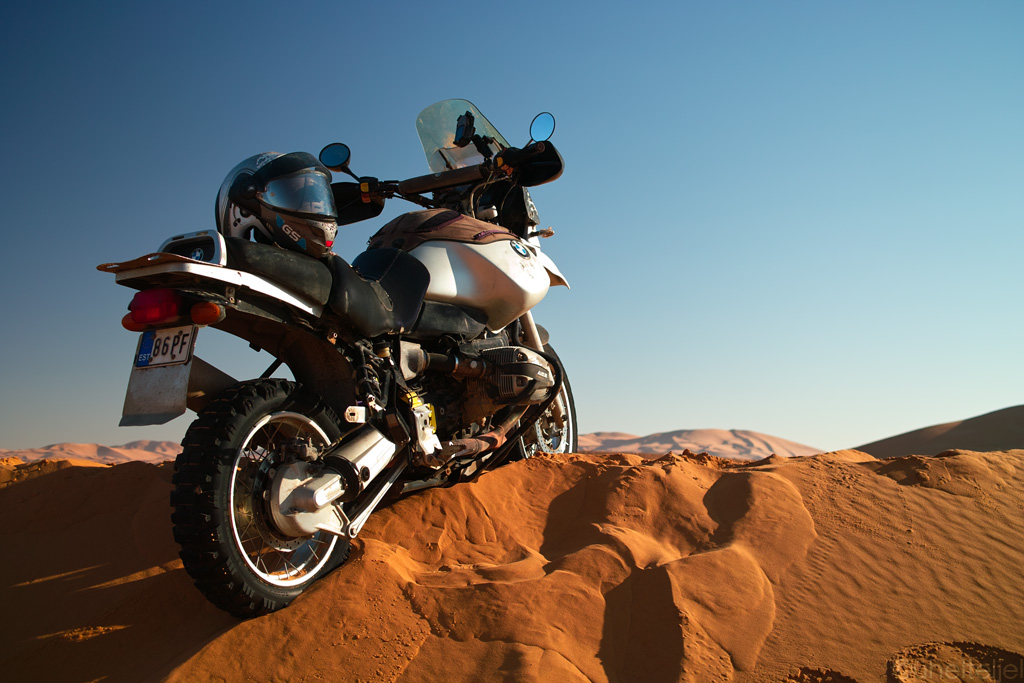
And finally up in the high dune, didn't expect to get there with those useless worn tyres.
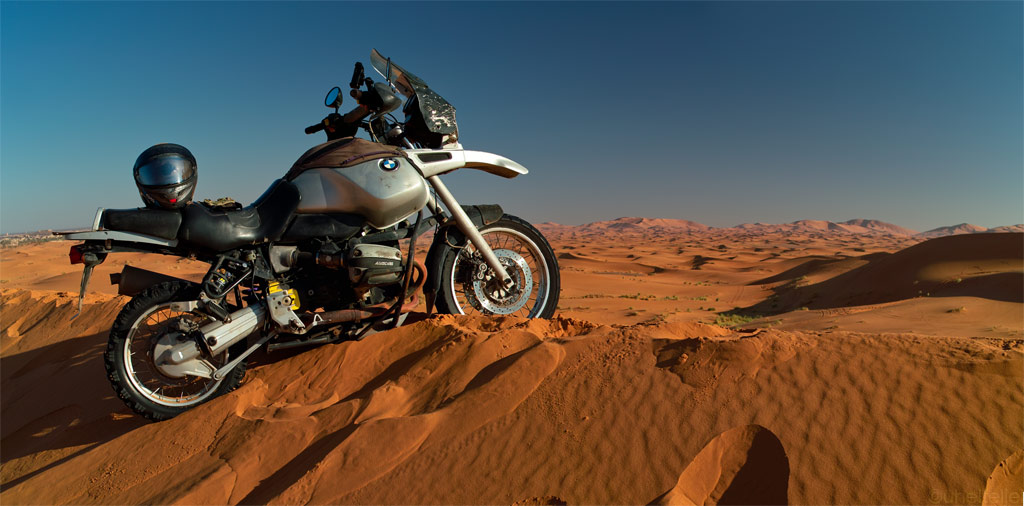
What a lovely view to the Erg Chebbi.
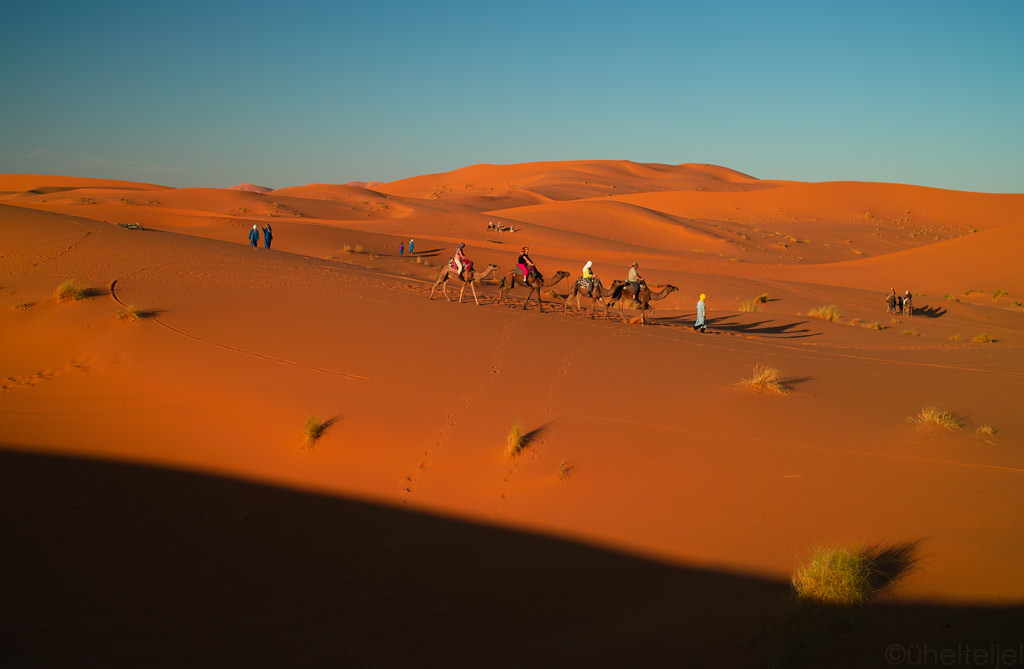
While the other tourists roamed the dunes on camels...
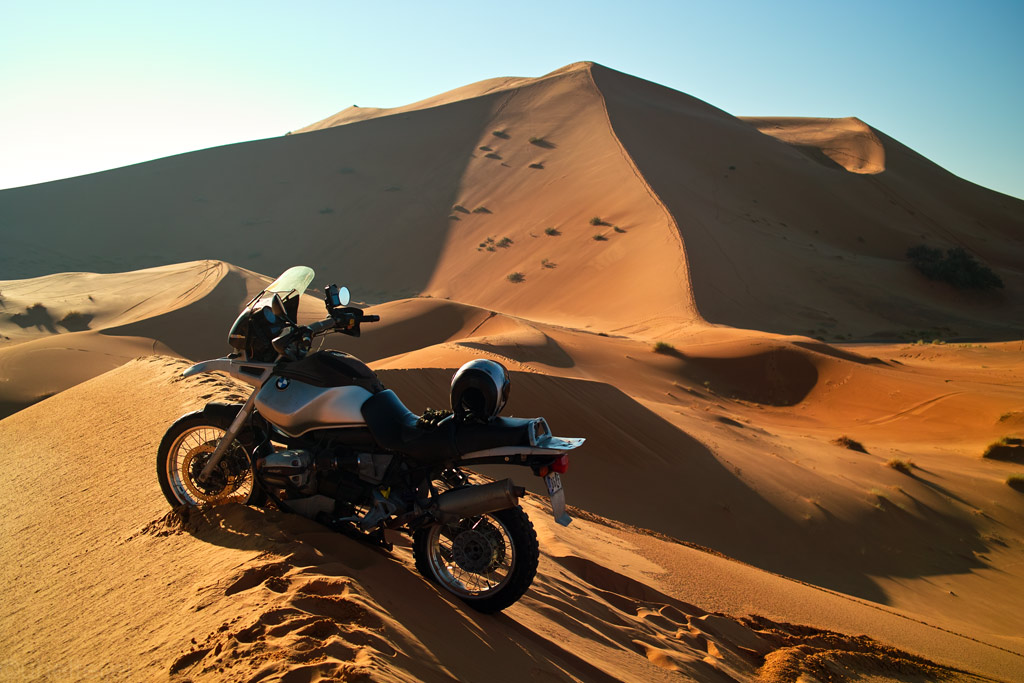
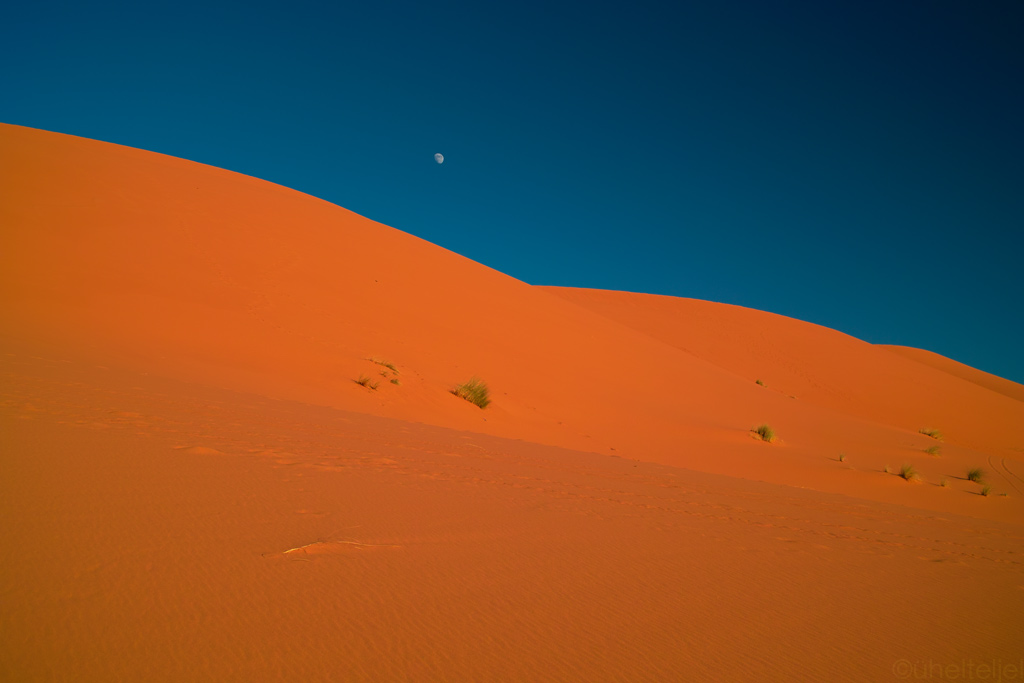
Moon and Dune.

Panorama from Erg Chebbi dunes (click to enlarge)

Panorama from Erg Chebbi during sunset - you can also see Merzouga village in the horizon (click to enlarge)
To be honest, we were not sure if we wanted to go to Marrakech at all - from what we'd heard, this ancient Moroccan capital (in fact, the country name is derived from the word "marrakech", which in Berber language means the Land of God) was infested by bus tourists and wannabe-hippies in search of hashish. No wonder a bomb exploded in a tourist café on the main square of Marrakech's medina just lately - half a year ago, killing 17 people - it must be painful to watch for the purist locals all those mini skirts and otherwise skimpy clothing that westerners unthinkably wear in this Muslim country.
Strangely enough, our foreign ministry's travel advice does not mention this incident (that clearly had tourists as a target) anymore, and there is no warning for travelling to Morocco, whereas countries like Mauritania or even Burkina Faso remain off-limits. Nothing has happened to a tourist there for a long time, but I guess a dead citizen is a far lesser problem than a kidnapped citizen…
All that taken into account, we were ready to skip Marrakech, but it just happened to be on our way, and we even ended up spending three nights there, wandering the narrow labyrinthine streets of the old medina dominated by the red hues (thus its nickname "the Red City"). We enjoyed the liveliness of the place, which regardless of all the touristiness retains its authenticity and charm, with locals going about their daily lives as if it was a long time ago - the beggar still sits there patiently awaiting for a few coins to drop (and it is mostly the locals that give alms, not foreigners - giving alms is one of the pillars of Islam), the vegetable guy still pushes his cart up and down the streets, the shoemaker still makes shoes, the public bathhouse hammam - is still being heated… The life goes on, and well into the night.
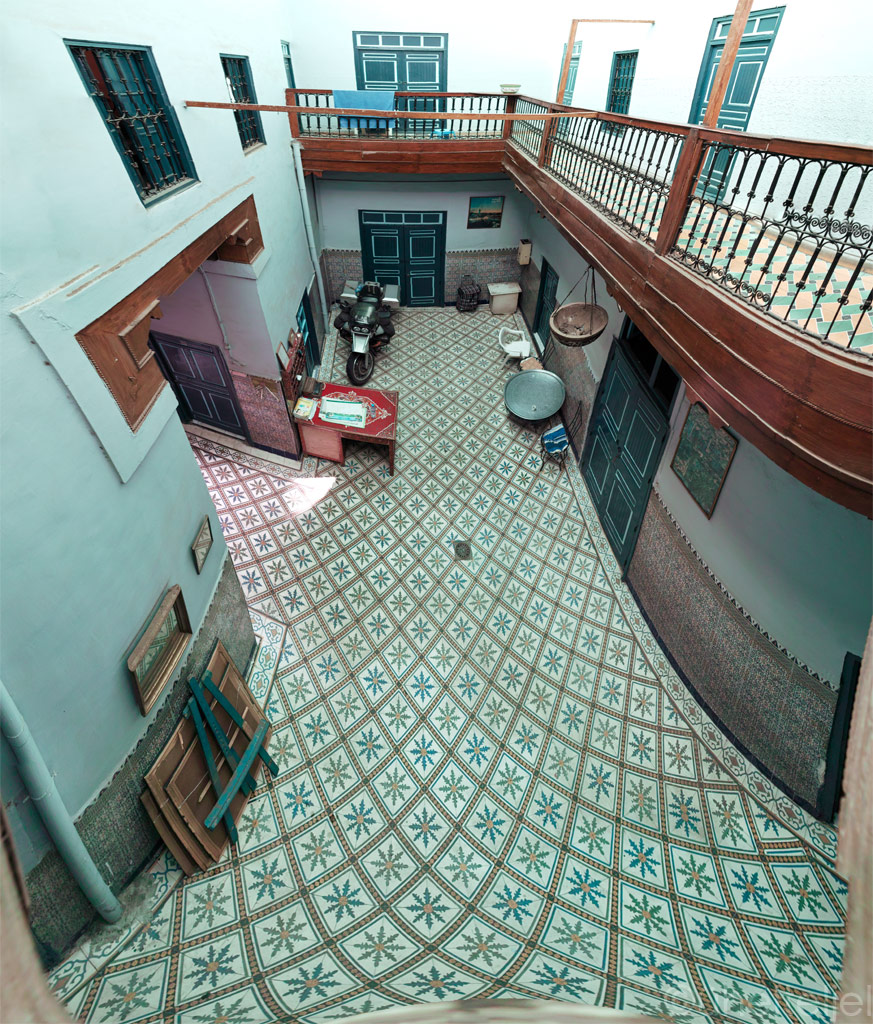
Our bike parked inside the hotel right in the medina, just behind reception desk, away from the curious hands and looks of the busy street outside.
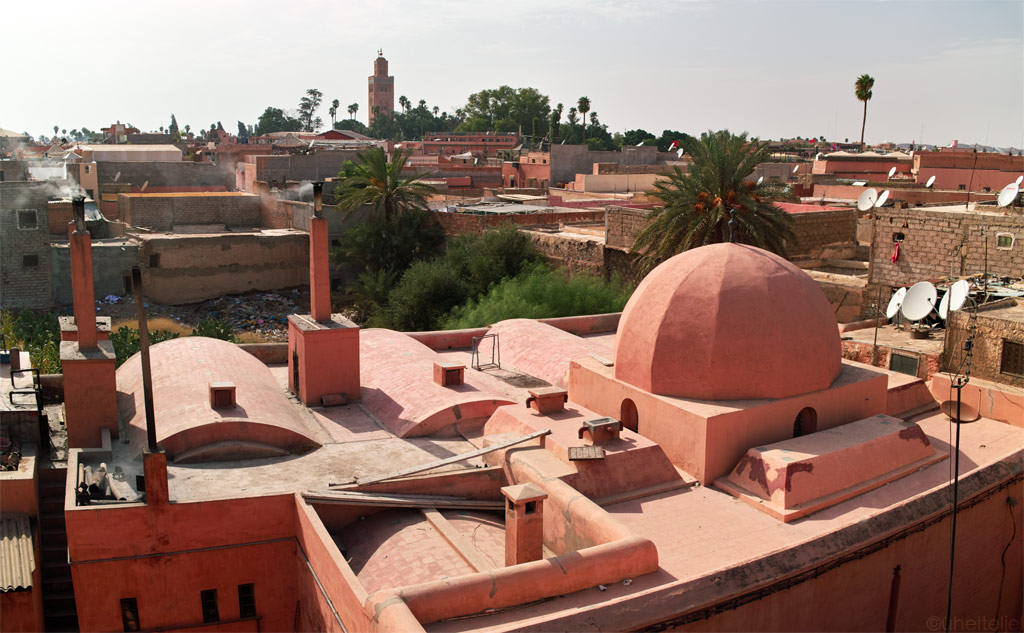
A hammam (arabian sauna) from above.

A panorama of a narrow street in Marrakech (click to enlarge).

Market stalls on the main square (click to enlarge).

Rooftop view of the medina (click to enlarge).

360 degrees of the main square, Djemaa el Fna during the day (click to enlarge).
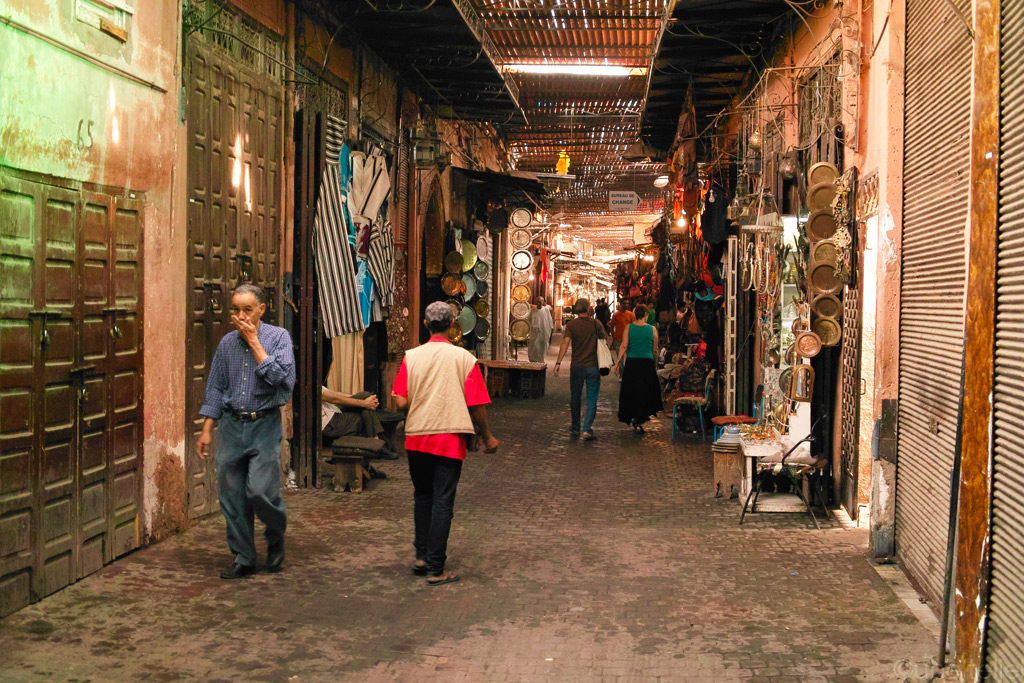
The souk (market) is just getting started for the day.
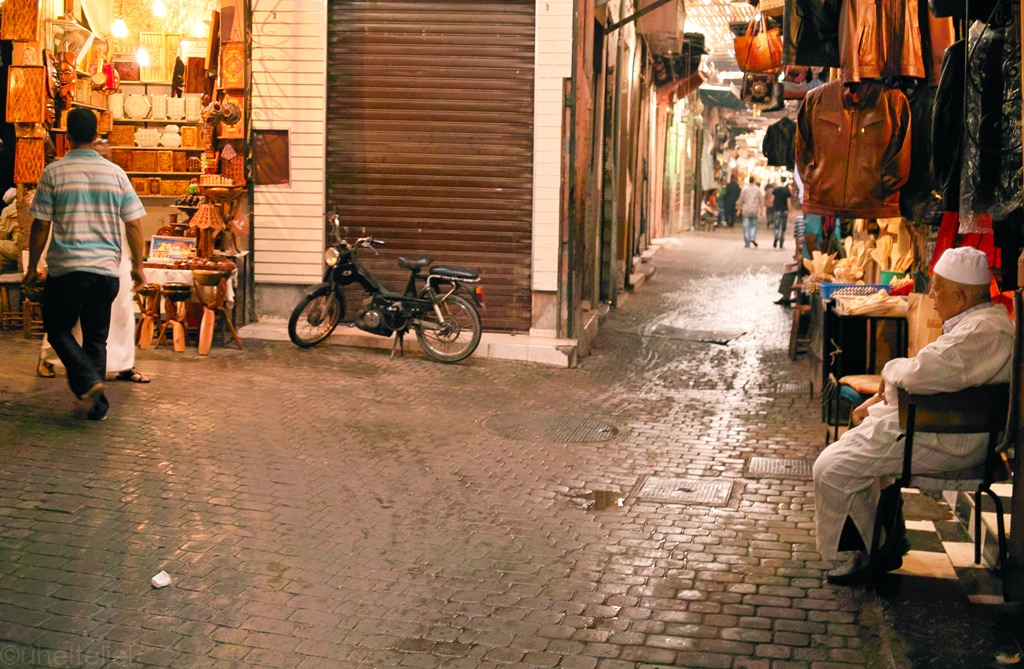
"Come and buy a leather jacket"
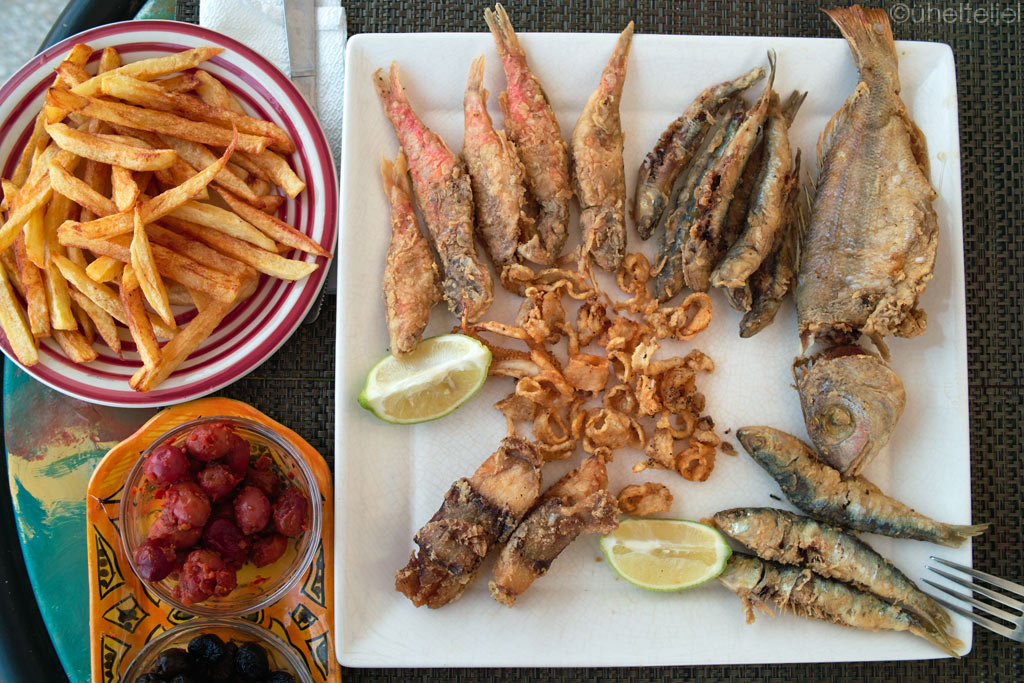
Fish and chips Morocco style.
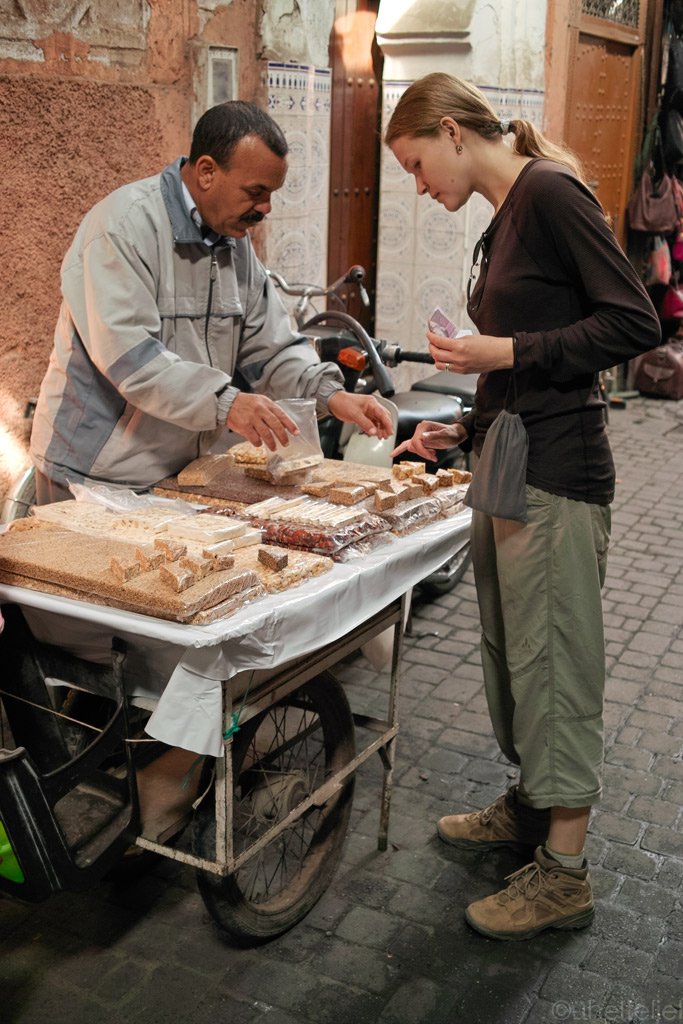
Selecting Moroccan street-sweets.
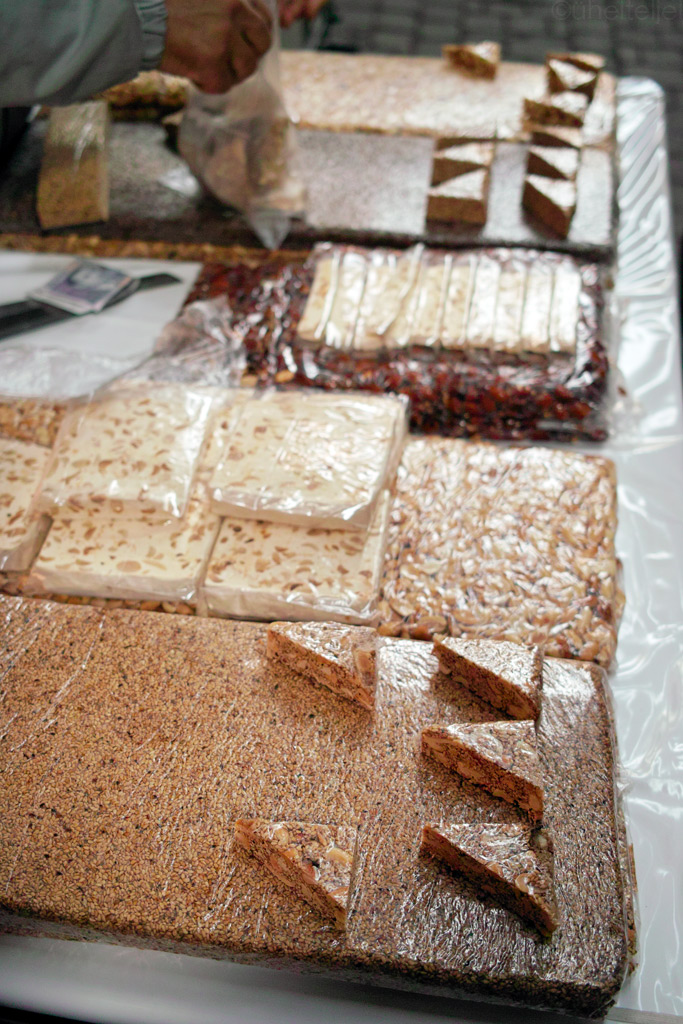
Cheap'n'Superb stuff.
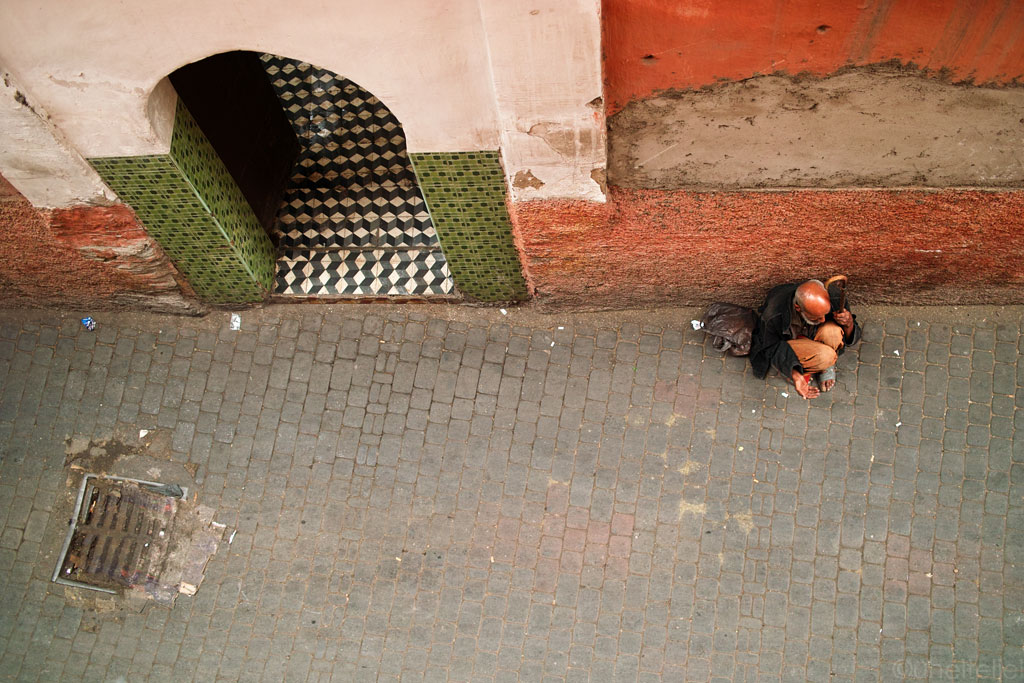
A beggar, patiently waiting before his grandchildren come late in the day, count the money he's earned, sit him in a wheel chair and take the old man home.
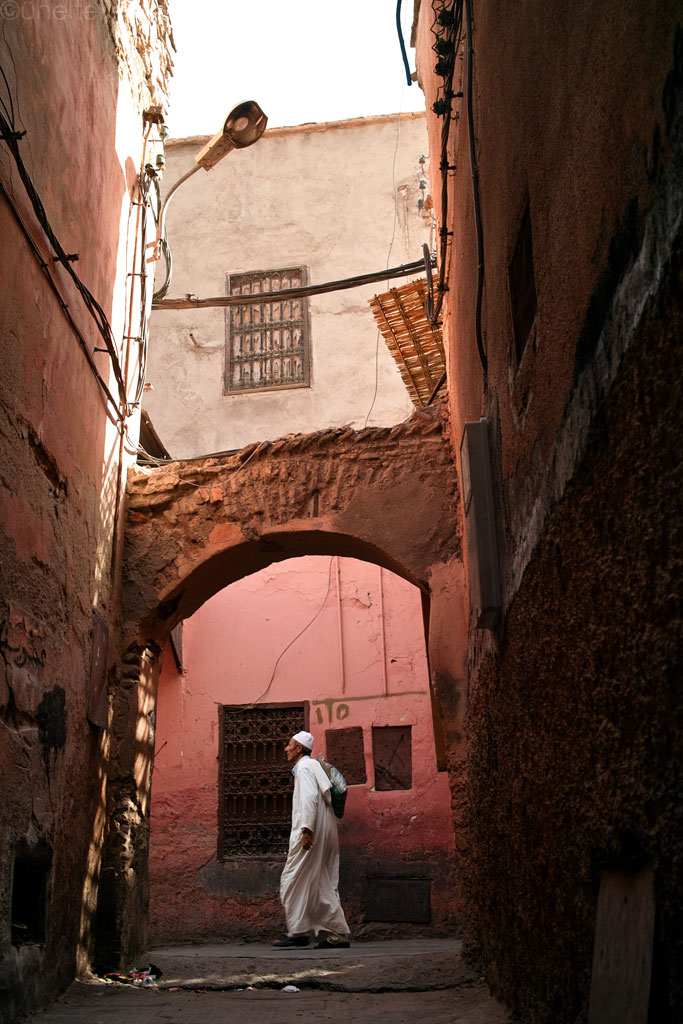
The Red City.
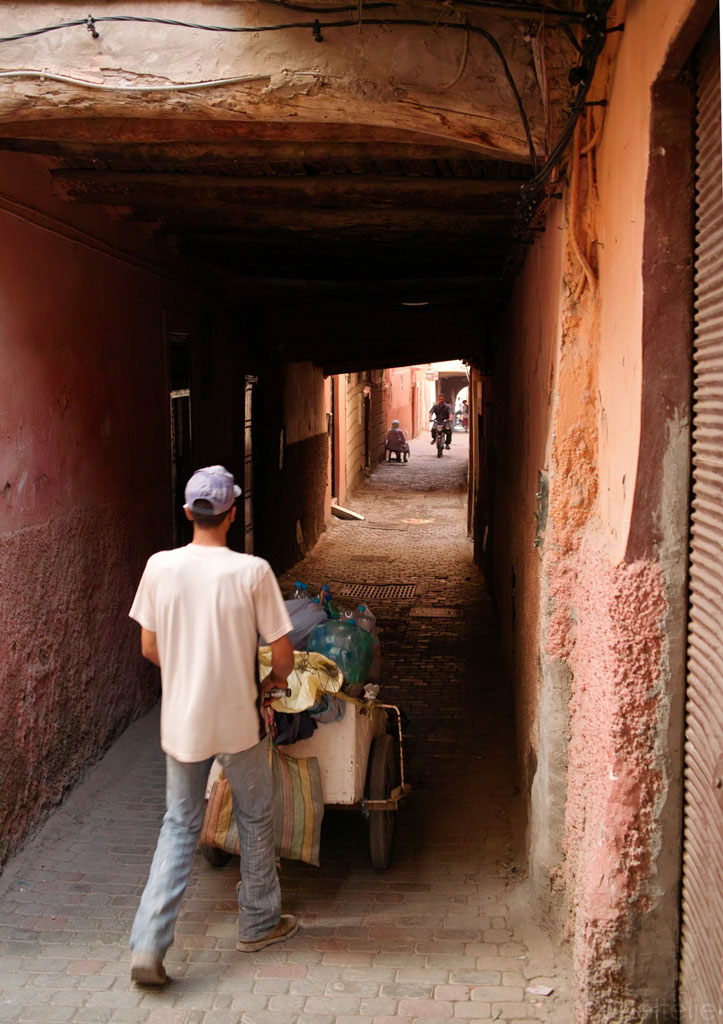
… in action.
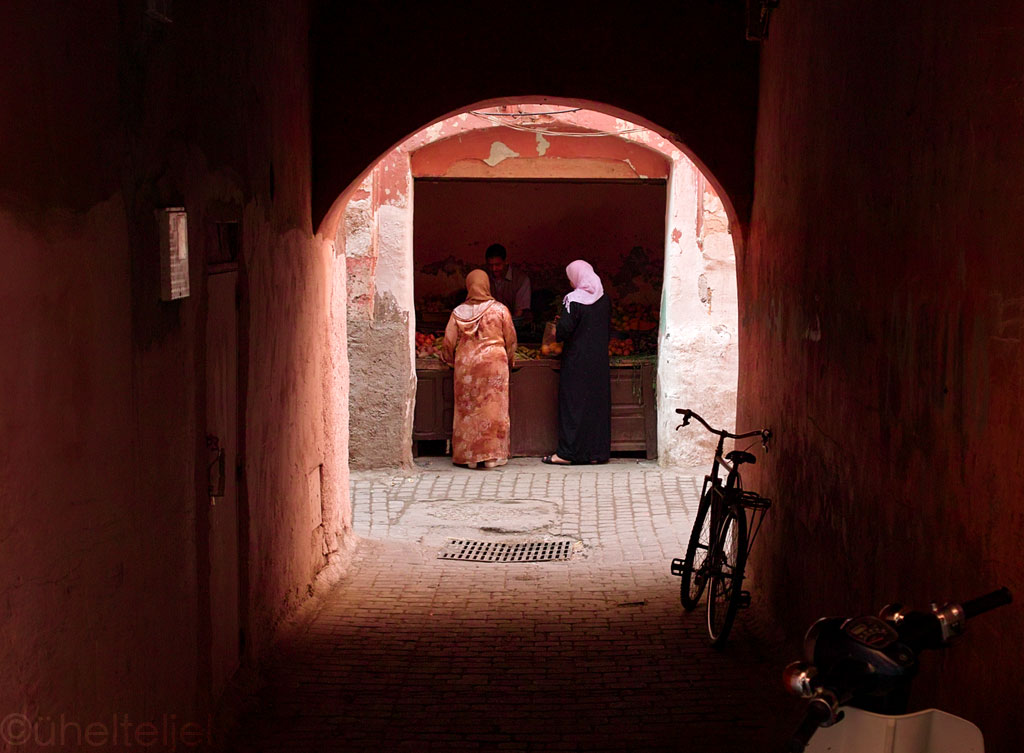
Ladyes buying fresh stuff.
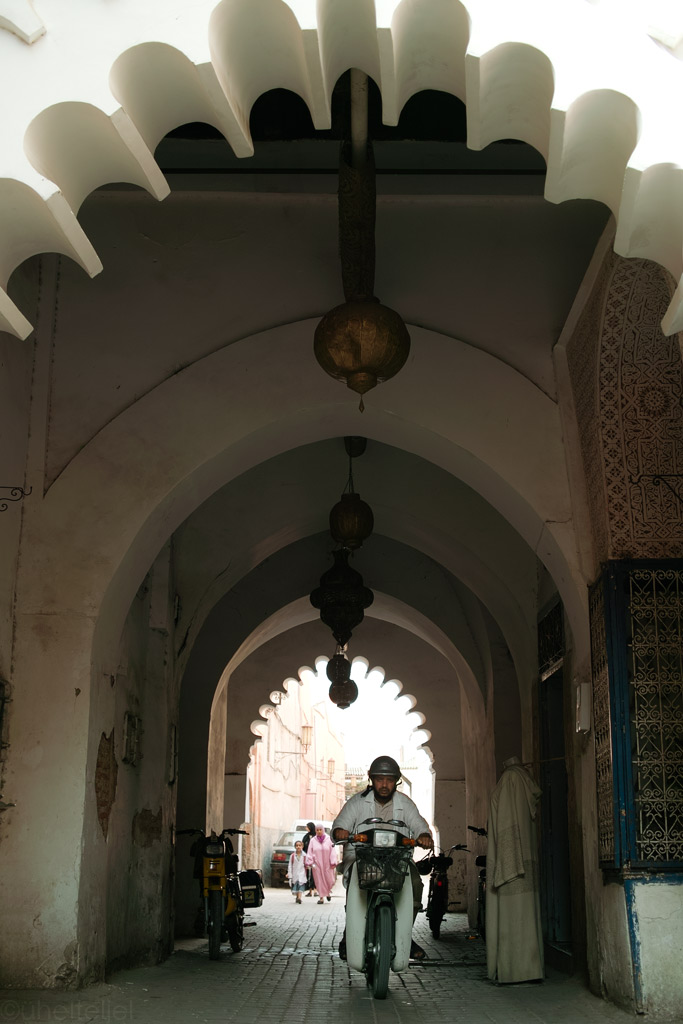
Arches and a mulla on a scooter.
At night, the big action moves to the main square, Djemaa el Fna, where tens of restaurants offer Moroccan specialities and countless stalls sell fresh, delicious orange juice for just 4 dirhams (50 cents) a glass. But what is the most fascinating, is the nightly "freak show" as it is often called, of musicians, actors, snake charmers, etc trying to earn their buck (actually outright demanding it even if you ony happen to be passing by). Just listen!
...::: LISTEN Djema el Fna live musical performances from 6 different local bands :::...
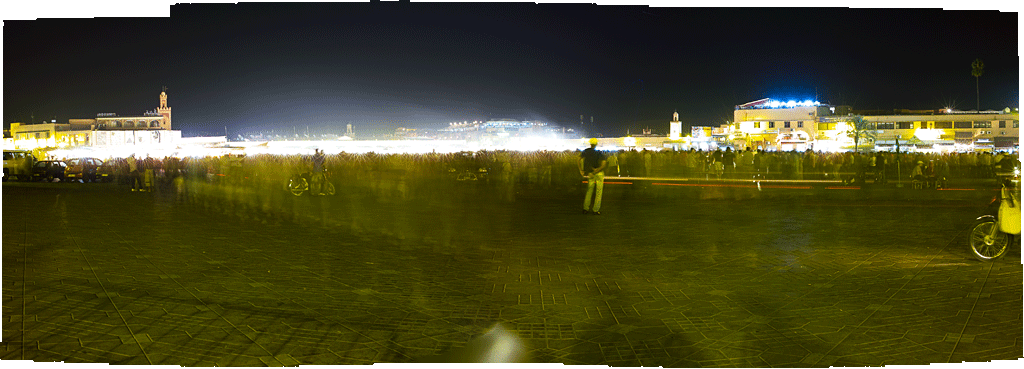
Djemaa el Fna at night with smoke rising from the open-air restaurants (click to enlarge).

Rooftop view at night (click to enlarge).
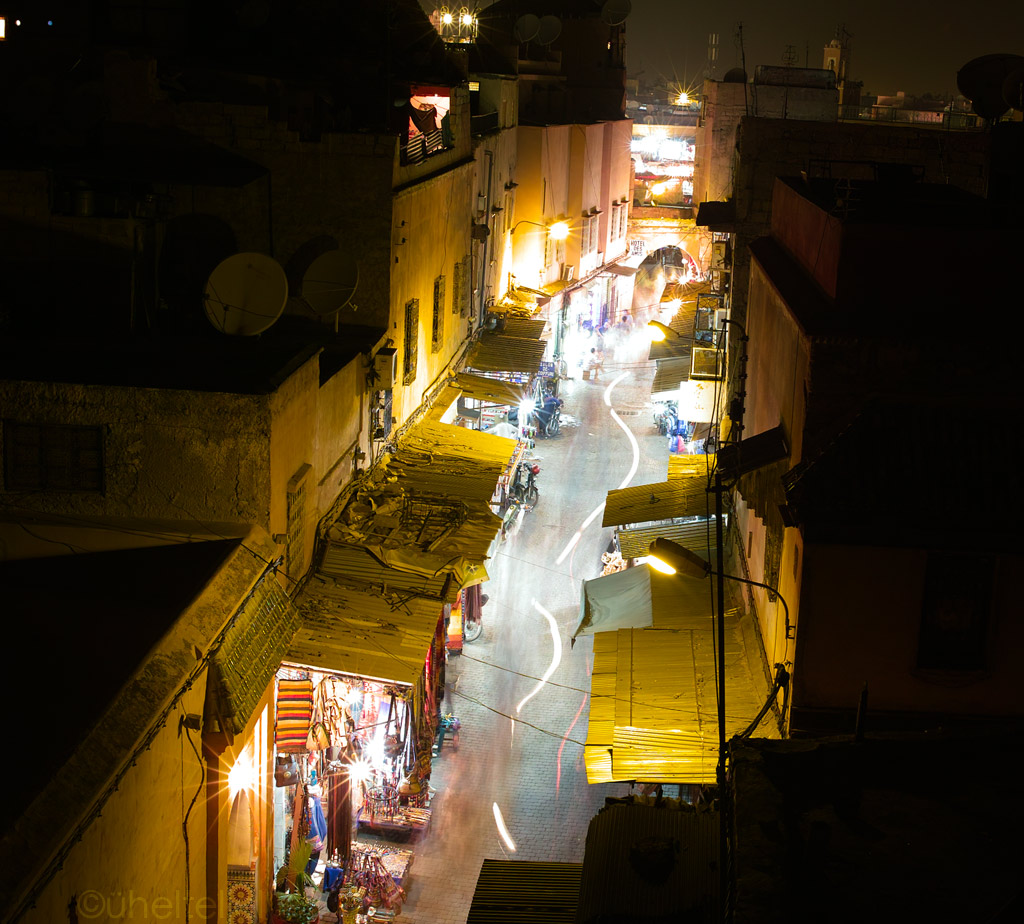
A street at night.
Before we left Marrakech we got done a mechanical job that was becoming more and more critical - replaced the swingarm bush that keeps the rear suspension in place. Went to a Land Rover workshop which naturally did not have the right tools, but with a little bit of improvisation (that the life in the third world is all about), the local mechanics got the old one out and the new one in. A little bit of peace of mind restored…
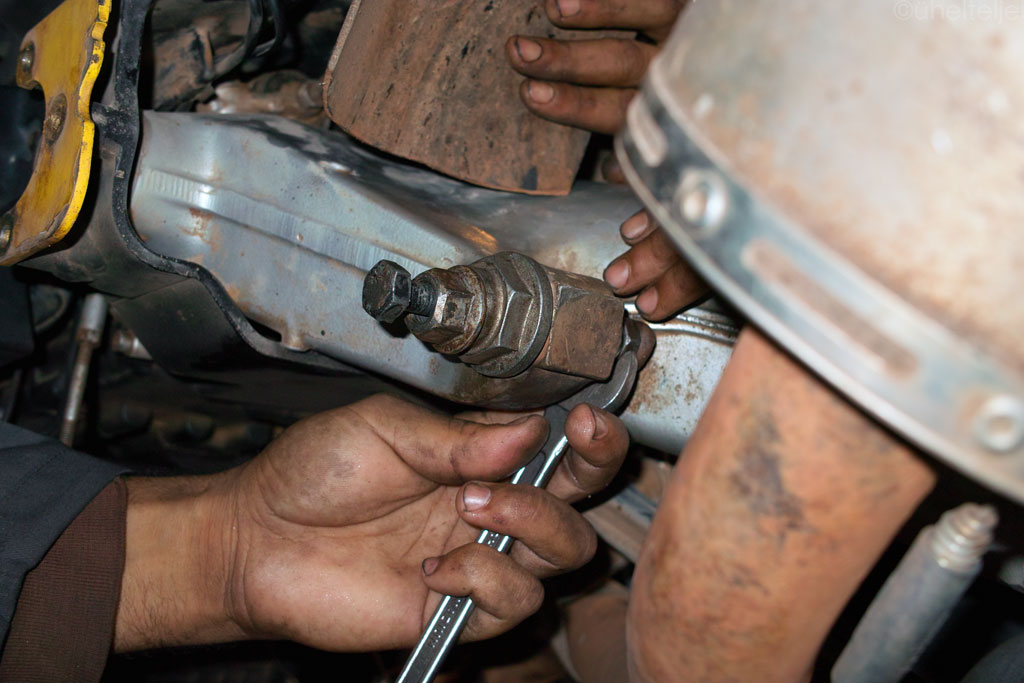
Pulling out the old bush by using a self-made puller.
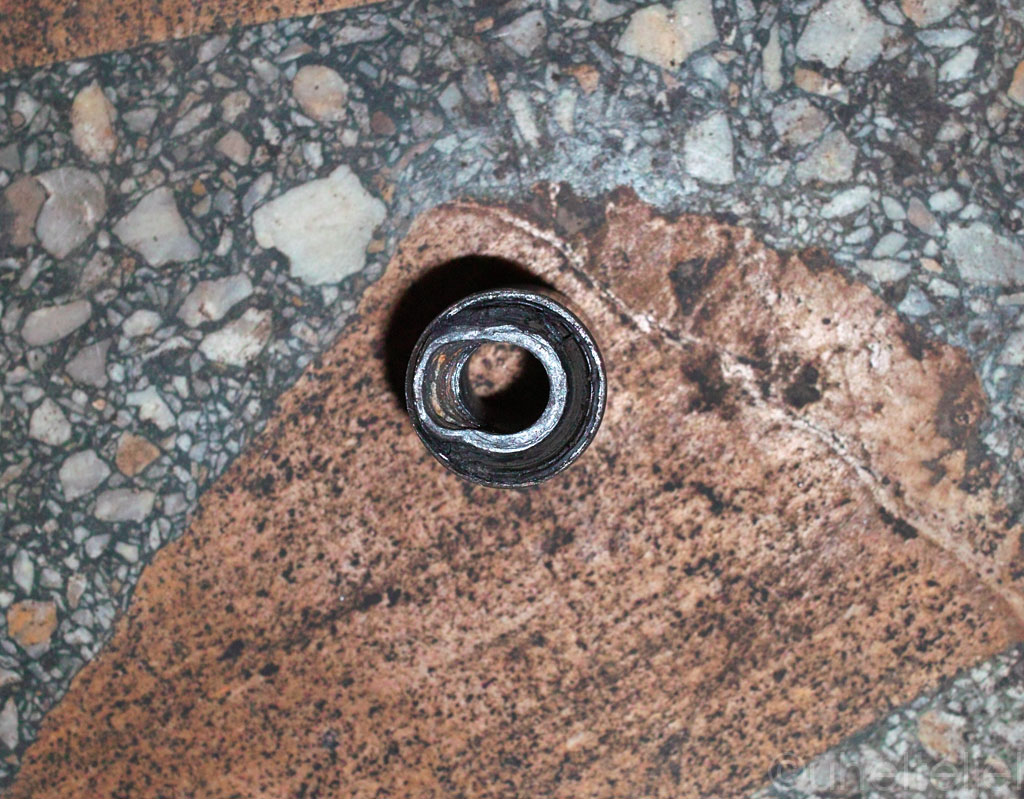
The deformed bush that ate quite a few of bolts on our way from South Africa.
My main interest in Morocco was actually not the sand nor the ancient medinas, but the mountains. The last time we had experienced real mountains was in Lesotho, and it was a long time ago, so I was anxious to explore the curvy roads running though the Atlas mountains.
Although the highest point of the Atlas reaches beyond four thousand meters, the average altitudes are relatively low and in the early autumn - which is the time we visited Morocco - you'd be extremely lucky to see any snow covering the mountain tops. Being one of the oldest mountain chains in the world, the Atlas mountains have a rather quiet charm quite different from that of young mountains such as the Himalayas for example. It feels as if the time passes at a different pace here.
Also, the way the people (mostly Berbers) live here, feels slow and tuned to the surroundings, with mud houses dotting the falleys filled with verdant date palms that snake alongside the rivers.
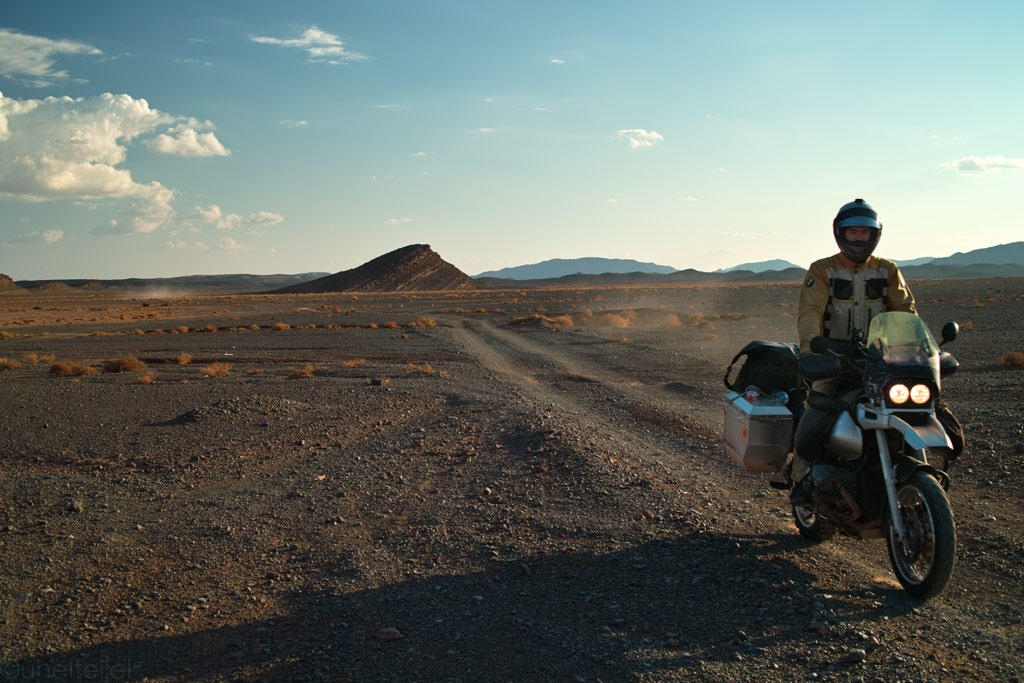
Trails through the worn landscape.
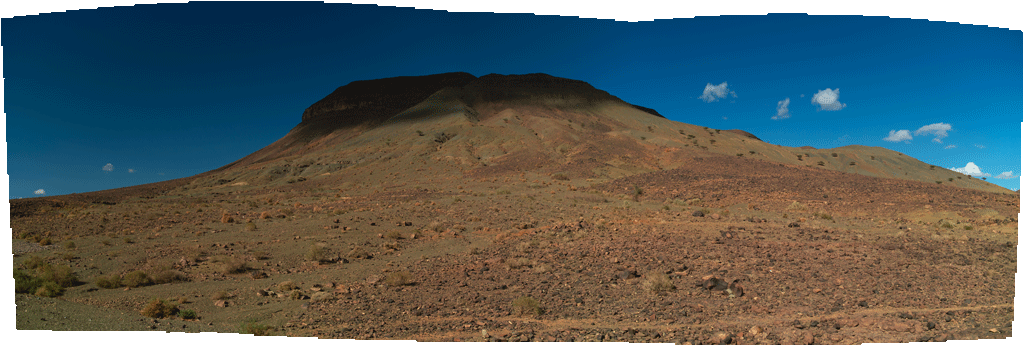
A hilltop in the shade.
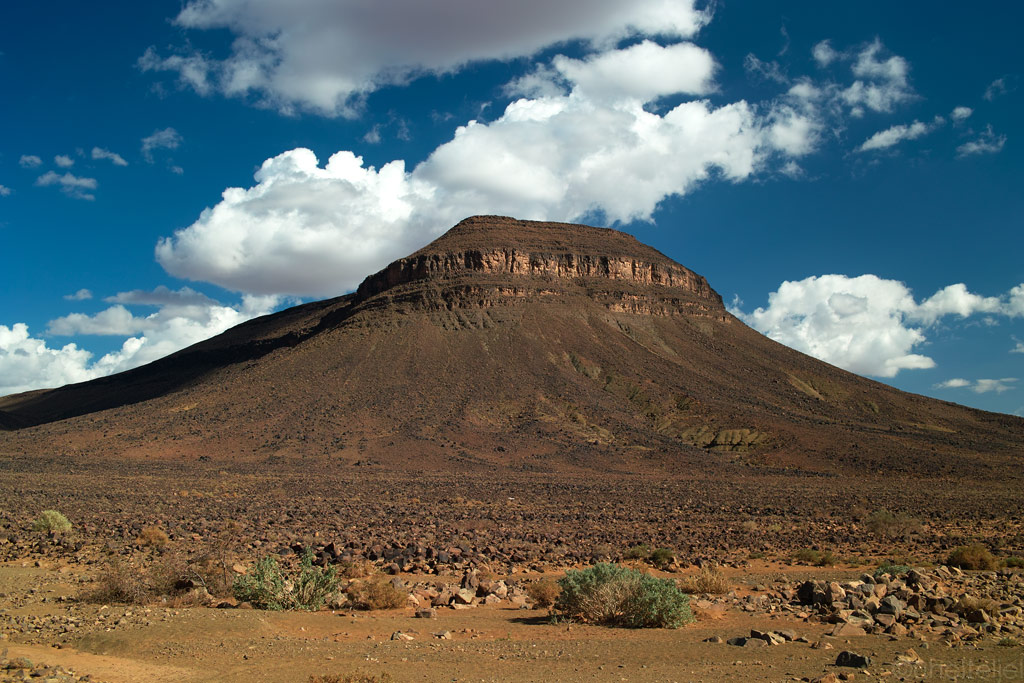
Crumbling into dust.
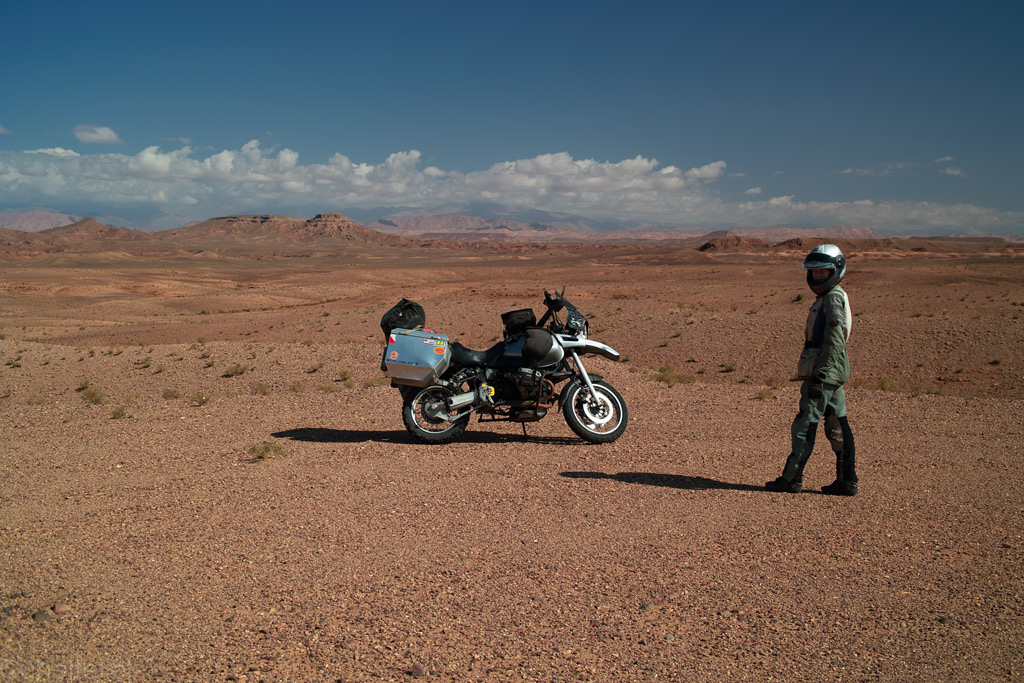
Mountains in the distance.
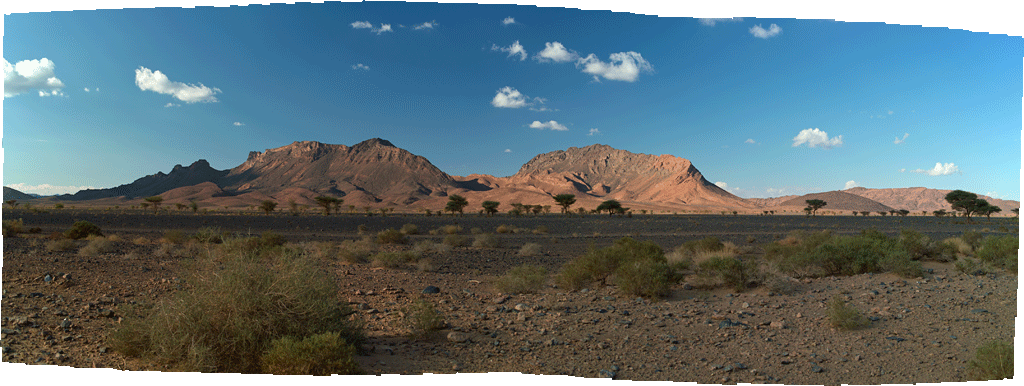
Panorama of the Atlas mountains (click to enlarge).

Ruins of an old village above an oasis (click to enlarge).
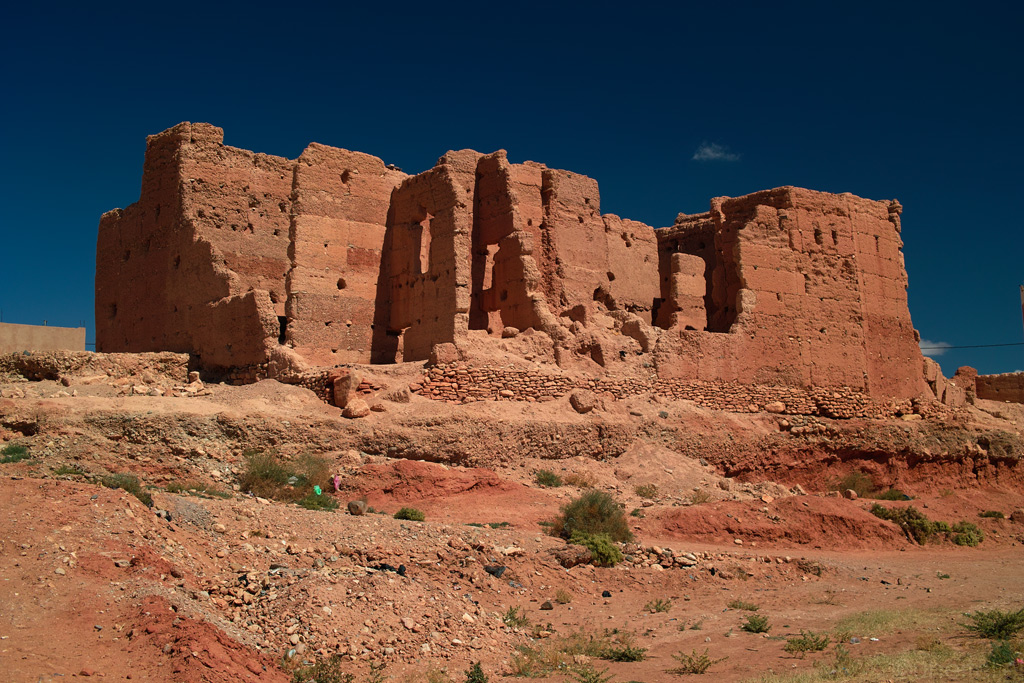
Crumbling old.

Moroccan landscape close to the Algerian border (click to enlarge)

Fields and palmtrees nestled between the hills (click to enlarge).
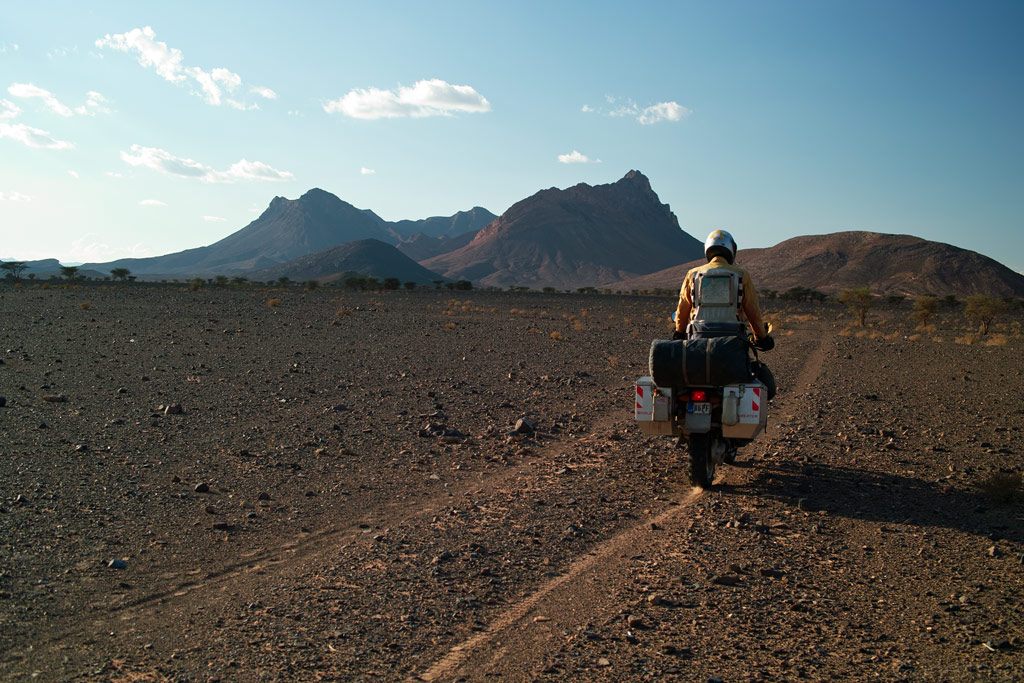
Lunar landscape.

Old and lonely (click to enlarge).

Living in tune with the nature (click to enlarge).

Typical view of the landscape in harmony with architecture (click to enlarge).

Date palm plantation snaking in the bottom of the valley (click to enlarge).
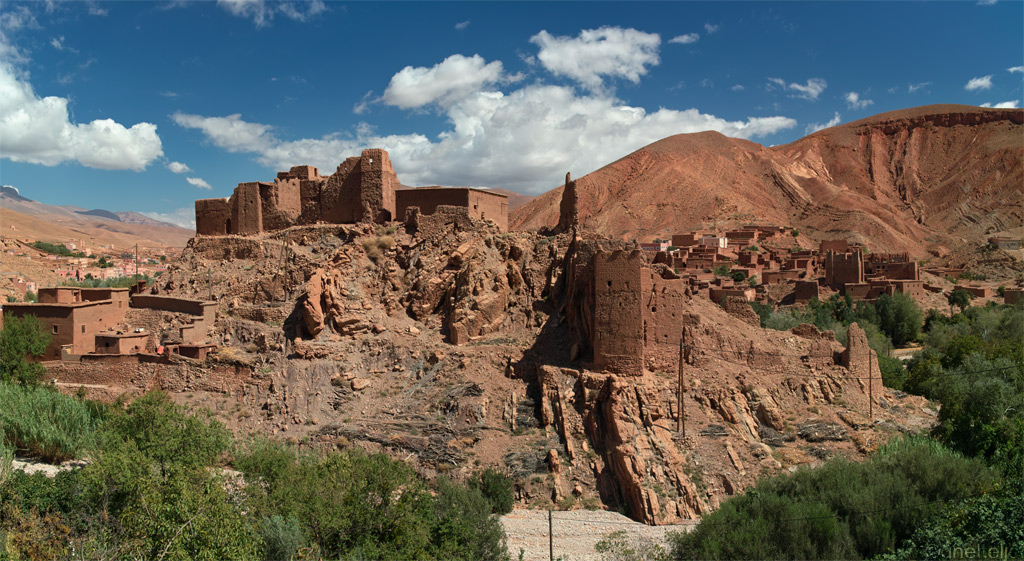
A typical mountain village in the Atlas.
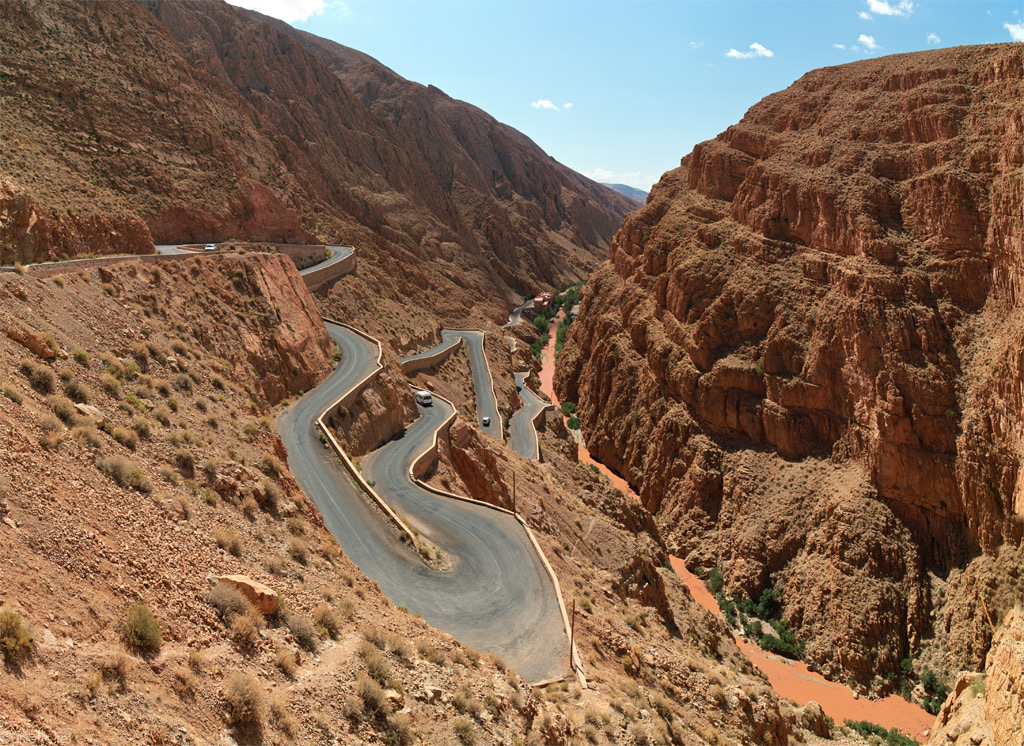
Zig-zagging up (or down) the mountain (click to enlarge).

Panorama of the mighty Atlas mountains (click to enlarge).

The Atlas (click to enlarge).
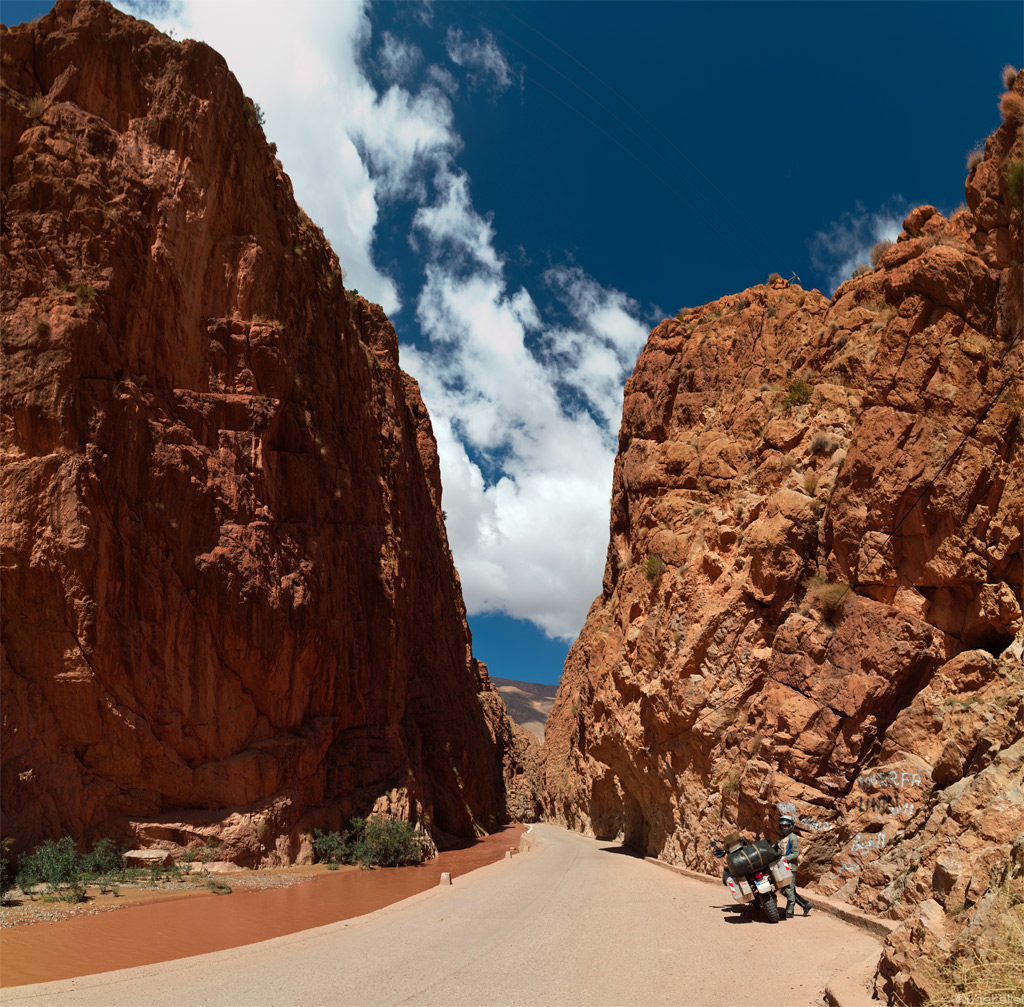
Bottom of a canyon.
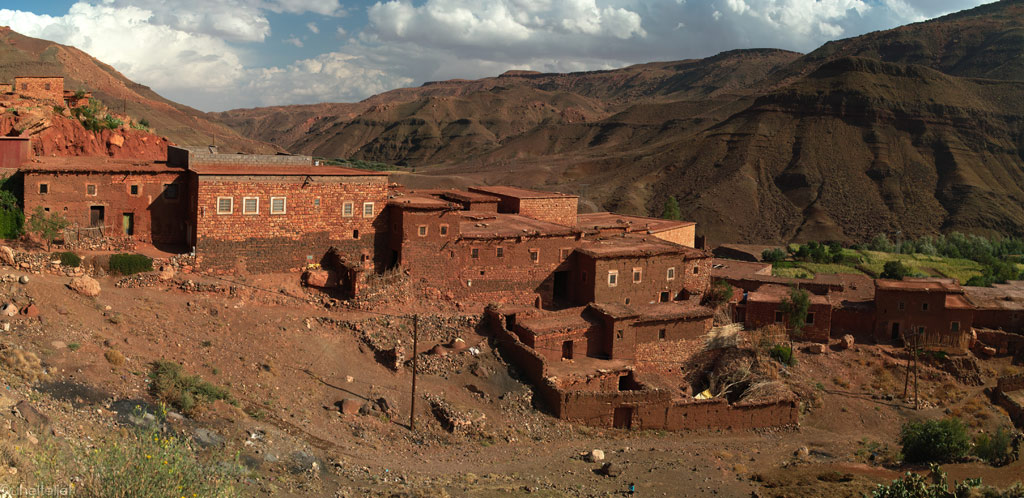
A mountain village.

Artwork (click to enlarge).
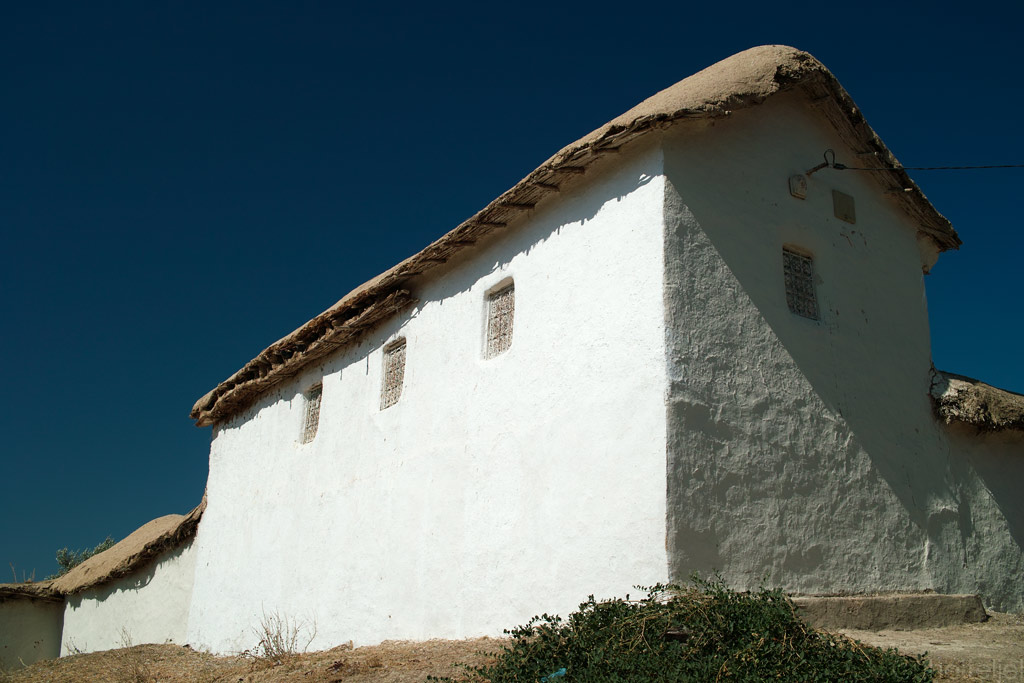
Countryhouse.
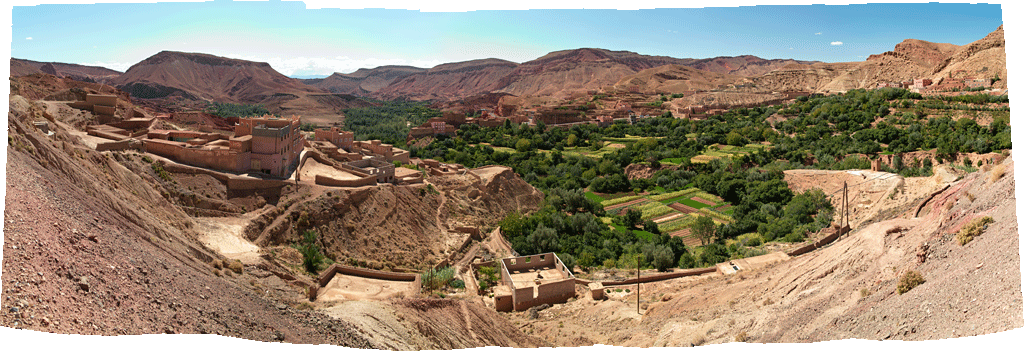
Life in the mountains (click to enlarge).

Oasis (click to enlarge).

Fields in the foreground, Ait Ben Haddou in the back (click to enlarge).
The spectacle coming to an end, Morocco was destined to be the grand finale, and we were eager to take the most of it - to see and do as much as we possibly could before turning the page, returning to Europe. Afterall, crossing the Gibraltar strait would, symbolically speaking, be like standing up from your spectator seat, stretching your legs, going to the wardrobe to retrieve your outerwear and exiting into the elements of the real world, head full of new, unprocessed ideas and emotions.
One thing that Kariina definitely wanted to see while still in Morocco, was one of the best preserved medieval towns in the world - the medina of Fes, but as things go, we've learned not to make definitive plans and not to get our expectations too high, because it is very rare that things actually go according to plans (especially in Africa). I guess what travelling teaches you is that in order to enjoy yourself, you really have to be flexible and adaptive. Thus we tried not to bee excessively disappointed when we arrived in Fes only to find out that the old town was closed to traffic and there was no chance we could park ourselves and the bike in a cheap guesthouse in the medina and go and get lost in the labyrinthine streets just as we had done in Marrakech.
But since we were there, we had to make some sort of a compromise. Instead of aimless wandering we had to carefully select the spots we'd want to see and try to locate them on foot while the bike was parked on the outskirts of the old town. One of such spots was the tanneries - possibly one of the most intense visual and aromatic experiences around, where animal skins are being tanned in huge pots of liquid that gives them different colours, and later dried on the rooftops in the bright sun.
...::: LISTEN local radio playing arabic music :::...

Panorama of Fes from above (click to enlarge).
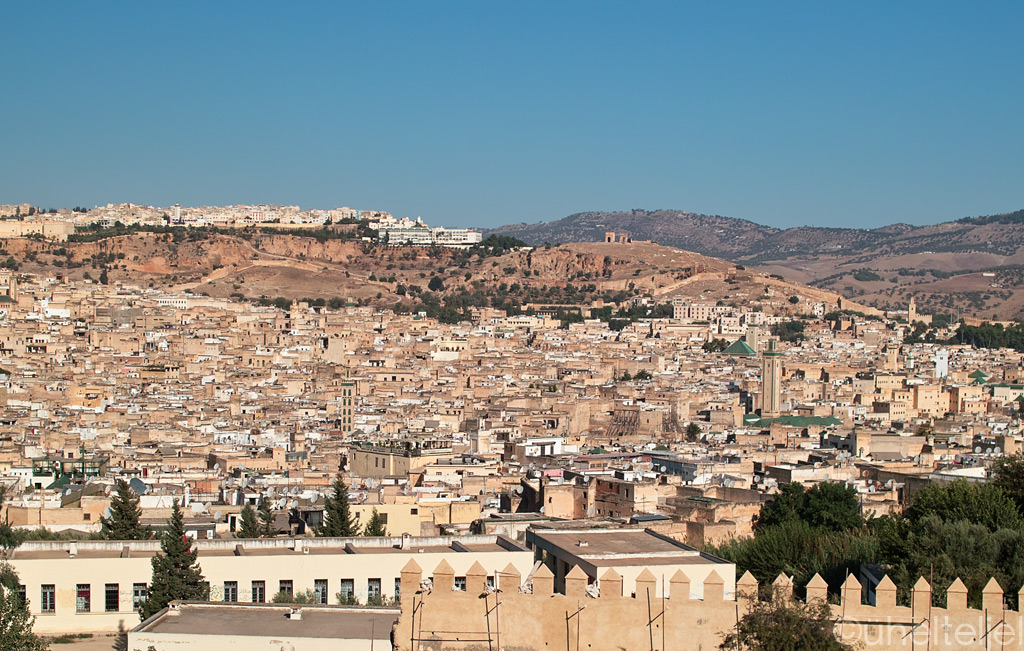
Closely side by side.
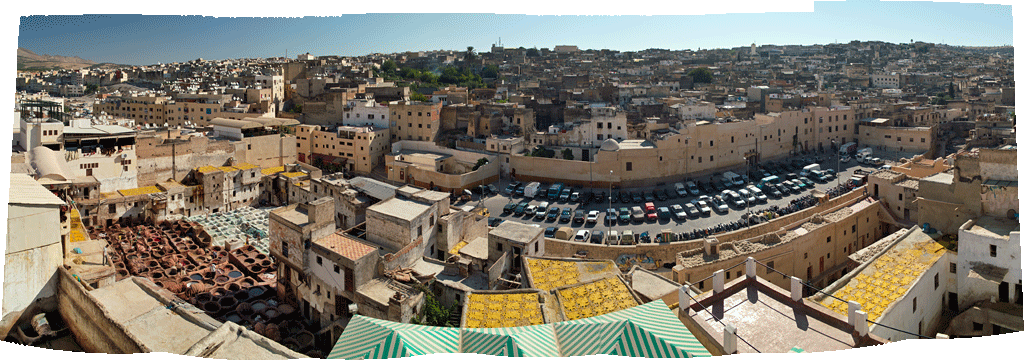
To the left is the tannery, to the right you can see drying animal skins freshly tanned with saffron-based dye (click to enlarge).
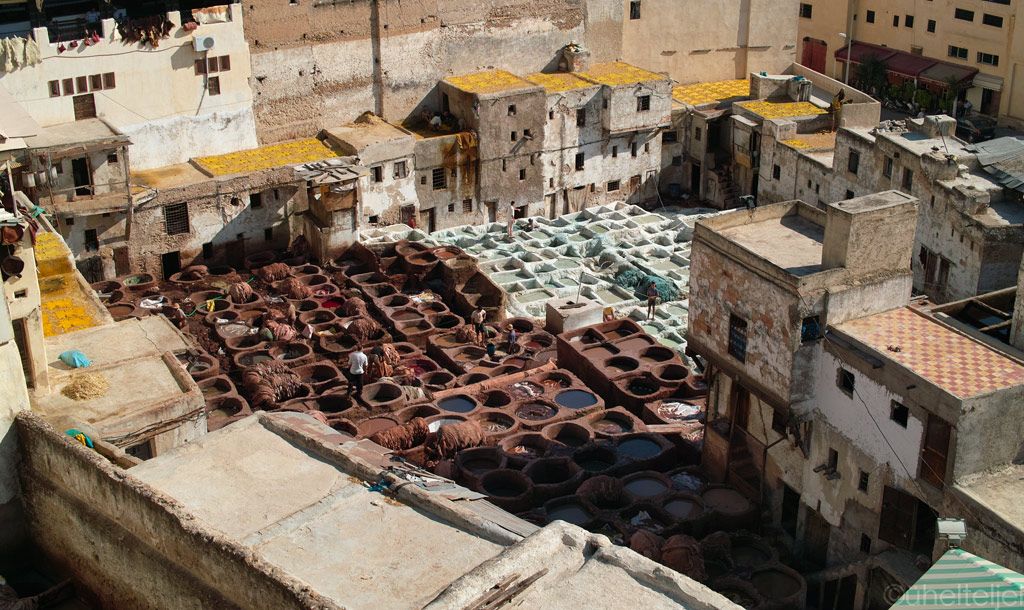
The colourpots for life.
From Fes we headed straight north, in the direction of the town by the name of Chefchaouen, known also as the "Blue City" - not sure why, but most of the buildings in the old part of town are painted blue. And not just blue but different hues of blue, so that as you walk in the streets, you really experience different emotions, baby blue houses radiating a sense of security, acid blue walls making you feel as if you were at a nightclub, and faint blue pavement resembling the sky. Unfortunately I must say that the pictures do not quite capture this extraordinary experience.
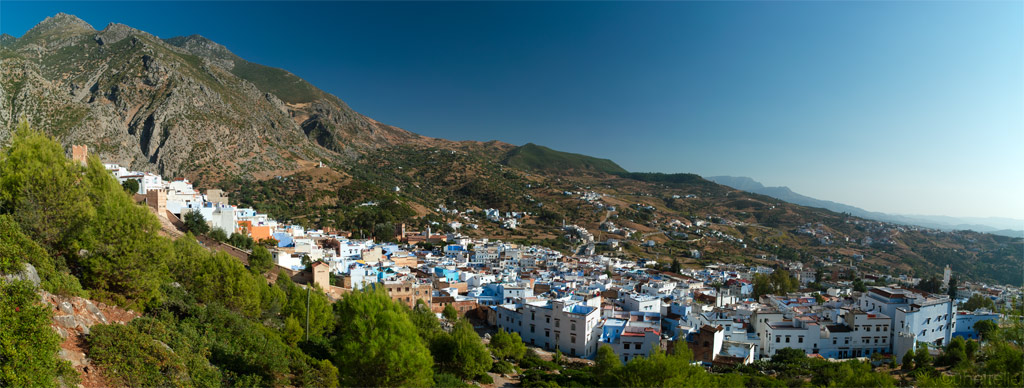
The town of Chefchaouen from above (click to enlarge).
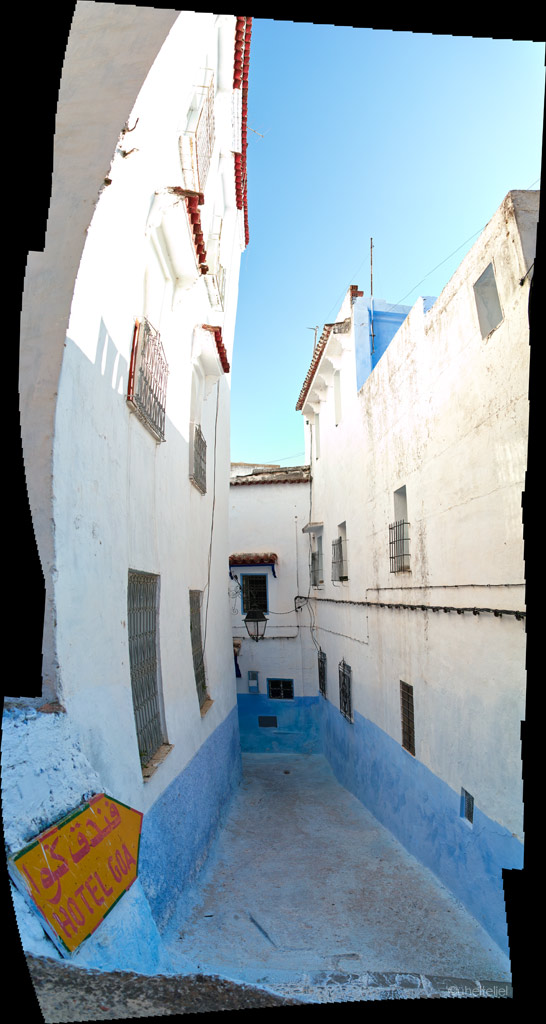
A street of Chefchaouen.
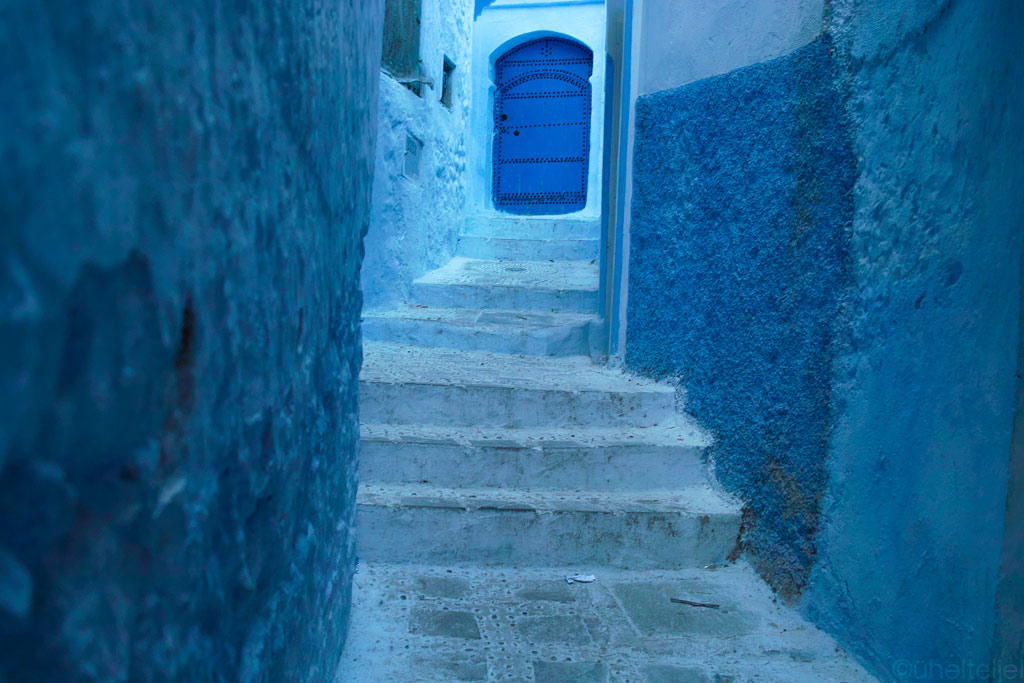
Hypnotizing doorways.
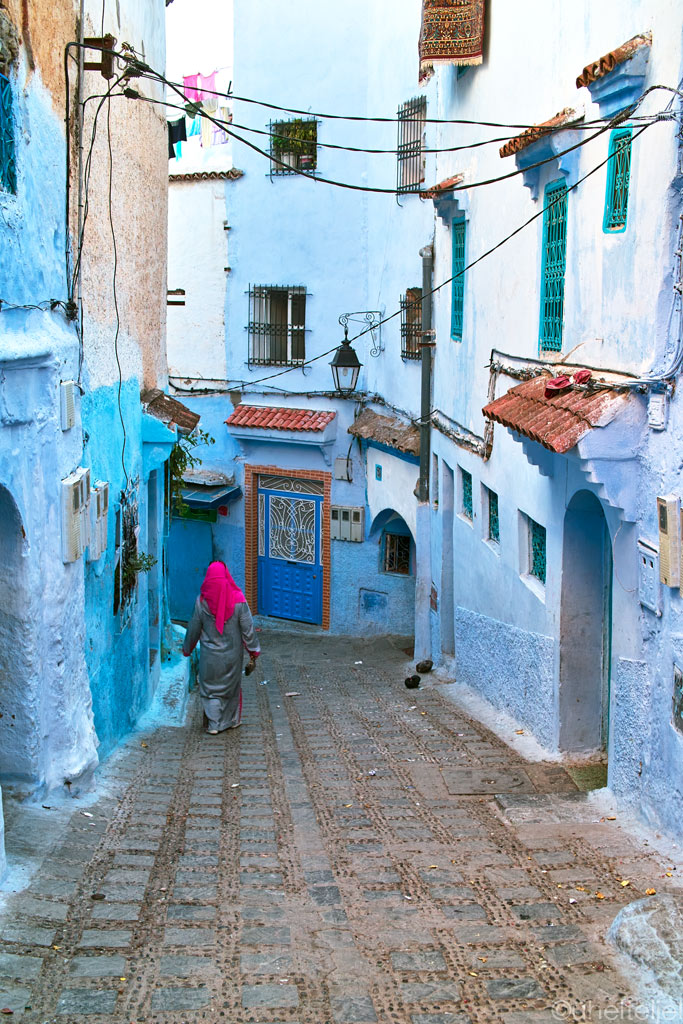
Looks as if the houses were built of marshmallow.
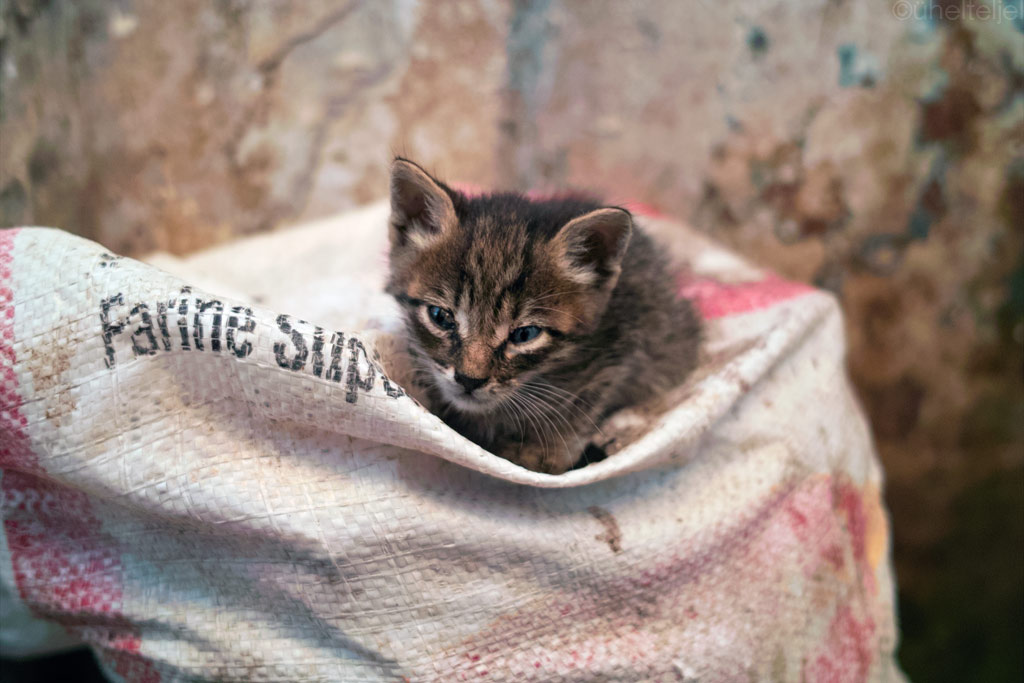
A young kitten on the street with eyes barely open.
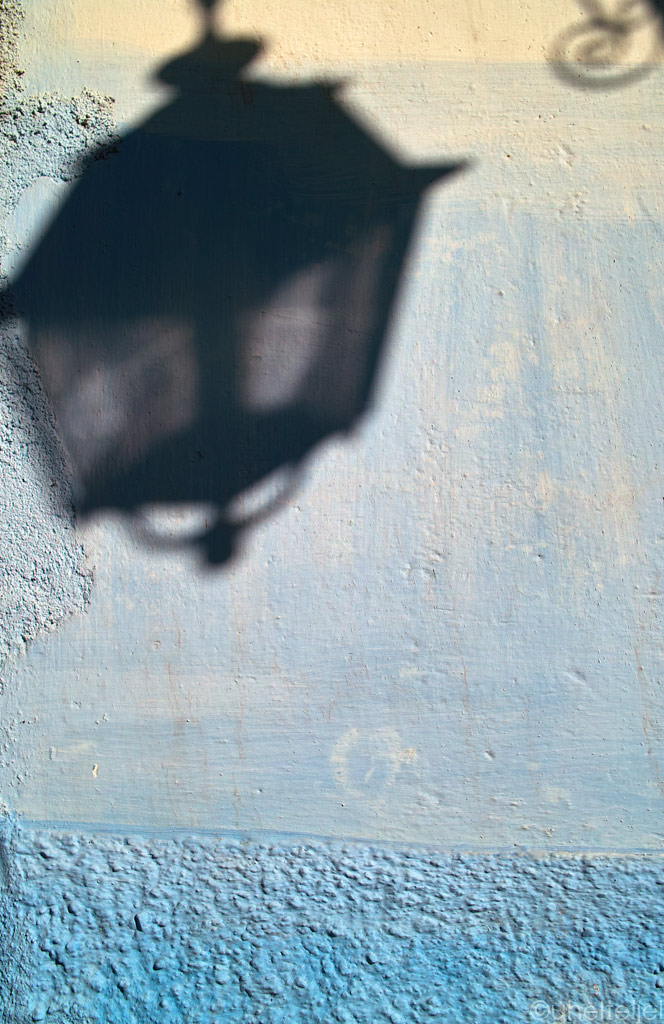
Shadow of a lantern on the pale blue.
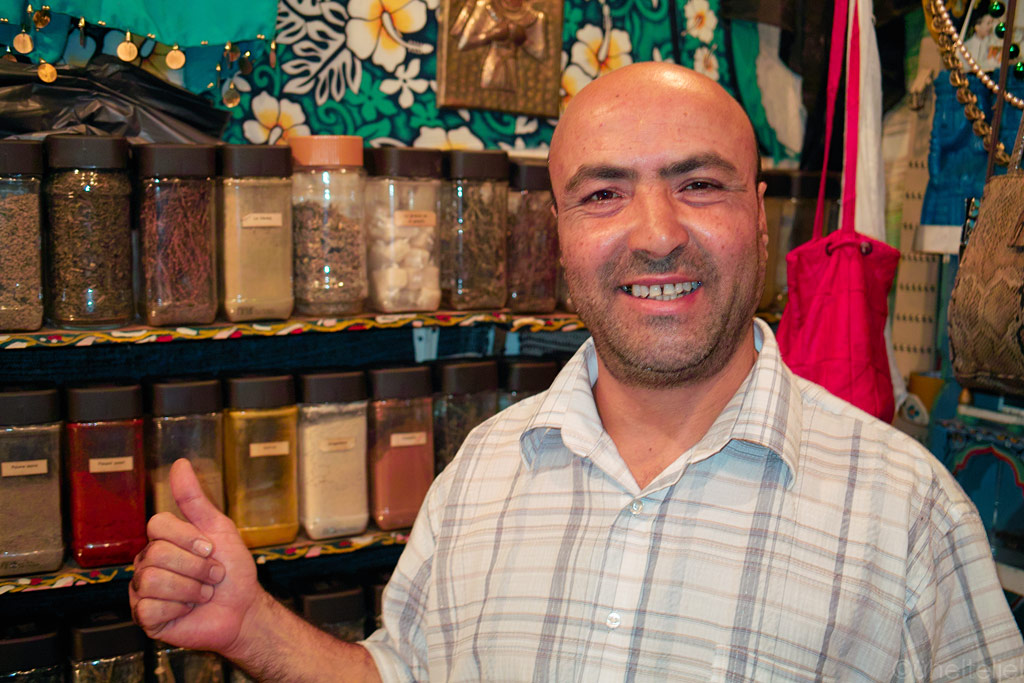
A shopkeeper was happy to show us his spices.
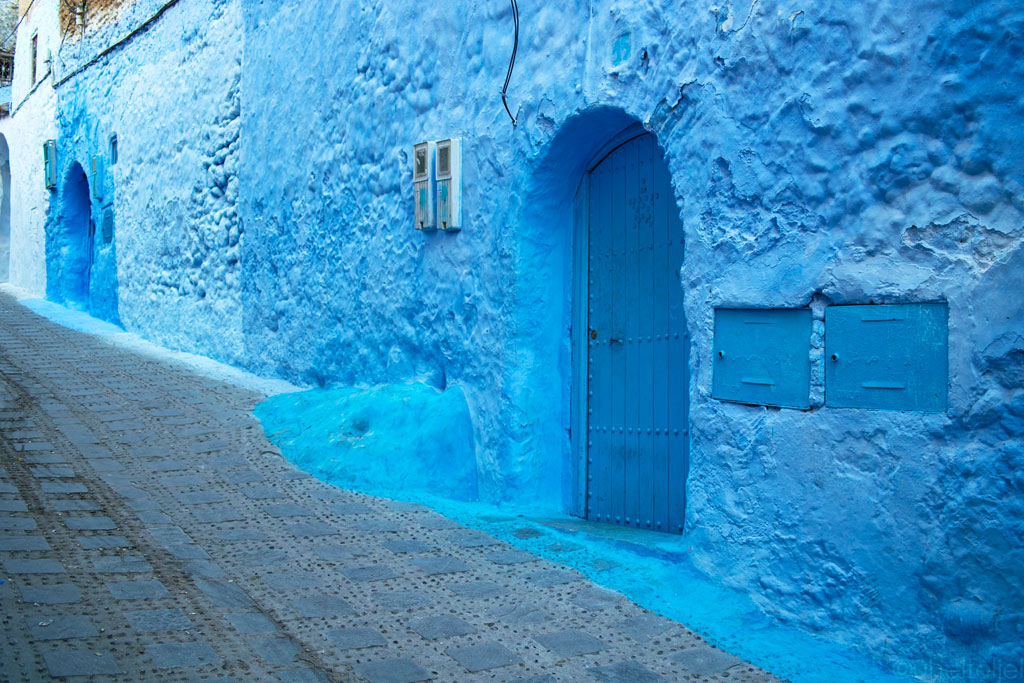
Doorway into someone's home.
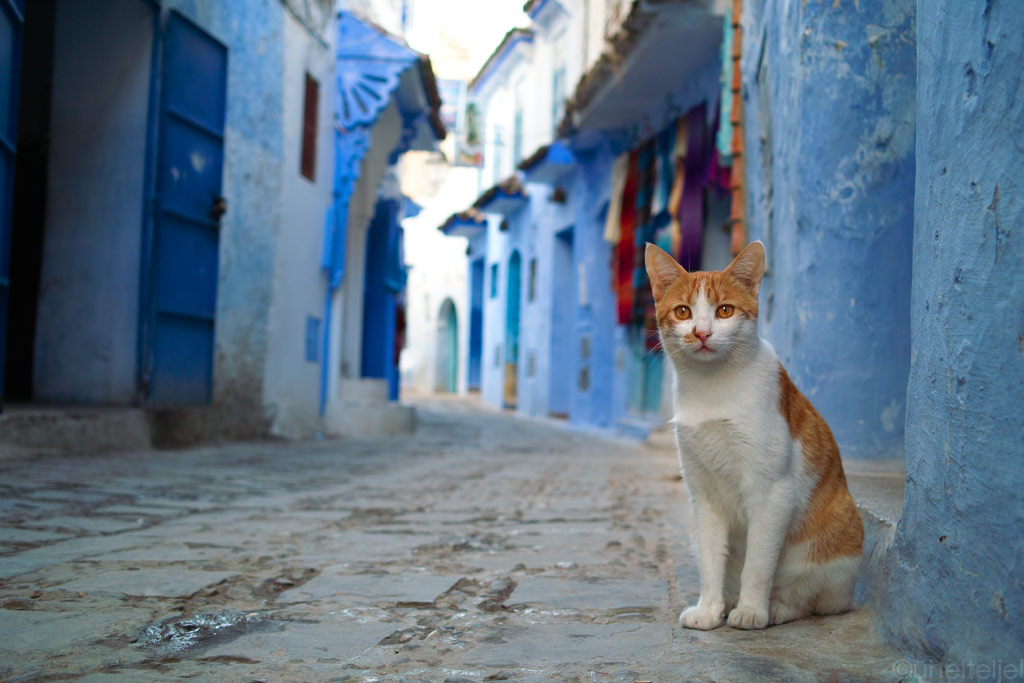
A cat observing the life passing by.
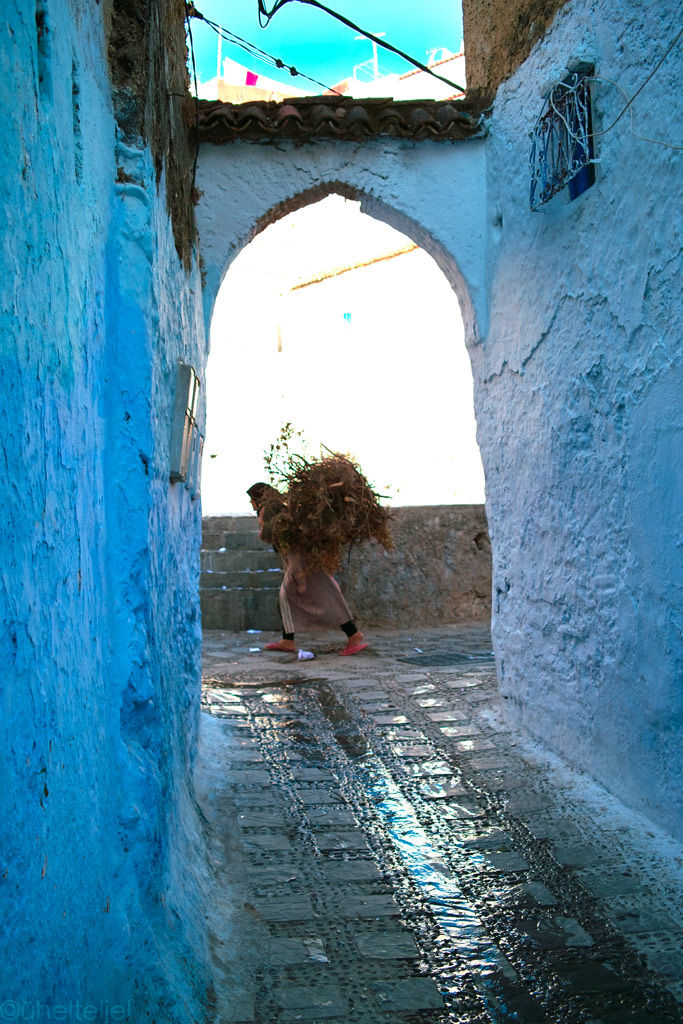
A lady returning from a field.
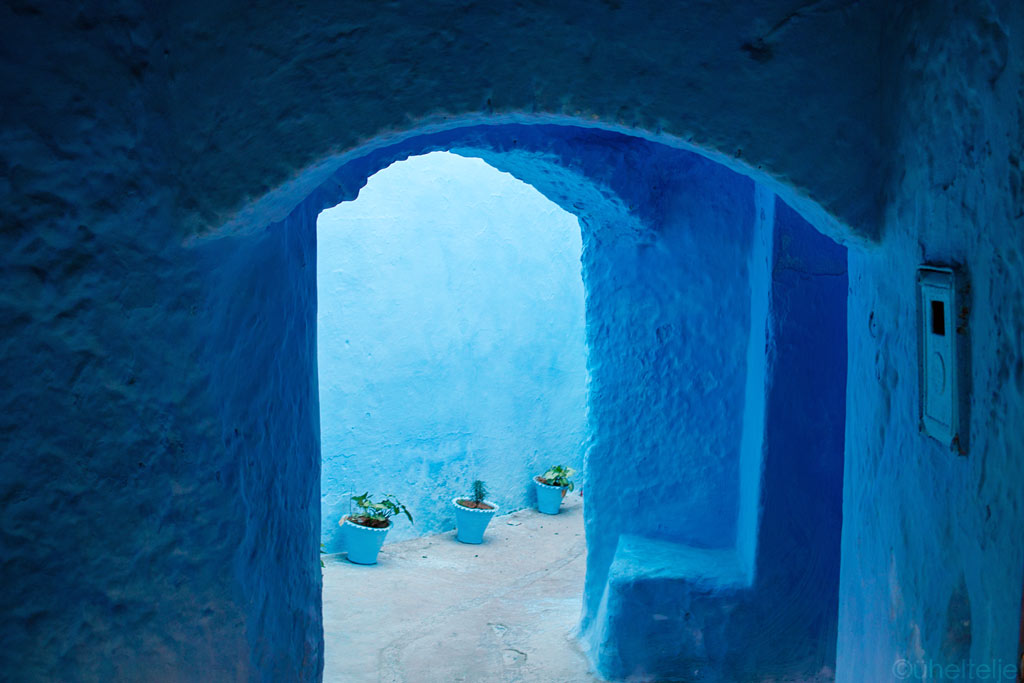
As blue as it gets.
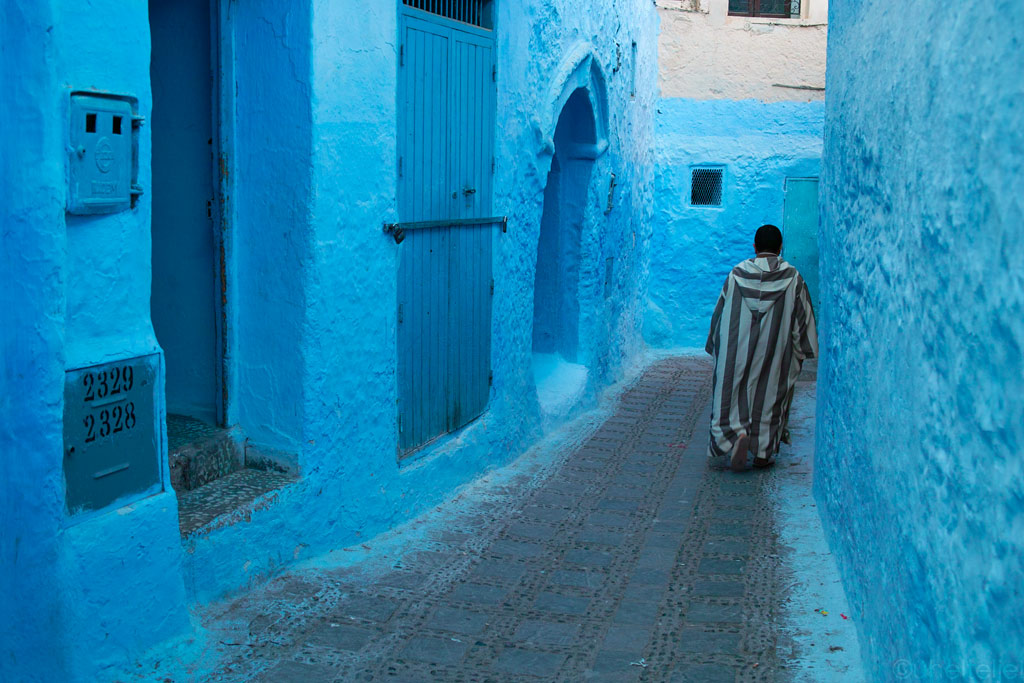
A mullah walking down the street.
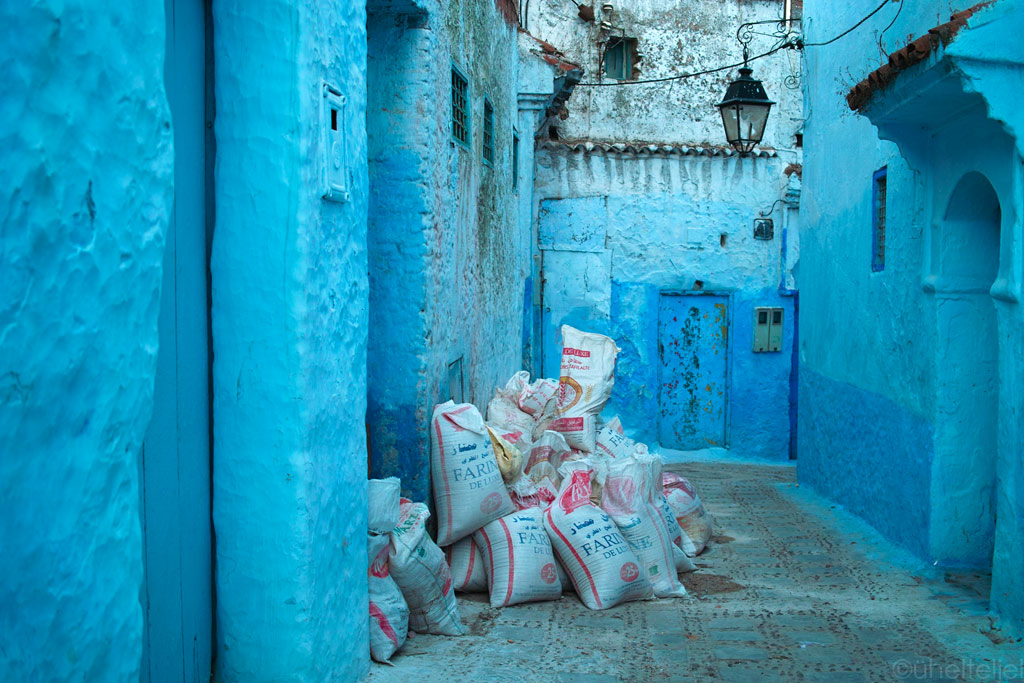
Back yard of a bakery.
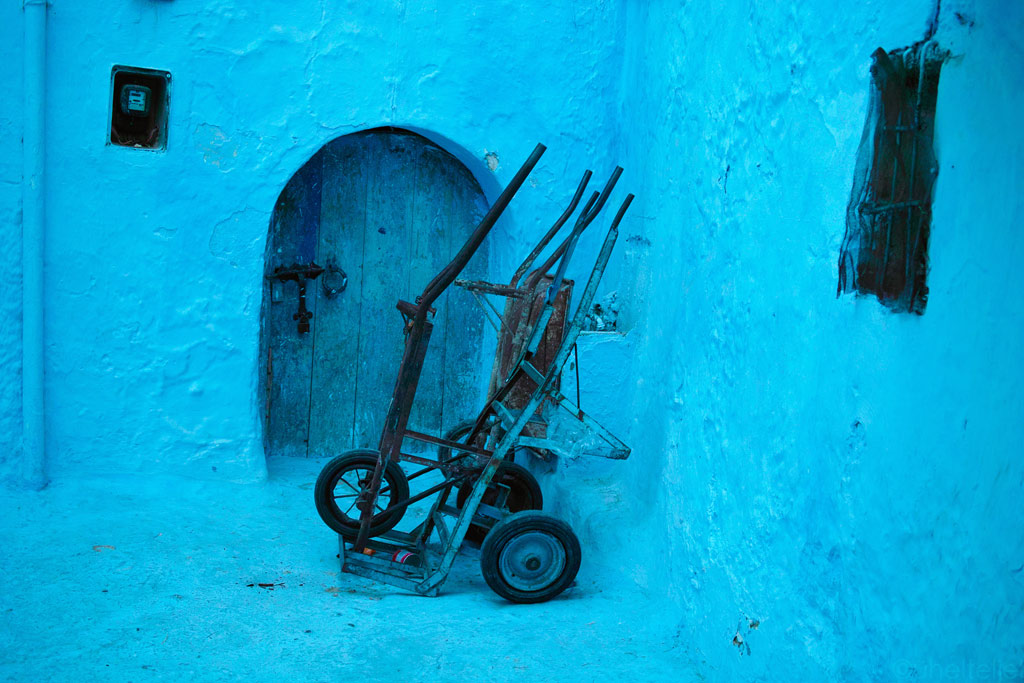
Wheelbarrows in a neon blue courtyard - the blue walls were three storeys high, so the only light below was the reflected light from the (blue) walls.
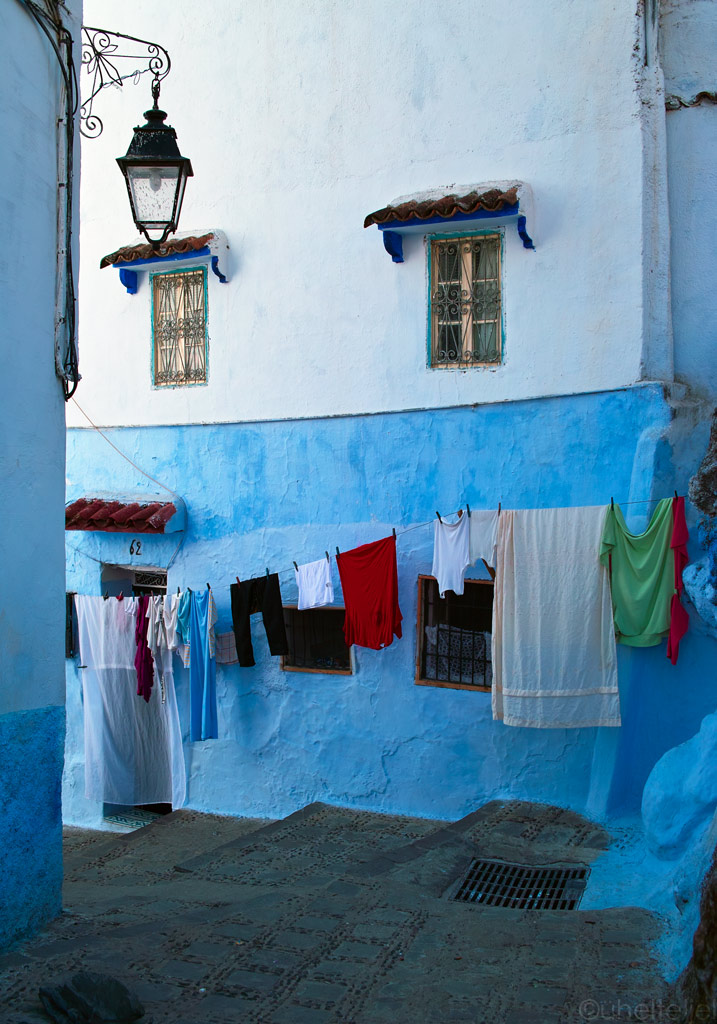
Streets with cozy feel in them...

Chefchaouen just before sunrise (click to enlarge).
After Chefchaouen it was a short ride to Ceuta, the Spanish enclave on the African continent, from where the ferry would take us to Europe. Having bought the tickets, we stood in the queue for the ferry and in our minds we said farewell to the Black Continent. In fact, it felt like the door between us and Africa had closed quite a while ago, at least in the sense we knew Africa - black, wild, with women pounding grain while babies tied to their backs, and men sleeping and cooking under their trucks parked on the roadside (or in a ditch) while waiting for assistance after a breakdown - such common sights. Starting with Mauritania, it had no longer been Africa, but rather Arabia.
As we rolled into the ferry (the real thing, not some rusting passenger boat) we soon realised that half of the crew were Estonians, and after the bike had been (over)secured we were taken to the bridge where we could chat to the captain all the way through the passage across the Gibraltar strait…
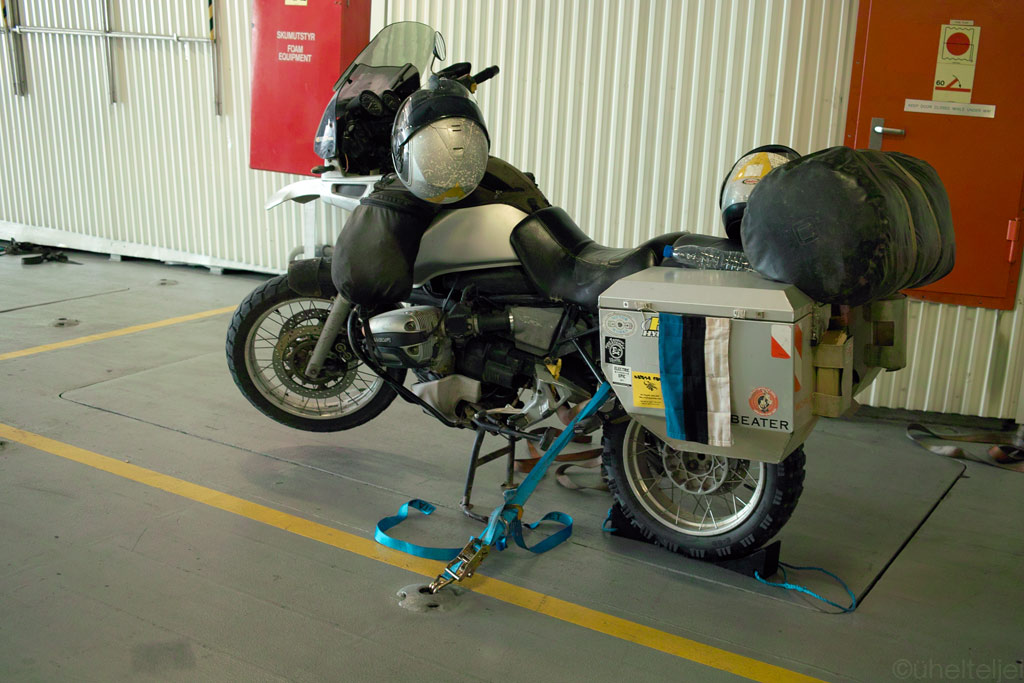
Tied and blocked, no space for error. Welcome to civilized Europe (no-one would do it in Africa, ever!)!!!
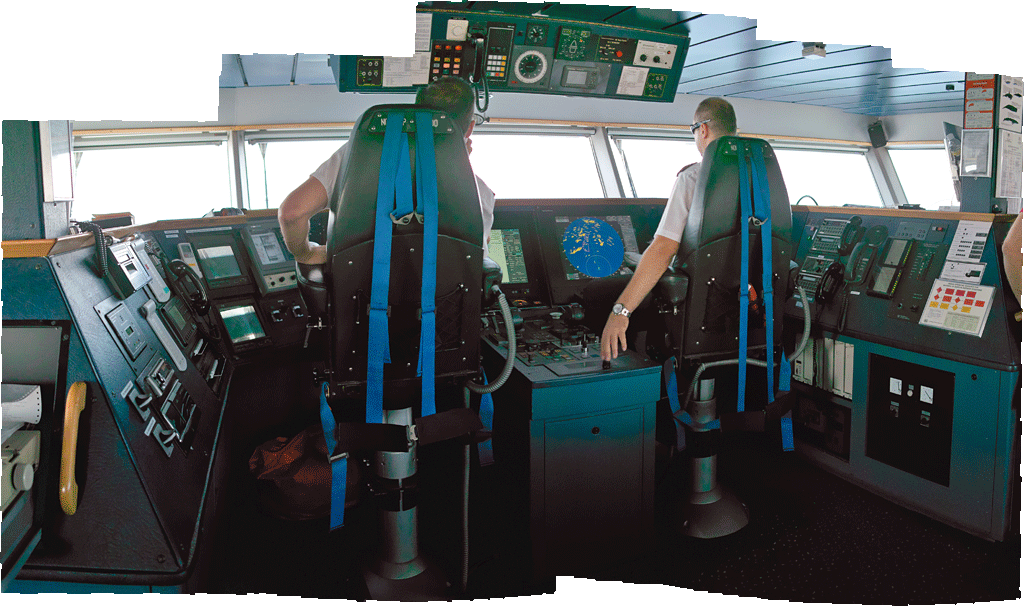
On the bridge.
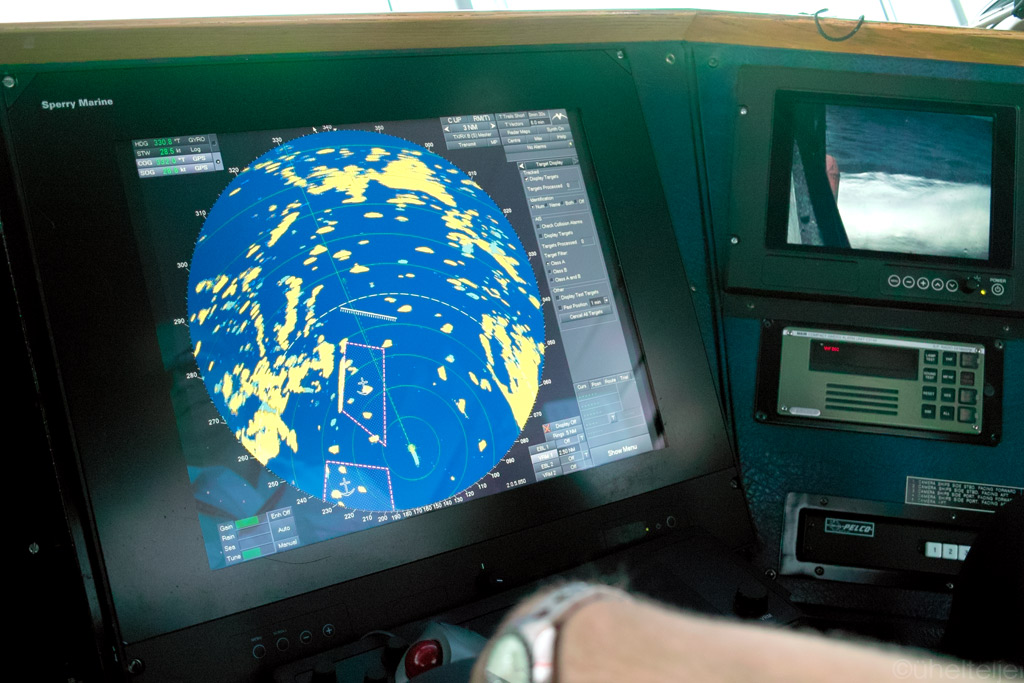
European mountains on the radar - our home continent is close, we haven't been there for over 2 years.
First thing in Europe, we made a quick visit to Gibraltar, rode all the way up to the top of the rock, lit a Cohiba that we'd carried all the way from Angola (a present from Basilio), and sat down to enjoy the view, look back in time. It must be true what they say that if you've spent some time in Africa, it will always stay with you and you'll want to go back…
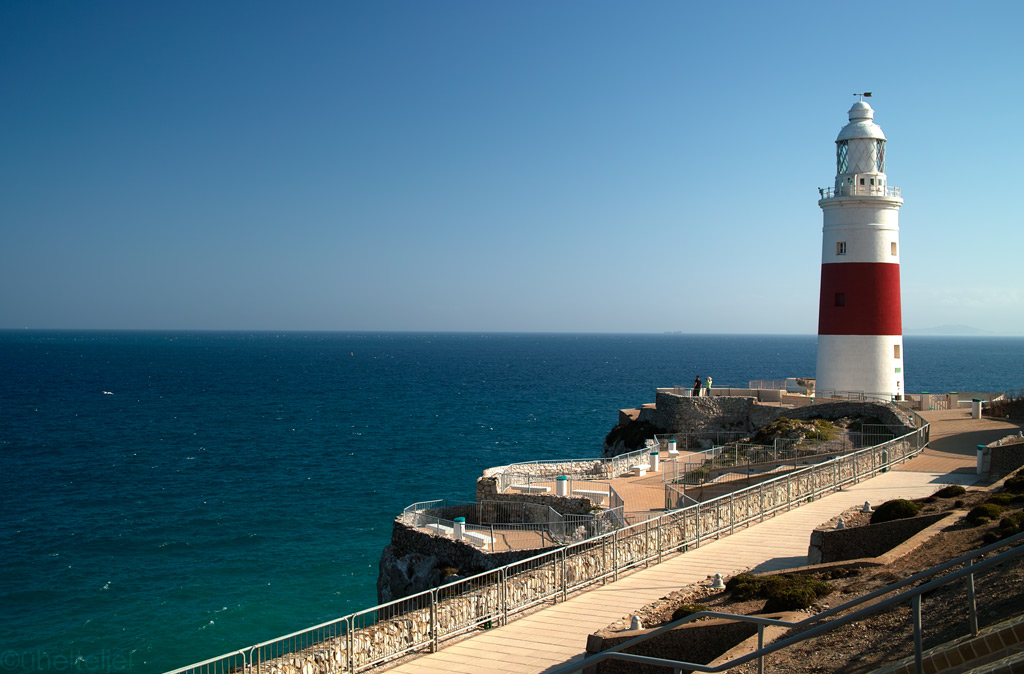
A lighthouse in Gibraltar.

Enjoying the view - for us it was another circle to be closed as we were here first in 2004.
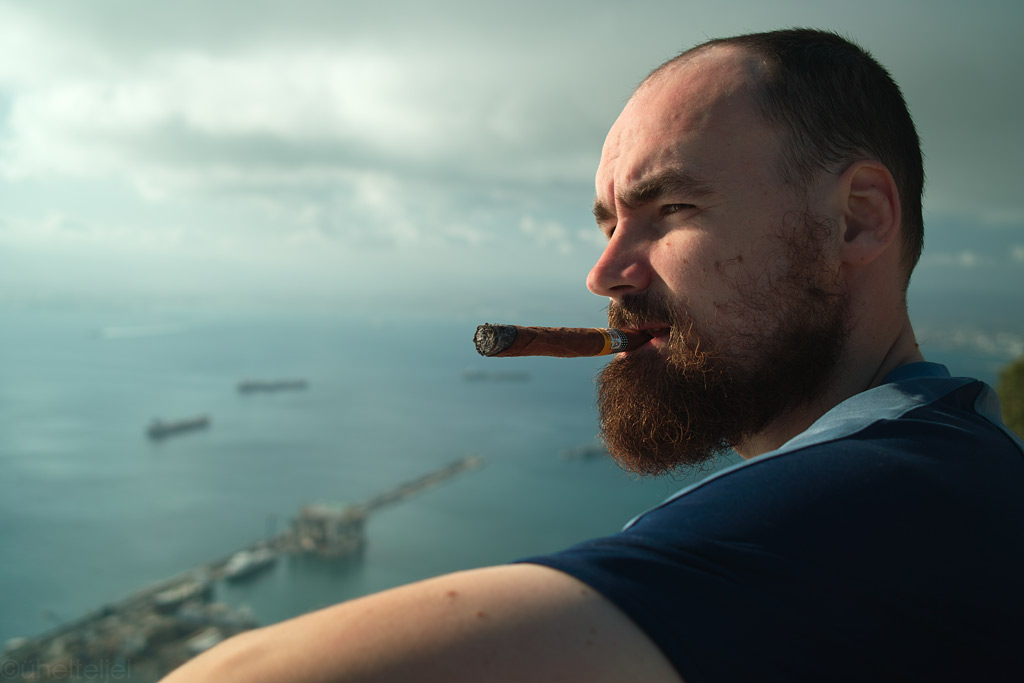
Looking back to the mountains to the Africa from ontop the Gibraltar rock, smoking the sigar that was given by our friend Basilio in Angola. Great nostalgia strikes us looking it all back in retrospect! It's been a pain to travel in Africa, but a rewarding pain.
Thus, Ladies and Gentlemen, we are now officially in close-down mode with our expedition. Maybe there will be some pics from our cold and miserable European leg back to Estonia, but our real adventures are definitely over (unless MCN starts giving work for us ).
).
We take the chance to thank everybody who supported us to make our dream a reality and thus also making this thread possible. Without you we'd had quit already in the beginning of East-Africa, and by just looking how much we've gone through since then is a humbling experience for us.
Thanks a million again,
Margus & Kariina
There is quite a bit of Arabian blood in Mauritanians, and not only is it visible in skin colour and faces, but also in religion and the way of life. The picture of men lying in the shade of a tent, sipping tea all day long while the muezzin sings his call to prayer through crackling of the loudspeakers of the village mosque (or maybe he's just lost his voice to the desert dust), is just so common. But unlike other Arabian nations, such as Oman or the United Arab Emirates, Mauritania is a poor country, and thus it isn't all about the thousand and one nights. Instead, goats roam the rubbish laden streets, and people's mindset feels a lot different - even suppressed. Maybe it is the reason why Al-Qaeda, responsible for a few tourist kidnappings already, has established itself here - isn't it that terrorist organisations manifest their presence the strongest in the countries that struggle with poverty, such as Pakistan or Yemen, for example?
The current travel advice concerning Mauritania suggests that one shouldn't go there unless absolutely necessary (or, for some areas, should not even consider going) - same as for Pakistan and Yemen. Therefore our journey through the country is, as expected, interrupted by countless checkpoints that invariably require us to present a "fiche" - a piece of paper that has all data on it, including our profession, names of our parents, and the registration of our vehicle. I guess it is for our own safety, so that should we disappear between two check points, they at least know where to start looking from. In any case it seems like a more sensible solution than escorting, which they did for a while just after the kidnappings took place, but not anymore. Either way, we'd done wise to prepare a bunch of fiches, because to get from the Mali border to Nouakchott alone we had to distribute some fourty of them (i.e. we passed through some fourty check points).
But the check points weren't the only worry on our way to the Mauritanian capital. Some 500 kilometers before, while we had stopped to take a snap of the landscape (which was quite stunning, by the way), Kariina brought to my attention that there is a smell of transmission oil in the air. A quick inspection revealed that transmission was fine, but the gearbox was leaking, and quite bad. But we were in the middle of nowhere, so we held our breath and somehow, adding some fresh oil bought from a roadside "boutique", we arrived in Nouakchott.







Excellent tar road through Mauritania - something we did not expect.

In the fields of Southern Mauritania.

… and some local food which quite upset our stomachs - the conditions for preserving food are not quite good in the desert...
So, once we got to Nouakchott we had no choice but to take the bike apart in order to determine where all that oil had come from. It wasn't an easy task - not so much taking the bike apart, which we discovered was possible even with nothing more than the original tool kit that comes with the bike, but determining where the oil had come from… The first supect was the gearbox input shaft seal, which would have been an easy problem because to replace it one does not have to take the gearbox apart, and similar seals are also used on certain cars, so should be possible to find in a spare part shop even in Africa.
Full of optimism, we got the old one out, found ourselves a helper who'd take us around town to the relevant shops, and… well, the thing is, that in Nouakchott the "relevant shops" are virtually non-existent, so instead he took us to different mechanics who don't even have proper workshops, working on clients' cars and bikes in their dusty, sandy backyards. We were told that it would be possible to find a new seal, and that it would cost us 30 000 ouguiya - an astronomic price, considering in Europe an original BMW issue would cost five times less. But of course, ordering from Europe entails hefty shipping costs, plus just as hefty import taxes, plus the waiting…. so we decided to give it a go. We bargained the price down to 25 000 ouguiya and were told to wait for the seal to be delivered the same day.
Later that day, the guy came with the seal. It had the same measurements allright, but it had a metal case (not rubber, unlike original), and it was lightly rusty. Apparently it had been lying around somewhere for quite some time, and possibly become somewhat brittle. This is all he could find in whole Nouakchott, the capital of Mauritania, but we were not happy at all, especially for the price. It was too risky, so we decided to undertake ordering from Europe.
Since we were at it, we ordered also the other seals, to be sure, and also the new ABS sensor for the rear wheel that stopped working quite a while ago, and a new swingarm bush to replace the one that keeps eating the suspension bolts - we still have a long way to go.
Ahead was a long wait, because Mauritania is on the list of those countries where even fast shipping takes at least five working days. While waiting, I dismantled the gearbox only to find a bad surprise - when taking out the shafts, four pieces of metal fell out. Apparently, a spacer shim holding a bearing on the input shaft had broken and damaged the rear input shaft seal, and this was the cause of the leak.
I inspected it further and it seems the bearing had failed first by making the friction too hard so it started to rotate around the shaft itself, thus making it loose. Input shaft gets all the beating throuh shifts, engine acceleration/decceleration so the loose bearing killed the spacer shim in two so that it fell on the seal, damaging it.
Bad thing is that is a special type of spacer shim - containing two half circles that are locked together by another "hugging" type of shim. It was the latter broken in two, thus the two half-circles fell off.

Opening up the gearbox.

Broken bits.


Outer part should be in one piece locking together the two inner circles. And all this...

...supposed to be between there in one piece.

Big boys Lego on our hotel room's table.
So the mother of the chain of events was the bearing which is a known weak spot on R1100 "M97" gearboxes. We first replaced it in Australia when the bike had 150 000 kilometers (93 000 miles) - the original NTN beating was "Made in Japan". We managed to find exactly the same NTN product with the same product code which now was "Made in Taiwan" - this is the same one that failed this time with only 100 000 kilometers (62 000 miles). Why the hell does BMW put Asian bearings into their gearboxes!? It should be "Made in Germany"! Maybe then it'd be 200 000+ kilometers per bearing like it should be.
So we had a big mission in Nouakchott - because no way we could find such a special design of a shim, we had to create one from a scratch, with correct measurements and good strength. We found "claimably" the best turner in Nouakchott who took the job and made us one of unknown quality and asked a lot of money for it too. But we had no choice.
Also we needed to find a new bearing - took us a full day to go around the city with a taxi and we only managed to find a "DPI" bearing which is "Made in China". Again, we had no choice. We DO NOT want to know how little this will last with the "downgrade" experience we had since Japan-Taiwan- and now China!

Nouakchott slum girls wanted a picture to be taken of them while we searched for the parts and tools visiting different mechanics' homes.
In Nouakchott's oppressive +42C (+107F and that's in shade!) we did all the work on the bike in our hotel backyard with sand flying around, and rebuilt the gearbox on our hotel room's unstable table - we were amazed how a creative use of tools allowed to do most of the work with BMW's stock toolkit. We only had to borrow a half-inch tool with number 30 to detach the swingarm.

It is strange to think a simple bearing and a broken shim can cause such a pain and 11 days of being stuck. Some call it adventure, well maybe if we think about it in a retrospect, but to live it through in such living and working conditions is just pure pain!
It now feels like we've created a ticking bomb with low quality Chinese bearing and African home brewed spacer shim living in our gearbox. It's a payoff compromise, with no money left to invest into proper repair - there are no guarantees with this repair. We just hope to make it back to Estonia alive, which is some 6000 kilometers away - hopefully the Chinese and the Mauritanian made their bits at least that good.
Here's a video of the work done in hotel room and backyard:
<iframe width="720" height="540" src="http://www.youtube.com/embed/8PBvMnsiJUo?rel=0" frameborder="0" allowfullscreen></iframe>
When I read from somewhere that fish makes up a big part of Mauritania's exports, I was a little bit surprised as most of the country is nothing but desert. But the key here is the several hundred kilometers long coast line, and this is where most of Mauritania's 3+ million people live, and for living - they do fishing, of course.
Thus it is no surprise that Nouakchott's main (if not the only) sight is the fishing port, a few kilometers out of town. There is so much action, with colourful fishing boats coming and going, women carrying the fresh catch with huge plastic bowls on their heads from the boats to the market, merchants in tall rubber boots standing in the stinky water in front of their stalls laden with extraordinarily big fish. Someone is busy with repairing his fishing nets, someone services his boat engine. Kids play in the waves while their mothers sell freshly fried doughnuts in the salty sea air. It looks as if the whole life had concentrated there, and what a life it is!

Action in front of the fish market (click to enlarge).

Pushing a cart to meet the boats coming from the sea.

Everybody is busy.

Hauling a boat on old gas bottles.

It isn't just a few boats, but this view stretches for hundreds of meters.

The fresh catch - must be some sort of rays.

Girls insisted on a photo - but I felt a little odd taking it with some burka-clad old ladies passing by and surely thinking how spoiled the new generation was…

Women carrying the fish to the market.

Using the incoming wave to push the boat into the sea.

A panorama of the life at Nouakchott's fishing port (click to enlarge).
Since there isn't much to see or do in Nouakchott, as soon as we had the bike back in one piece, we zoomed towards the north, to Nouadhibou, the second biggest town in Mauritania located some 500 kilometers from the capital. The ride there was terribly monotonous, with strong winds kicking up the sand as we rode through the vast plains of empty desert. There was nothing there, and even the check points were few, with policemen looking like mummies, their faces wrapped in cloth for protection against the constant "sandblasting".
When we arrived at the coast, leaving behind the +40 C desert, the sea wind welt so invigorating that we found enough energy in ourselves to ride to the southernmost point of Nouadhibou peninsula, where a huge ship wreck is anchored. There are many ship wrecks in the bay, that just like in Luanda, Angola, have been simply dumped there as disposing of an old ship is far too expensive for the ship owners here. The wreck at the tip of Ras Nouadhibou is quite recent, which is obvious because we saw men carrying some hydraulics and other stuff of the ship.
Nouadhibou itself is nothing special - if a better organised place than Nouakchott, with DHL and UPS at hand, and even some workshop-like workshops. Otherwise it is a regular sandy, windy desert town, with hoarse calls to prayers flowing down the low-built streets.
...::: LISTEN Nouadhibou's hoarse mulla propagating islam over windy town :::...

On the way to Cap Blanc in the tip of Nouadhibou peninsula - over funky reddish sand.

At Cap Blanc (click to enlarge all the panoramas)

The ship wreck. Notice a man on the right hauling stuff off the ship.

Picture of the massive shipwreck close up (you can clearly see it even on a sattelite image). And local men are carrying prescious plumbing, metal and other gear away :lol3

It is huge! Pity they don't have a working metal recycling system - someone would make a good money out of it.

On the way back to Nouadhibou, our final stop before the Moroccan border.
After a time-consuming border crossing from Mauritania into Morocco we found ourselves in Western Sahara, a land squeezed between two magnificent forces, the Atlantic Ocean and the greatest desert in the world - Sahara. One ends, other begins, there is no space for compromise - it is either the lifeless sand or the cool waters.
Soon after we crossed into Western Sahara there was a check point where police asked us about our destination. As we said it was Dakhla he admitted, somewhat uncomfortably, that there were "problems". You see, Western Sahara may de facto belong to Morocco, but every now and then the desire for independence bursts out into violent action. Most of the Sahrawis, as they call themselves, cautiously keep their feelings to themselves though, bearing in mind that without the Moroccan government they'd have none of the modern infrastructure that makes them stand out among most of African countries.

Just after the border crossing, the road is wide open in front of us.
Problems in Dakhla meant that we had to think of another place to break the journey through this vast land - which is not so easy as it is extremely sparsely populated, and wild camping is potentially dangerous because of the mines. Some distance before Dakhla, we took our chances at a small track leading off the main road, pointing towards Porto Rico. A rich port, to translate from Spanish (Western Sahara used to belong to Spain), but what we found was nothing more than a tented camp sheltered in an isolated bay, and a lighthouse. There was nobody there, although well kept open-air toilets, showers and even a well-equipped kitchen suggested it was a fully functioning place. No one was there, but nothing was locked, as if trying to say we were welcome.
While going around the camp, trying to decide what to do with this place that at the same time looked abandoned and inviting, we managed to dig the bike into soft sand. But while we were trying to dig it out again, the guard showed up from behind the dunes.

Way to the camp (click to enlarge).

Deceiving surface - looks like fine gravel, but it hides soft sand underneath.
Since the wind was blowing hard on the coast and the ground was nothing but sand we could not have pitched our tent, so we opted to stay in one of the stationary Bedouin tents. It cost more than we would normally spend on accomodation, but we'd never slept in such a tent before, so it ws an experience. It is so quiet inside even though outside the wind may be blowing a gale…

The traditional tent - our home for the night.
We spent the last hours of light walking on the beach, which felt absloutely relaxing and brought peace into our minds that had seen so many worries in the past few weeks. The sea had receded with the low tide, leaving so many hidden treasures for us to see - thousands of sea shells and snails attached to rocks.

Sunset in Western Sahara (click to enlarge).

The Atlantic (click to enlarge).

Underwater life exposed during the low tide.

The ocean going to sleep.

The night was dark by the ocean, and the wind was still blowing hard, but inside the tent it was warm and cosy.

Yes, everything is done in a candle light inside Western-Sahara's traditional tent.
In the morning, the friendly guard prepared us some Sahrawi tea - strong green tea, made on coals, which is poured many times from the kettle into the glasses and then back to form the nice froth. There was a lot of sugar in it (which is supposed to compensate for the bitterness of the tea), but it felt absolutely invigorating and left inside a warm feeling which helped to fight the slight melancholy induced by the cloudy skies. As we left the place we felt as if we were leaving a fairy tale.

Drinking tea in the traditional tent (click to enlarge).

The kettle on hot coals - the true Sahrawi way.

Pouring the hot tea from the kettle into the glasses.

Then from one glass into another, many times tike this - to cool it and to give it "air".

After a lot of effort (some half an hour of handwork!) finally the end product - the bubbly "Sahrawi whisky" (they are mostly Muslims here so they do not consume any alcohol).

Our Sahrawi host.
As we rolled on towards north the landscape didn't vary much but in all its simplicity it looked beautiful.

A picture from the top of the old lighthouse down to the camp (click to enlarge).

The Atlantic in the Western Sahara (click to enlarge).

The road through the deserted land on a good road (click to enlarge).

The desert and the sea (click to enlarge).

Western Saharan landscapes (click to enlarge).

The contrast is stark between the two forces.

Cooking lunch in a small shelter.

A million dollar view to accompany our camp pasta (click to enlarge).
Since we were already on the edge of the Saharan desert it would have been unfair not to go and have a closer look at all that sand. We went to Erg Chebbi, known for its high sand dunes, which are truly spectacular, changing their colour from dusty white to golden yellow and then to smouldering pink while the curvaceous shadows crawl across their sculpted surface as the sun makes its way across the sky.
But to be absolutely honest, it wasn´t so much for the sheer beauty of the sandy expanses that I wanted to go there, as for the last chance to have a go at dune riding. To take off the bags and the panniers and to take advantage of the lightness of the bike. And what a difference it is without all that weight that we normally carry! It felt as if the bike was not even touching the ground, so light it was!
It could have been even better, I guess, with proper tyres, which our more-than-half-worn Metzeler Tourance (100% street tyre) in front and almost-completely-worn out Mitas E-09 at the rear were definitely not. To get some grip, I had to deflate them radically, to around 8-10 PSI, which brought the corner-knobs of the rear tyre into action, providing a little traction in the soft sand - the middle part of the tyre only has one or two millimeters of thread left. Deflation also meant that the front wasn´t trying to find its way through sand too agressively.
So in this bald tyres case, the thing that you cannot really do without in the sand is the momentum, but with the low revving torquey engine that the GS has, it normally isn´t hard to keep it. Just let it "sing" at 3000 to 4000 rpm and it will drag you trough sand like a steam engine, even up the slope. I'd say it's silky smooth traction on those revs in the sand. Rev it too much though, and before you know the bike is dug half way into the sand, so you really have to do it by the feeling and the massive bottom end torque the big boxer GS produces is like a God-sent feature in deep sand. Also, what makes it a little more difficult, is that the dunes here are quite small, so you have to readapt very often, plan your route "on the fly" all the time while not knowing what is expecting you over the edge - some camel grass, soft sand or a steep descent, which is only revealed to you once you make it to that same edge. You cannot go too fast, or you might just fly over the steep edge, possibly into a "bowl" where it is tricky to get out of. But you cannot go too slow either, because if you come to a stop before reaching the edge, you will not be able to get any further, and going down the same way is no fun either. With bigger dunes it is a different story - you can go faster and let the engine rev highly, but there is the risk of becoming too rakish. Once I went too fast, not knowing exactly what was lying ahead, and almost did a salto across the edge. Luckily, no harm was done.
Of course, playing in the sand means that before you know it, there is sand everywhere - throttle, levers, cables, air box, the side sand and the center stand, and it surely does not do good to the bike, but I must say it was enjoyable (maybe less for Kariina who had to follow me with the Sigma on foot through the dunes to take some pics of me riding

Into the dunes...

Started with the easy-peasy flat dunes.

Shadow.

Against the sky.

Boxer ready to conquer some bigger dunes.

Into Erg Chebbi.

Melting in with the surroundings...

Contrasts of Erg Chebbi.

Just having fun in the sand.

Taking some higher dunes.

Let the boxer dig the sand.

Accelerate...

...then slide.

An earthly shower.

Taking this dune failed at first try.

And also at second try - what goes up, must come...

Had to find better grounds, more neutral angles and higher speeds.

And finally up in the high dune, didn't expect to get there with those useless worn tyres.

What a lovely view to the Erg Chebbi.

While the other tourists roamed the dunes on camels...


Moon and Dune.

Panorama from Erg Chebbi dunes (click to enlarge)

Panorama from Erg Chebbi during sunset - you can also see Merzouga village in the horizon (click to enlarge)
To be honest, we were not sure if we wanted to go to Marrakech at all - from what we'd heard, this ancient Moroccan capital (in fact, the country name is derived from the word "marrakech", which in Berber language means the Land of God) was infested by bus tourists and wannabe-hippies in search of hashish. No wonder a bomb exploded in a tourist café on the main square of Marrakech's medina just lately - half a year ago, killing 17 people - it must be painful to watch for the purist locals all those mini skirts and otherwise skimpy clothing that westerners unthinkably wear in this Muslim country.
Strangely enough, our foreign ministry's travel advice does not mention this incident (that clearly had tourists as a target) anymore, and there is no warning for travelling to Morocco, whereas countries like Mauritania or even Burkina Faso remain off-limits. Nothing has happened to a tourist there for a long time, but I guess a dead citizen is a far lesser problem than a kidnapped citizen…
All that taken into account, we were ready to skip Marrakech, but it just happened to be on our way, and we even ended up spending three nights there, wandering the narrow labyrinthine streets of the old medina dominated by the red hues (thus its nickname "the Red City"). We enjoyed the liveliness of the place, which regardless of all the touristiness retains its authenticity and charm, with locals going about their daily lives as if it was a long time ago - the beggar still sits there patiently awaiting for a few coins to drop (and it is mostly the locals that give alms, not foreigners - giving alms is one of the pillars of Islam), the vegetable guy still pushes his cart up and down the streets, the shoemaker still makes shoes, the public bathhouse hammam - is still being heated… The life goes on, and well into the night.

Our bike parked inside the hotel right in the medina, just behind reception desk, away from the curious hands and looks of the busy street outside.

A hammam (arabian sauna) from above.

A panorama of a narrow street in Marrakech (click to enlarge).

Market stalls on the main square (click to enlarge).

Rooftop view of the medina (click to enlarge).

360 degrees of the main square, Djemaa el Fna during the day (click to enlarge).

The souk (market) is just getting started for the day.

"Come and buy a leather jacket"

Fish and chips Morocco style.

Selecting Moroccan street-sweets.

Cheap'n'Superb stuff.

A beggar, patiently waiting before his grandchildren come late in the day, count the money he's earned, sit him in a wheel chair and take the old man home.

The Red City.

… in action.

Ladyes buying fresh stuff.

Arches and a mulla on a scooter.
...::: LISTEN Djema el Fna live musical performances from 6 different local bands :::...

Djemaa el Fna at night with smoke rising from the open-air restaurants (click to enlarge).

Rooftop view at night (click to enlarge).

A street at night.
Before we left Marrakech we got done a mechanical job that was becoming more and more critical - replaced the swingarm bush that keeps the rear suspension in place. Went to a Land Rover workshop which naturally did not have the right tools, but with a little bit of improvisation (that the life in the third world is all about), the local mechanics got the old one out and the new one in. A little bit of peace of mind restored…

Pulling out the old bush by using a self-made puller.

The deformed bush that ate quite a few of bolts on our way from South Africa.
My main interest in Morocco was actually not the sand nor the ancient medinas, but the mountains. The last time we had experienced real mountains was in Lesotho, and it was a long time ago, so I was anxious to explore the curvy roads running though the Atlas mountains.
Although the highest point of the Atlas reaches beyond four thousand meters, the average altitudes are relatively low and in the early autumn - which is the time we visited Morocco - you'd be extremely lucky to see any snow covering the mountain tops. Being one of the oldest mountain chains in the world, the Atlas mountains have a rather quiet charm quite different from that of young mountains such as the Himalayas for example. It feels as if the time passes at a different pace here.
Also, the way the people (mostly Berbers) live here, feels slow and tuned to the surroundings, with mud houses dotting the falleys filled with verdant date palms that snake alongside the rivers.

Trails through the worn landscape.

A hilltop in the shade.

Crumbling into dust.

Mountains in the distance.

Panorama of the Atlas mountains (click to enlarge).

Ruins of an old village above an oasis (click to enlarge).

Crumbling old.

Moroccan landscape close to the Algerian border (click to enlarge)

Fields and palmtrees nestled between the hills (click to enlarge).

Lunar landscape.

Old and lonely (click to enlarge).

Living in tune with the nature (click to enlarge).

Typical view of the landscape in harmony with architecture (click to enlarge).

Date palm plantation snaking in the bottom of the valley (click to enlarge).

A typical mountain village in the Atlas.

Zig-zagging up (or down) the mountain (click to enlarge).

Panorama of the mighty Atlas mountains (click to enlarge).

The Atlas (click to enlarge).

Bottom of a canyon.

A mountain village.

Artwork (click to enlarge).

Countryhouse.

Life in the mountains (click to enlarge).

Oasis (click to enlarge).

Fields in the foreground, Ait Ben Haddou in the back (click to enlarge).
The spectacle coming to an end, Morocco was destined to be the grand finale, and we were eager to take the most of it - to see and do as much as we possibly could before turning the page, returning to Europe. Afterall, crossing the Gibraltar strait would, symbolically speaking, be like standing up from your spectator seat, stretching your legs, going to the wardrobe to retrieve your outerwear and exiting into the elements of the real world, head full of new, unprocessed ideas and emotions.
One thing that Kariina definitely wanted to see while still in Morocco, was one of the best preserved medieval towns in the world - the medina of Fes, but as things go, we've learned not to make definitive plans and not to get our expectations too high, because it is very rare that things actually go according to plans (especially in Africa). I guess what travelling teaches you is that in order to enjoy yourself, you really have to be flexible and adaptive. Thus we tried not to bee excessively disappointed when we arrived in Fes only to find out that the old town was closed to traffic and there was no chance we could park ourselves and the bike in a cheap guesthouse in the medina and go and get lost in the labyrinthine streets just as we had done in Marrakech.
But since we were there, we had to make some sort of a compromise. Instead of aimless wandering we had to carefully select the spots we'd want to see and try to locate them on foot while the bike was parked on the outskirts of the old town. One of such spots was the tanneries - possibly one of the most intense visual and aromatic experiences around, where animal skins are being tanned in huge pots of liquid that gives them different colours, and later dried on the rooftops in the bright sun.
...::: LISTEN local radio playing arabic music :::...

Panorama of Fes from above (click to enlarge).

Closely side by side.

To the left is the tannery, to the right you can see drying animal skins freshly tanned with saffron-based dye (click to enlarge).

The colourpots for life.
From Fes we headed straight north, in the direction of the town by the name of Chefchaouen, known also as the "Blue City" - not sure why, but most of the buildings in the old part of town are painted blue. And not just blue but different hues of blue, so that as you walk in the streets, you really experience different emotions, baby blue houses radiating a sense of security, acid blue walls making you feel as if you were at a nightclub, and faint blue pavement resembling the sky. Unfortunately I must say that the pictures do not quite capture this extraordinary experience.

The town of Chefchaouen from above (click to enlarge).

A street of Chefchaouen.

Hypnotizing doorways.

Looks as if the houses were built of marshmallow.

A young kitten on the street with eyes barely open.

Shadow of a lantern on the pale blue.

A shopkeeper was happy to show us his spices.

Doorway into someone's home.

A cat observing the life passing by.

A lady returning from a field.

As blue as it gets.

A mullah walking down the street.

Back yard of a bakery.

Wheelbarrows in a neon blue courtyard - the blue walls were three storeys high, so the only light below was the reflected light from the (blue) walls.

Streets with cozy feel in them...

Chefchaouen just before sunrise (click to enlarge).
After Chefchaouen it was a short ride to Ceuta, the Spanish enclave on the African continent, from where the ferry would take us to Europe. Having bought the tickets, we stood in the queue for the ferry and in our minds we said farewell to the Black Continent. In fact, it felt like the door between us and Africa had closed quite a while ago, at least in the sense we knew Africa - black, wild, with women pounding grain while babies tied to their backs, and men sleeping and cooking under their trucks parked on the roadside (or in a ditch) while waiting for assistance after a breakdown - such common sights. Starting with Mauritania, it had no longer been Africa, but rather Arabia.
As we rolled into the ferry (the real thing, not some rusting passenger boat) we soon realised that half of the crew were Estonians, and after the bike had been (over)secured we were taken to the bridge where we could chat to the captain all the way through the passage across the Gibraltar strait…

Tied and blocked, no space for error. Welcome to civilized Europe (no-one would do it in Africa, ever!)!!!

On the bridge.

European mountains on the radar - our home continent is close, we haven't been there for over 2 years.
First thing in Europe, we made a quick visit to Gibraltar, rode all the way up to the top of the rock, lit a Cohiba that we'd carried all the way from Angola (a present from Basilio), and sat down to enjoy the view, look back in time. It must be true what they say that if you've spent some time in Africa, it will always stay with you and you'll want to go back…

A lighthouse in Gibraltar.

Enjoying the view - for us it was another circle to be closed as we were here first in 2004.

Looking back to the mountains to the Africa from ontop the Gibraltar rock, smoking the sigar that was given by our friend Basilio in Angola. Great nostalgia strikes us looking it all back in retrospect! It's been a pain to travel in Africa, but a rewarding pain.
Thus, Ladies and Gentlemen, we are now officially in close-down mode with our expedition. Maybe there will be some pics from our cold and miserable European leg back to Estonia, but our real adventures are definitely over (unless MCN starts giving work for us
 ).
).We take the chance to thank everybody who supported us to make our dream a reality and thus also making this thread possible. Without you we'd had quit already in the beginning of East-Africa, and by just looking how much we've gone through since then is a humbling experience for us.

Thanks a million again,
Margus & Kariina













